The 12 Best Cameras for Travel Photography in 2024
A Post By: Matt Murray

This article was updated in February 2024 with contributions from Matt Murray and Jaymes Dempsey.
Need a top-notch travel camera so you can capture gorgeous photos of your next adventure? You’ve come to the right place.
Picking the best camera for travel photography can be hard work, considering the array of options on the market. Fortunately, I’ve spent decades traveling with dozens of cameras (film, instant, and digital), and below, I share my top 12 favorite models.
Note that I’ve offered a variety of choices, including models for beginners, professionals, and everyone in between – as well as cameras at every price point, from affordable point-and-shoot models all the way up to pro-level full-frame cameras. (In other words: No matter your requirements, we’ve got you covered!)
So if you’re ready to find the perfect camera, then let’s dive right in, starting with our top choice:

1. Sony a7C II

The original a7C was an excellent travel photography camera in its own right, thanks to the full-frame sensor and compact body – but the Sony a7C II , which debuted in the fall of 2023, is even better than its predecessor.
Sony’s latest full-frame offering is an all-around great camera, but travel photographers in particular will appreciate the extremely compact body combined with the impressive 33 MP full-frame sensor. Expect outstanding low-light capabilities for interior architecture and nighttime street shots as well as amazing autofocus performance when capturing travel portraits and action scenes. Plus, if you like to do a mix of photo and video shooting while exploring distant countries, you’ll love the beautiful 4K/60p video.
The in-body image stabilization ensures sharper handheld shots when working at slower shutter speeds, such as when shooting at restaurants and in churches (where tripod use is often restricted), and the camera also includes access to a tremendous line of travel photography lenses. My biggest gripe is the lower-resolution electronic viewfinder, which is on par with the old a7C as well as the Sony a7 III. But it’s still highly usable, and for serious travel shooters looking for top-notch image quality in a compact body, the a7C II is a stellar pick.
- Ultra-compact body
- Excellent 33 MP full-frame sensor
- Amazing low-light performance
- In-body image stabilization
- 2.36M-dot electronic viewfinder
- Somewhat pricey
2. Nikon Z fc

Looking for solid image quality in a portable, easy-to-use camera? Then check out the Nikon Z fc , which offers plenty of handy features, not to mention a retro-style, streamlined camera body.
The Z fc boasts a high-quality APS-C sensor , so you’ll have no problem capturing beautiful images of landscapes, cities, and any other subject you might encounter on your travels – yet the camera is relatively small and inconspicuous, so you won’t need to worry when photographing in busy areas or carrying the camera for long hours on buses, planes, or trains.
The film-type dials on the top of the camera promise a tactile shooting experience, and the articulating screen makes it easy to capture photos and videos of all kinds. Speaking of video, the Z fc does offer 4K recording, so if you also like to vlog or shoot cinema-type footage while traveling, you’ll be thoroughly impressed by the results.
And did I mention that you can grab the Z fc for under $1000? In other words, it’s a great option for travel photographers on a budget!
- Great image quality
- Reasonable price
- Beautiful design
- Retro style doesn’t suit all photographers
- Not as small as point-and-shoot options
3. Fujifilm X-T30 II

The X-T30 II is the latest model in Fujifilm’s midrange APS-C lineup, which successfully packs high-level features into smaller, lighter bodies. The X-T30 II boasts a capable 26-megapixel APS-C sensor (so you won’t struggle to capture printable images even in low-light scenarios), and it can shoot up to a whopping 30 frames per second (so you don’t need to worry about capturing those split-second moments on your travels). Like other Fujifilm cameras, the X-T30 II has face- and eye-detection autofocus, which is a big help for travel portraits and street shots . It also includes Fujifilm’s renowned film simulations .
When you buy into the Fujifilm system, you’ll gain access to dozens of great travel photography lenses ; in fact, the hard part is actually deciding which is right for you! My personal go-to lens for travel photography is the XF 18-55mm f/2.8-4 lens . While the X-T30 II doesn’t include in-body image stabilization, the technology is included in several of Fujifilm’s best travel lenses, so as long as you choose your lenses carefully, you won’t have problems handholding indoors or at night.
The X-T30 II offers a uniquely tactile shooting experience thanks to a shutter speed and exposure compensation dial, so if you’re a fan of film-camera ergonomics, this camera will make you feel especially at home. It offers surprisingly great value, too; at the time of writing, you’ll pay just $900 for the camera body (though you will need to buy a lens separately).
- Excellent lens lineup from the affordable XC lenses to enthusiast and professional XF lenses
- Stunning image quality with a range of JPEG film simulations
- Many amazing features
- Not as robust as Fujifilm’s higher-end models
4. Sony RX100 VII

Sony keeps improving the RX100 line, and the RX100 VII is its best model yet. It may have a smaller sensor than the Nikon Z fc featured above, but the RX100 VII is still a powerful performer. It boasts impressive autofocus, a flip-screen for vlogging and selfies, a mic socket, and a huge zoom range (equivalent to 24-200mm in full-frame terms).
The RX100 VII also borrows tech from Sony’s flagship models, which is why it can shoot up to 20 frames per second with no viewfinder blackout.
If you’re a watersports fan, there’s an added bonus: the RX100 has underwater housing available for surfing, diving, and snorkeling photos. At around $1300 USD, the RX100 VII is on the pricier side, but for serious travel photographers, it’s an excellent choice.
- Impressive autofocus
- Handy zoom range
- Up to 20 frames-per-second shooting
- Expensive for a compact camera
- Smaller 1-inch sensor
5. Olympus OM-D E-M10 Mark IV

Olympus may not be the world’s most popular camera brand, but that’s okay – especially if the company continues to develop outstanding models like the OM-D E-M10 Mark IV .
In many ways, the E-M10 Mark IV is an ideal travel photography camera. It offers amazing image quality – thanks to a 20 MP Four-Thirds sensor – yet it’s remarkably compact, so you can literally slip it in your pocket or handbag while traveling and only pull it out as needed. And the lenses are designed with portability in mind, too; a perfect choice for a lightweight setup is the 14-42mm EZ lens , though if you want more range, take a look at the 14-150mm .
Other features include a tilting 3-inch screen (so you can capture low-angle shots as desired), a 2.36M-dot electronic viewfinder (for a DSLR-like shooting experience), and in-body image stabilization (so you can work handheld even in low-light travel scenarios). Plus, the price is incredible; you can grab the E-M10 Mark IV for just $700, and if you want to add a capable kit lens, you’ll pay just $799. How’s that for a bargain travel camera?
- Compact and light
- Excellent image quality
- Good range of lenses
- Smaller sensor
- Lower-resolution EVF
6. Sony a7 IV

If you’re an advanced travel photographer in need of a do-everything camera, consider the Sony a7 IV , a full-frame, pro-level model that combines incredible autofocusing, beautiful image quality, and capable video into one reasonably priced package.
The a7 IV isn’t designed specifically for travel, so while it’s not big , it’s not especially compact, either. But you can comfortably travel with it in a backpack or even around your neck, and for serious shooters, the bevy of top-notch features will make up for the extra bulk.
The a7 IV’s incredible sensor and in-body image stabilization allow you to capture sharp handheld photos indoors (e.g., at museums and churches) and at night. And thanks to the 3.68M-dot electronic viewfinder, you can expect a lifelike shooting experience (along with other cool perks like exposure simulation), while the fully articulating screen makes it easy to create unique low- and high-angle shots of popular landmarks. Finally, the 4K/60p recording capabilities make the camera a top option for hybrid shooters; you can vlog, shoot video, and capture beautiful images all on the same day.
- Astonishingly good image quality
- Great video features
- Fully articulating screen
- Beautiful EVF
- Pricey compared to other models on this list
- Larger than other options
7. Nikon D5600

This next model needs no introduction; Nikon SLRs were favored by many famous travel photographers in the 1980s and beyond. The D5600 is the latest camera in Nikon’s midrange APS-C series, and it’s a perfect choice for beginners and enthusiast photographers alike.
The D5600 boasts Nikon’s excellent ergonomics, and the camera feels reassuringly comfortable in your hand, although it’s not as compact as other models on this list. Image quality is superb and low-light shooting is very impressive. Plus, you get a fully articulating screen (for selfies, vlogging, and tough compositions) along with excellent battery life.
These days, you can purchase a new D5600 for a great price, and it’s even cheaper if you buy it used – so if you’re in need of a reasonably high-level camera with a bargain price tag, it’s definitely a model worth checking out.
- Good ergonomics and handling
- Good battery life
- No 4K video
- On the larger side
8. Ricoh GR III

Ricoh has been producing super-compact GR cameras since the film heydays of the late 1990s. Those classic point-and-shoot GR models were known for their sharp wide-angle lenses and minimalist controls, and the digital line of GR cameras is no different.
The Ricoh GR III is a perfect mix of portability, optical quality, and impressive features. You get a fixed 28mm full-frame equivalent f/2.8 lens capable of producing great images, and four-stop shake reduction that ensures sharp files even in challenging light.
The GR III is often compared to another camera in this list, the Fujifilm X100V, but I’d encourage you to grab the Ricoh if you prefer a smaller camera with a wider angle of view.
- Truly pocketable
- Four-stop shake reduction
- Fantastic wide-angle lens
- The straight-out-of-camera JPEGs are not as good as Fujifilm’s
- Battery life could be better
9. Sony a6700

It’s easy to see why Sony has grabbed a big share of the mirrorless camera market in recent years: The company produces an impressive range of cameras that appeal to professionals and enthusiasts alike.
The Sony a6700 may not have a full-frame sensor like some of its stablemates, but its compact body and impressive specs make it a strong candidate for the best enthusiast travel photography camera on the market. The a6700 features a 26-megapixel APS-C sensor, outstanding autofocusing for photography and video, and five-axis optical image stabilization. The 180-degree flip screen also makes the a6700 handy for vlogging and selfies.
And speaking of vlogging and video: While the a6700’s predecessor, the a6600, only offered 4K/30p, the a6700 now offers 4K/60p and can even capture 4K/120p video (albeit with a heavy crop) for those epic slow-motion travel clips!
I do think the layout and controls could be improved, but it’s one of the only drawbacks to an otherwise excellent product. Quick note: If you like the look of the a6700 but you’re on a tighter budget, also consider the a6400 . It may not be as impressive as the a6700, but it offers excellent value for money.
- Small and light
- Great lens lineup
- Good image quality
- Handling and ergonomics could be improved
10. Olympus Tough TG-6

Going on an extreme adventure? The Olympus Tough TG-6 could be the best travel camera for you. This compact point-and-shoot model can withstand a lot of punishment, thanks to its shockproof, dustproof, and crushproof body.
The TG-6 can also work in temperatures as low as 14 degrees Fahrenheit (-10 degrees Celsius), and it’s fogproof, even during sudden changes in temperature. As I found out on a recent trip to Indonesia – where I was frequently moving from an air-conditioned hotel room to the outside heat and humidity – a foggy camera can be a real inconvenience.
For snorkeling and diving fans, the Tough TG-6 will love being underwater almost as much as you. It’s waterproof up to 49 ft (15 m), and it boasts several nifty underwater modes, including a microscope mode that can focus on objects 0.39 in (1 cm) away.
- Super tough
- Only 12 megapixels
- More suited to adventurers than enthusiast photographers
11. Fujifilm X100V

I’m a huge fan of the Fujifilm X100 series cameras (I’ve owned three of the five models released over the last decade). In fact, many photographers loyal to other brands buy an X100-series camera as their “take-everywhere” body.
The X100V is small and light, yet it boasts an incredible 35mm f/2 fixed lens. Other useful features include its leaf shutter (good for photographing in quieter places like museums and churches ) as well as a built-in neutral density filter (perfect for beautiful long-exposure landscapes and wide-aperture shots in bright light). And of course, you get a range of stunning JPEG film simulations that are ready to go as soon as you turn on the camera.
While the entire X100 series is great, note that the latest model, the X100V, does have an important improvement over its predecessors: it’s weather-resistant. This makes it an excellent choice for photographers who shoot in sand, rain, snow, and more.
- Excellent lens
- Built-in ND filter
- Fujifilm JPEGs
- Weather-resistant
- No in-body image stabilization
- More expensive than its predecessors
12. Canon PowerShot G1 X Mark III

The Canon PowerShot G1 X Mark III is the third iteration of a popular point-and-shoot series from Canon. It’s sleek, it’s stylish, and it almost looks like a mini DSLR.
Many compact cameras have a tiny sensor – one inch or smaller – but the G1 X Mark III is an exception; it boasts an impressive APS-C sensor, which is one of the biggest sensors offered in such a portable camera. It also features a handy zoom range of 24-72mm and an optical stabilizer for shooting in low light, so you’ll be ready to handle any travel photo scenario you encounter.
The G1 X Mark III is easy to use and produces images with high clarity and outstanding colors. The only downside is the price tag: At around $1000 USD, it may be on the high end for some enthusiast photographers, but for intermediate shooters, it’s certainly worth the extra cash.
- Large APS-C sensor
- Compact size
- Articulating screen
- Premium price
What is the best camera for travel photography?
Choosing the perfect travel photography camera is a difficult task, one that depends on many factors. Before you hit that “Buy” button, try to determine what you value most, then evaluate the different cameras I’ve discussed based on those criteria.
So what is the best camera for travel photography? Only you can answer that question! Read my list carefully, think about what matters to you – and, if you’re still struggling, go to a camera shop, where you can talk to the staff and hold each camera in your hands.
Then, when you’re ready, grab a camera and hit the road!
Now over to you:
What travel photography camera do you plan to buy? Share your thoughts in the comments below!

Read more from our Cameras & Equipment category
Matt Murray is a travel, portrait and stock photographer from Brisbane, Australia. Matt publishes Fujifilm X-series body reviews, lens reviews and photo galleries on his website Matt Loves Fuji . Matt also hosts an analogue photography podcast Matt Loves Cameras featuring reviews of classic film and instant cameras.

- Guaranteed for 2 full months
- Pay by PayPal or Credit Card
- Instant Digital Download

- All our best articles for the week
- Fun photographic challenges
- Special offers and discounts

The best travel camera for 2024: the finest choices for your adventures
The best travel cameras for your next big trip
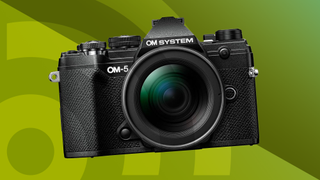
- 1. Best overall
- 2. Best travel compact
- 3. Best-looking
- 4. Best action cam
- 5. Best tough camera
- 6. Best premium compact
- 7. Best small full-frame
- 8. Best hybrid vlogger
- 9. Best for moving subjects
- 10. Best superzoom
- How to choose
- How we test
We’re often asked what is the best travel camera. The answer depends on what you plan to do with it: a city break is best shot with something small and sharp, while adventurous travels demand something more rugged. That’s why this list is so diverse. Down below you'll find everything from premium compacts to action cameras and mirrorless hybrids, all of which are great travel cameras in their own way.
After countless hours on the road, our favorite travel camera is the OM System OM-5. Thanks to a Micro Four Thirds sensor, it's usefully portable yet captures better images than a smartphone. It’s also weatherproof and offers the flexibility to swap lenses. That said, we know it won't be the right choice for every traveller.
We don't pick our top travel cameras on specs alone. We've tested them all out in the real world, to check factors such as handling, image stabilization and image quality. The idea of this guide is to give you an in-depth summary of our findings, to help make it easier for you to choose your ideal travel camera. If compact size is your number one criteria, it's also worth checking out our best compact cameras guide.
Top 3 picks
If you don’t have time to read our full list of the best travel cameras, you can use this summary for a quick overview of the top options for your needs and budget. When you find one that takes your fancy, use the links to jump to our full write-up.

The best travel camera overall
Squeezing a host of features into a compact, weatherproof body that’s compatible with a range of lenses, the OM-5 is the ideal travel camera.
Read more below

The best compact travel camera
If you want a camera that slips in your pocket but has smartphone-beating image quality, then the GR IIIx is well worth a look.
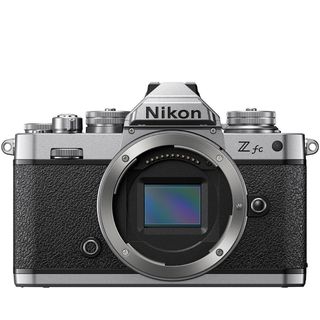
The best-looking travel camera
Don’t be fooled by its lovely retro looks: the Nikon Z fc is every bit the modern travel camera, with a useful touchscreen and top image quality.
Best by use-case
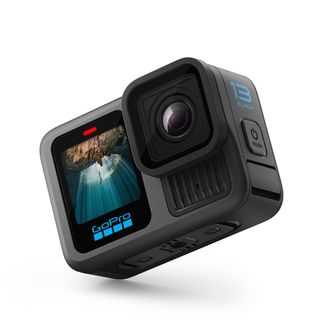
The best action camera for travel
With superlative stabilization, versatile 8:7 sensor for sharing videos to social, and new auto-detected Lens Mods, this is the best action camera for capturing intrepid travels.
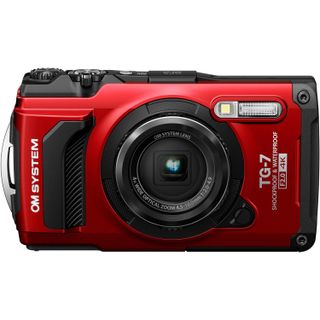
The best tough travel camera
When travels get tough, you need a camera that can keep up – which is where the rugged TG-7 comes into its own, with a hardcore build and simple interface.

The best premium compact
With a large sensor, 23mm focal length and small form factor, the X100VI is a powerful tool for street photography on your travels.

The best small full-frame camera
Combining a small form factor with a high-res 61MP sensor and fantastic autofocus, the Sony A7C R is the best full-frame camera for travel photography.

The best hybrid for travel vlogging
A capable sensor and automated settings, including a Vlogging mode, make the Fujifilm X-S20 an accessible tool for stills and video on the go.
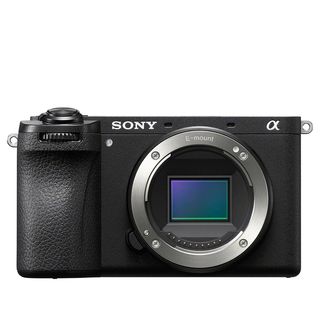
The best for moving subjects
The compact A6700 uses AI-powered autofocus to reliably snap on to animals, insects, cars and more. The Fuji X-S20 is better for video, though.
Load the next product...
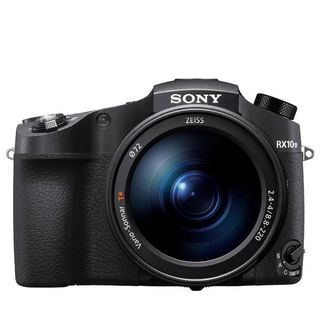
The best superzoom camera
Even with a 1-inch sensor, the Sony RX10 IV delivers sharp stills and video, with the added versatility of a generous 24-600mm zoom range.
Tim is TechRadar's Cameras Editor. He has more than 15 years' experience as a photographer and tech journalist. He's traveled widely in that time, including several years spent living and capturing images in Kenya. As a result, he's developed a deeply practical knowledge of what makes an excellent travel camera. Tim notes, "There's no one-size fits all travel camera, but all of the options recommended here share a few key traits: each is relatively portable, handles well while on the move and is capable of producing impressive holiday photos."
The best travel cameras in 2024
Why you can trust TechRadar We spend hours testing every product or service we review, so you can be sure you’re buying the best. Find out more about how we test.
Below you'll find full write-ups for each of the best travel cameras in our list. We've tested each one extensively, so you can be sure that our recommendations can be trusted.
1. OM System OM-5
Our expert review:
Specifications
Reasons to buy, reasons to avoid, om system om-5 sample images.
✅ You want a robust travel camera: Light enough to travel with but tough enough to deal with bad weather, the OM-5 is a ruggedly dependable camera.
✅ You shoot handheld a lot: The OM-5 has excellent image stabilization for stills, meaning you can cross a tripod off your packing list.
❌ You want the best image quality: Its Micro Four Thirds sensor is decent enough, but some rivals offer more pixels and better low light performance.
❌ You have large hands: Handling is surprisingly good for a small camera, but the grip is not very deep, especially for those with bigger hands.
The OM-5 represents a relatively minor update of the Olympus OM-D E-M5 Mark III , but its combination of talents make it an ideal travel camera in our book – particularly if you want the flexibility to change lenses. It shoehorns a lot of features into a compact, weatherproof body that's compatible with a wealth of equally small lenses. Most of its skills, including excellent in-body image stabilization and computational photography modes, are also designed with travelers and adventurers in mind.
Our tests found that the OM-5 delivers excellent video and stills quality for its size, helped by a stabilization system that gives you a high hit-rate of keepers. We also enjoyed the high-quality feel of the camera's dials, as well as in-camera software tricks, like Live ND and in-camera focus stacking, which are ideal for macro shots or blurring skies for an ethereal effect. Less good are the fairly average EVF resolution, 4K /30p limit for video and relative limitations of its smaller sensor, but these are all acceptable trade-offs considering this camera's size and price.
Read our in-depth OM System OM-5 review
- ^ Back to the top
2. Ricoh GR IIIx
Ricoh gr iiix sample images.
✅ You go on city breaks: It's small and discreet for city photography, where its poor battery life and less than desirable build quality aren't so much of an issue.
✅ You want smartphone-beating picture quality: Its large sensor and sharp lens, together with gorgeous color profiles, mean the GR IIIx produces lovely results.
❌ You want a powerful zoom: The GR IIIx's lens is fixed, which means it's sharp but it can't zoom in on distant action and landmarks.
❌ You shoot video a lot: With a basic video spec of just FHD video and mono audio, the GR IIIx is a photography first camera way behind today's smartphones for video recording.
If you want a truly pocketable camera with excellent image quality, the Ricoh GR IIIx is one of our top picks. It packs an APS-C sensor, the kind you usually find on bigger mirrorless cameras. It's also equipped with a fixed 40mm f/2.8 lens, which has the ideal focal length for everyday photography. The two together, combined with lovely in-camera color profiles, mean the GR IIIx is capable of rich, pin-sharp stills. We found its clever snap focus setting is also particularly well-suited to street photography.
The GR IIIx isn't perfect: there's no built-in flash, battery life is poor, the touchscreen is fixed and it won't stand up to rigorous treatment. However, you're making those compromises to obtain what is the best image quality of any camera this small. This is one of the few true compact cameras still being manufactured in 2024 and we think it's perfect for city breaks.
Read our in-depth Ricoh GR IIIx review
3. Nikon Z fc
Nikon z fc sample images.
✅ You care about camera design: From the retro dials to the circular viewfinder, the Nikon Z fc channels classic style to fantastic effect.
✅ You like manual exposure control: Dedicated dials for ISO, shutter speed and exposure, complemented by a lens control ring, give excellent manual control.
❌ You need a wide choice of lenses: There are only a handful of Z-series kit lenses designed for the APS-C format, limiting your options for expansion.
❌ You want a rugged camera: Although it looks like the sturdy FM2, the Z fc isn’t weather-sealed, so it’s not one to take on rainy adventures.
Travel photography is all about capturing memories and Nikon’s Z fc fully embraces the concept of nostalgia: it’s a stunning homage to the analog Nikon FM2, complete with retro styling, dimensions and dials. Despite the throwback design, it’s a very modern camera inside, sharing many of its specs with the capable Nikon Z50 . Our tests found that its 20.9MP APS-C sensor does a stellar job of capturing stills and 4K video, aided by reliable tracking autofocus. The Z fc has an excellent handle on noise too, especially under ISO 800, while dynamic range was impressive.
Its vari-angle touchscreen is also a brilliant addition, making it easy to frame travel selfies – or folding away completely for a leather-back look that lets you pretend it's the Eighties. The Nikon Z fc isn’t as sturdy as the camera that inspired it (there’s no weatherproofing, for example), but it’s still a beautifully unique camera for casual use. And with dedicated dials for ISO, shutter speed and exposure, plus a customizable lens ring, it’s also an easy one to control on the go.
Read our in-depth Nikon Z fc review
4. GoPro Hero 13 Black
Gopro hero 13 black sample video.
✅ You want a rugged travel camera: Waterproof down to 33ft / 10m, the GoPro Hero 13 Black is a great choice for capturing action-packed travels.
✅ You plan to share on social: The 8:7 aspect ratio of its sensor gives you lots of flexibility to crop footage for social, including vertical videos.
❌ You plan to shoot in low light: Its 1/1.9in sensor shoots sharp footage, but it still struggles with noise handling in lower lighting conditions.
❌ You want a hybrid for stills: While the sensor can shoot 27MP stills, this is a video focused camera and you’ll get a better photography experience from a standard alternative.
If you're looking for a high resolution action camera that's as comfortable shooting smooth videos as it is crisp photos, then the GoPro Hero 13 Black tops the bill. It's a limited update to previous models, the Hero 11 Black and Hero 12 Black , but that's not necessarily a bad thing: those cameras were already highly capable. You get the same 1/1.9in sensor with a versatile 8:7 aspect ratio (which lets you reframe for social without sacrificing quality), while its max resolution of 5.3K/60p beats the DJI Osmo Action 5 Pro . You can also pull 27MP stills from 5.3K video.
Design-wise, there's no change here: its physically identical to its predecessors, meaning the same accessories are compatible. However, it comes with a larger capacity Enduro battery as standard for GoPro's best battery life yet, up to 2.5 hours of run time, giving more time between recharges on the road. The same interface lets you tweak the user experience, with ‘Easy’ and ‘Pro’ modes to suit your skill level. Superior Horizon Lock and HyperSmooth 6.0 smarts do a remarkable job of stabilizing handheld video.
GoPro has brought back GPS, with Performance Stickers, which was a frustrating omission from the Hero 12 Black, while arguably the standout feature is the new Lens Mod mount which auto-detects any of the new HB-series of lenses and ND filters, which includes a new Macro Lens Mod. The system is supremely helpful, versatile, and opens up the camera to new possibilities, however they are pricy extras.
Read our in-depth hands-on GoPro Hero 13 Black review
5. OM System Tough TG-7
Om system tough tg-7 sample images.
✅ You want a hardcore camera: With a case that’s waterproof, shockproof and freezeproof, the OM System Tough TG-7 is built to take a beating.
✅ You like a simple interface: Premium features include RAW shooting and 4K video, but the camera itself is easy to operate, even in tricky conditions.
❌ You want the best image quality: Results from the 1/2.3in sensor are fine, but the TG-7 tends to overexpose, and detail is lost at the telephoto end.
❌ You like using a viewfinder: The Tough TG-7 doesn’t have a viewfinder, and the 3-inch LCD screen has limited visibility in bright sunlight.
Tough cameras like the TG-6 are freeze-proof, shockproof and waterproof and can therefore be used in scenarios that you simply wouldn't consider with your phone or expensive camera, and for that reason the TG-7 is still one of the best travel cameras you can buy. Its industrial design feels reassuringly rugged, while large buttons make it convenient to operate beneath the waves or while wearing gloves, plus its 3-inch LCD display offers decent visibility in most conditions.
We found image quality to be reasonable for a camera with a 1/2.3-inch sensor, with nice, rich colors – although there was a tendency to overexpose and blow out highlights. An equivalent zoom range of 25-100mm is fair, plus the inclusion of 4K video and raw shooting enhance flexibility. Its image quality might not match your phone for regular photos, but the TG-7 will allow you to be capturing extreme travel memories when you otherwise couldn't, plus there's a range of useful accessories such as a ring light for close up photography.
Read our in-depth OM System Tough TG-7 review
6. Fujifilm X100VI
Fujifilm x100vi sample images.
✅ You're exploring the city: With a fixed 23mm f/2 lens, Fujifilm's best autofocus, tilt screen and hybrid viewfinder, the X100V is a fantastic choice for street photography.
✅ You want a premium camera: From its retro design to its metal body, the X100V feels well-made and looks the business.
❌ You don’t want a fixed focal length: The 23mm lens is fantastic, but some users will find it limiting, especially if you value the ability to zoom.
❌ You’re on a tight budget: The X100VI is a popular but niche premium camera, and its increased price will put it out of budget for many.
We'd class the Fujifilm X100VI as a niche premium compact camera, but the range is more popular than ever. The sixth-generation model keeps all that users have grown to love about the X100 series: sharp fixed lens, large sensor, retro design, and unique hybrid viewfinder. But it also builds on the X100V with a higher-resolution 40MP sensor and in-body image stabilization. The result is a significantly more versatile camera, for example the digital teleconverter can crop into the full image for 50mm (at 20MP) and 70mm (at 10MP) focal length looks, while stablization lets you shoot slower shutter speeds in low light.
Other key improvements over the X100V include more detailed 6K video and Fujifilm's best-ever autofocus that includes advanced subject detection for photo and video. You can rely on the X100VI as a discreet everyday camera to document the world around, especially your travels, and it comes with 20 film simulation color profiles inspired by actual Fujifilm 35mm film that you can customize with recipes to develop your own style.
Read our in-depth Fujifilm X100VI review
7. Sony A7C R
Sony a7c r sample images.
✅ You want the sharpest stills: With a 61MP full-frame sensor, you won’t get sharper travel snaps from any other camera in this list.
✅ You want a small, powerful camera: Despite the full-frame sensor inside, the A7C R is very compact and fits neatly in the hand.
❌ You value good handling: The small design has drawbacks, including a compromised viewfinder and absent AF joystick.
❌ You plan to use big lenses: Its compact proportions mean the Sony A7C R is mismatched with larger telephoto lenses.
By combining a small, travel-friendly form factor with a 61MP full frame sensor and fantastic autofocus, Sony has created arguably the ultimate travel camera. Successor to the Sony A7C – already one of our favorite travel photography tools – and announced alongside the A7C II , the A7C R fits nicely in the hand, while a flip screen and new dials offer welcome control.
Equipped with Sony’s top-grade autofocus and AI-powered subject tracking, the A7C R can cleverly and reliably track a broad range of subjects. You won’t find a better full frame sensor, either: borrowed from the A7R V , it captures stunning, pin-sharp stills in all conditions. Cropping potential is vast, and video footage is decent too.
There are trade-offs, though. In testing, we found that the A7C R’s compact proportions come with handling compromises, especially compared to the traditional design of the A7R V. The viewfinder feels small and fiddly, and we wish Sony had included an AF joystick. It’s also not a camera to pair with large telephoto lenses. But the real kicker is the cost: it’s significantly more expensive than the A7C II. That premium means it’s only a camera to consider if you need absolutely the best possible image quality on your travels.
Read our in-depth Sony A7C R review
8. Fujifilm X-S20
Fujifilm x-s20 sample video.
✅ You value longevity: The X-S20 has double the battery life of the X-S10, making it a great choice for long days of travel photography.
✅ You shoot video, too: Capturing sharp 26MP stills and 6K/30p open gate video, the Fujifilm X-S20 is a true mirrorless hybrid.
❌ You need weather proofing: Build quality of the X-S20 is good, but you’re better off with the Sony A6700 if you need a weatherproof camera.
❌ You have a limited budget: Its additional features come at the cost of a steep price hike compared to the Fujifilm X-S10, which makes it a harder sell.
Channelling everything we liked about the X-S10 , the Fujifilm X-S20 cements its position as a fantastic mirrorless cameras for travel. Its balanced body handled comfortably in testing, with simplified dials making it accessible for beginners. Novice-friendly features like a dedicated Vlogging mode also make it a forgiving camera for touring first-timers, as does the automatic scene detection mode: this harnesses the power of Fuji’s latest X-Processor 5 to reliably choose the correct settings. From our first impressions, it works better than the automatic subject tracking, which was a little hit and miss.
The X-S20 is blessed with a proven shooting system, utilising the same 26.1MP sensor as the X-S10 and X-T4 to produce quality stills. With 6K/30p 4:2:2 10-bit internal video recording also on offer, plus in-body image stabilization that worked well in testing, the Fujifilm X-S20 is a solid option for content creators on the move. The lack of weather-sealing will discourage adventurous travellers, while the price tag means it isn’t one to leave in an unattended bag. But at just 26g heavier than its predecessor, the X-S20 is a very capable all-rounder for travel.
Read our in-depth Fujifilm X-S20 review
Best for moving subjects
9. sony a6700, sony alpha a6700 sample images.
✅ You want a capable travel hybrid: A sharp APS-C sensor, five-axis stabilization and AI autofocus make the A6700 a great all-rounder to take on the road.
✅ You like to get hands-on: A more ergonomic grip and lots of direct-access buttons make the A6700 a nice camera to handle and use.
❌ You shoot mostly video: The A6700 can record sharp video, but there’s a heavy 1.6x crop on 4K/120p slow-mo and Active SteadyShot stabilization isn’t the best.
❌ You like simple menus: The interface on the A6700 has quite a learning curve, and it can be tricky to navigate when shooting out and about.
It's a close-run thing between the Sony A6700 and the Fujifilm X-S20 above, but if you shoot a lot of moving subjects then the Sony should be your choice. Like the Fuji, it has a 26MP APS-C sensor and comes in a compact, travel-friendly form. And like the Fuji, it's a genuine hybrid, offering decent video options to go with its stills prowess. But there are some key differences.
First, the good: the A6700 has the same AI-powered chipset as the far more expensive Sony A7R V , and this helps it deliver incredible subject tracking; seriously, this camera will lock on to humans, animals, insects, cars, trains, aircraft and more, then follow them unerringly around the frame. However, its video chops aren't as impressive as those of the Fuji. 4K 120p slow-mo footage is subjected to a heavy 1.6x crop, while the five-axis stabilization doesn't work as well when filming as it does when shooting stills. The complex menu system also leaves something to be desired.
Still, it handles well, has a great battery and would make an excellent all-rounder for your next trip - so long as you're slightly more focused on images than video.
Read our in-depth Sony A6700 review
10. Sony Cyber-shot RX10 IV
Sony rx10 iv sample images.
✅ You like to zoom in: With a sharp, fast 24-600mm, the RX100 IV offers fantastic versatility to capture a range of subjects on your travels.
✅ You want an all-in-one option: The RX100 IV is a high-end bridge camera with a big zoom range, high-quality EVF and capable AF system.
❌ You want a small camera: While it ticks most of the boxes for travel photography, the RX100 IV is bigger and heavier than many rivals.
❌ You like a slick touchscreen: Its tilting touchscreen is a useful addition, but you can’t use it to navigate menus or swipe through images.
In terms of offering something for everybody, the RX10 IV ticks a lot of boxes. It's like having a bag full of lenses, but with the benefit of never having to change them. There's a very long zoom (going all the way from 24-600mm), while the maximum aperture is pretty wide throughout the lens.
The RX10 IV's sensor might not be as a large as the ones you'll find on a mirrorless camera or DSLR, but Sony's 20.1MP one-inch chip proved itself to be very capable in our tests. Noise was well-controlled, and you'd have no problem making an A3 print from one of its files (particularly if you shoot at under ISO 800).
You also get 24fps shooting, cracking 4K video quality and handling to rival a DSLR. The major downside? The high price – if your budget is tighter, don't forget about this camera's predecessor, the RX10 III .
Read our in-depth Sony Cyber-shot RX10 IV review
How to choose the best travel camera for you

How to choose the best travel camera
Picking the right travel camera can be trickier than finding affordable flights. You’ll want a shooting tool that’s compact enough to conveniently carry on your travels, yet still capable of capturing sharp stills and stable video of your jet-setting adventures.
There are a few key things to keep in mind when choosing your ideal travel camera. Among the most important is size . While pocketable compacts offer convenience, the quality of your travel snaps will be boosted by the bigger sensors of larger mirrorless models.
If your adventures are likely to involve going off the beaten track, it’s worth considering a travel camera with rugged credentials. This could be one of the best action cameras , such as the GoPro Hero 12 Black – perfect if you plan to shoot quick, slick travel clips. Or it could be a sturdy compact such as the Olympic TG-7, which is one of the best waterproof cameras .
It’s also worth thinking about what subjects you might be shooting on your trip. A long zoom range will be handy on safari, while something light and fast is better for capturing street snaps on a city break. Travel compacts, such as the Panasonic Lumix ZS200 / TZ200 , usually use a zoom lens to cover a range of shooting scenarios. Interchangeable lens cameras like the OM System OM-5 can similarly offer the flexibility of both worlds, but only if you’re happy to travel with extra barrels in your backpack.
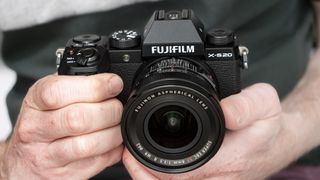
Which type of camera is best for traveling?
Travel cameras come in a range of shapes and sizes. Which style is best for you will depend on how you like to travel, what you like to shoot and how much gear you’re willing to cart around.
Travel zoom compacts such as the Panasonic Lumix ZS200 / TZ200 are pocket friendly, yet offer a broad scope for capturing a range of subjects. Thanks to generous zoom ranges, they give you the opportunity to get close to the action, or to shoot wide. The trade-off for having all of this flexibility in a compact body is generally a smaller sensor, which is less useful for shooting in low light.
If you’d like neat proportions but don’t need the versatility of a zoom lens, premium compact cameras could be worth considering. Models such as the Fujifilm X100V sacrifice zoom range in favour of larger sensors that are better at gathering light – usually a one-inch or, in the case of the X100V, an APS-C chip.
Between compacts and mirrorless cameras is where you’ll find bridge cameras. Bulkier than a standard compact, they offer more comfortable handling and a large zoom range, but without the need to carry different lenses. New bridge cameras are increasingly rare, but the Sony Cyber-shot RX10 IV remains a great example.
If you don’t mind traveling with multiple lenses, many of the best mirrorless cameras have been specifically designed with travel in mind. In the case of models like the OM System OM-5 , that means a portable, weatherproof body, useful image stabilization for shooting on the move, plus a versatile Micro Four Thirds sensor that balances size and performance. And with lots of different lenses to choose from, you can pack different optics depending on the type of trip you’re taking – or opt for a reliable all-round option.
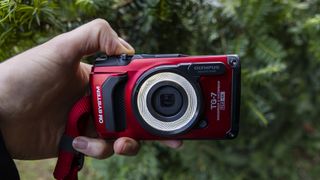
Is a DSLR or mirrorless camera better for travel photography?
When it comes to travel photography, most photographers look for a balance between portability and performance. If this is the combination you’re after, mirrorless cameras will almost aways have the edge over their DSLR rivals. Mirrorless models are generally smaller and lighter than DSLRs, making them easier to wield and travel with.
Despite their more compact proportions, many of the best mirrorless travel cameras can also match or outclass DSLR cameras when it comes to image quality, as well as autofocus abilities and video features. This makes them versatile tools for shooting on the move, especially if you choose a model with in-body image stabilization for sharp handheld results. If you pick a mirrorless camera with an established lens mount system, you’ll also find no shortage of glass to pack for your trip.
That said, there are reasons why you might still want to consider a DSLR camera for travel. Some photographers prefer the chunkier ergonomic grip for which the DSLR format is famous, especially if they plan on shooting for hours on end. The best DSLR cameras also offer superlative battery life, which can be useful if your travel plans include days away from electricity.
Budget might also be a factor, especially if you’re concerned about taking an expensive camera on your travels. Older DSLR cameras can offer great value, as can second-hand mirrorless models. It’s also worth looking at our round-up of the best cheap cameras , which includes some options that are a good fit for travel photography.
- Read our in-depth DSLR vs Mirrorless comparison
How we test travel cameras
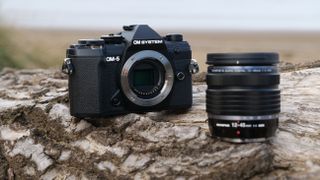
☑️ 100s of cameras reviewed ☑️ 15 years of product testing ☑️ Over 16,000 products reviewed in total ☑️ Nearly 200,000 hours testing tech
Buying a camera these days is a big investment, and travel cameras are no different – so every camera in this guide has been tested extensively by us. For travel cameras in particular, real-world tests are the most revealing way to understand a camera's performance and character, so we focus heavily on those, along with standardized tests for factors like ISO performance.
To start with, we look at the camera's design, handling and controls to get a sense of how suitable it is for life on the road, and any particular features that might be particularly useful for globe-trotters. When we take it out on a shoot, we'll use it both handheld and on a tripod to get a sense of where its strengths lie, and test its startup speed.
When it comes to performance, we use a formatted SD card and shoot in both raw and JPEG (if available). For burst shooting tests, we dial in our regular test settings (1/250 sec, ISO 200, continuous AF) and shoot a series of frames in front of a stopwatch to see if it lives up to its claimed speeds. We'll also look at how quickly the buffers clears and repeat the test for both raw and JPEG files.

In various lighting conditions, we also test the camera's different autofocus modes (including Face and Eye AF) in single point, area and continuous modes. We also shoot a range of photos of different styles (portrait, landscape, low light, macro/close-up) in raw and JPEG to get a sense of metering and its sensor's ability to handle noise and resolve fine detail.
If the camera's raw files are supported by Adobe Camera Raw, we'll also process some test images to see how we can push areas like shadow recovery. And we'll also test its ISO performance across the whole range to get a sense of the levels we'd be happy to push the camera to.
Battery life is tested in a real-world fashion, as we use the camera over the course of the day with the screen set to the default settings. Once the battery has reached zero, we'll then count the number of shots to see how it compares to the camera's CIPA rating. Finally, we test the camera's video skills by shooting some test footage at different frame-rates and resolutions, along with its companion app.
We then take everything we've learned about the camera and factor in its price to get a sense of the value-for-money it offers, before reaching our final verdict.
Get daily insight, inspiration and deals in your inbox
Sign up for breaking news, reviews, opinion, top tech deals, and more.
Tim is the Cameras editor at TechRadar. He has enjoyed more than 15 years in the photo video industry with most of those in the world of tech journalism. During his time as Deputy Technical Editor with Amateur Photographer, as a freelancer and consequently editor at Tech Radar, Tim has developed a deeply technical knowledge and practical experience with cameras, educating others through news, reviews and features. He’s also worked in video production for Studio 44 with clients including Canon, and volunteers his spare time to consult a non-profit, diverse stories team based in Nairobi. Tim is curious, a keen creative, avid footballer and runner, and moderate flat white drinker who has lived in Kenya and believes we have much to enjoy and learn from each other.
- Mark Wilson Senior news editor
- Chris Rowlands
This ‘game-changing’ AI camera for kids wants to keep your little ones safe, and creative
New Insta360 Ace Pro 2 action camera leaks spill details on pricing and specs
Apple Ring: all the rumors so far and what we want to see
Most Popular
- 2 Dozens of Fortune 100 companies have unknowingly hired North Korean IT workers
- 3 ICYMI: the week's 7 biggest tech stories from the PS5 Pro preorders to Meta announcing its Orion AR glasses
- 4 AGM Mobile X6 Phantom rugged phone review
- 5 Shark Detect Pro vs Stratos: which vacuum is better?
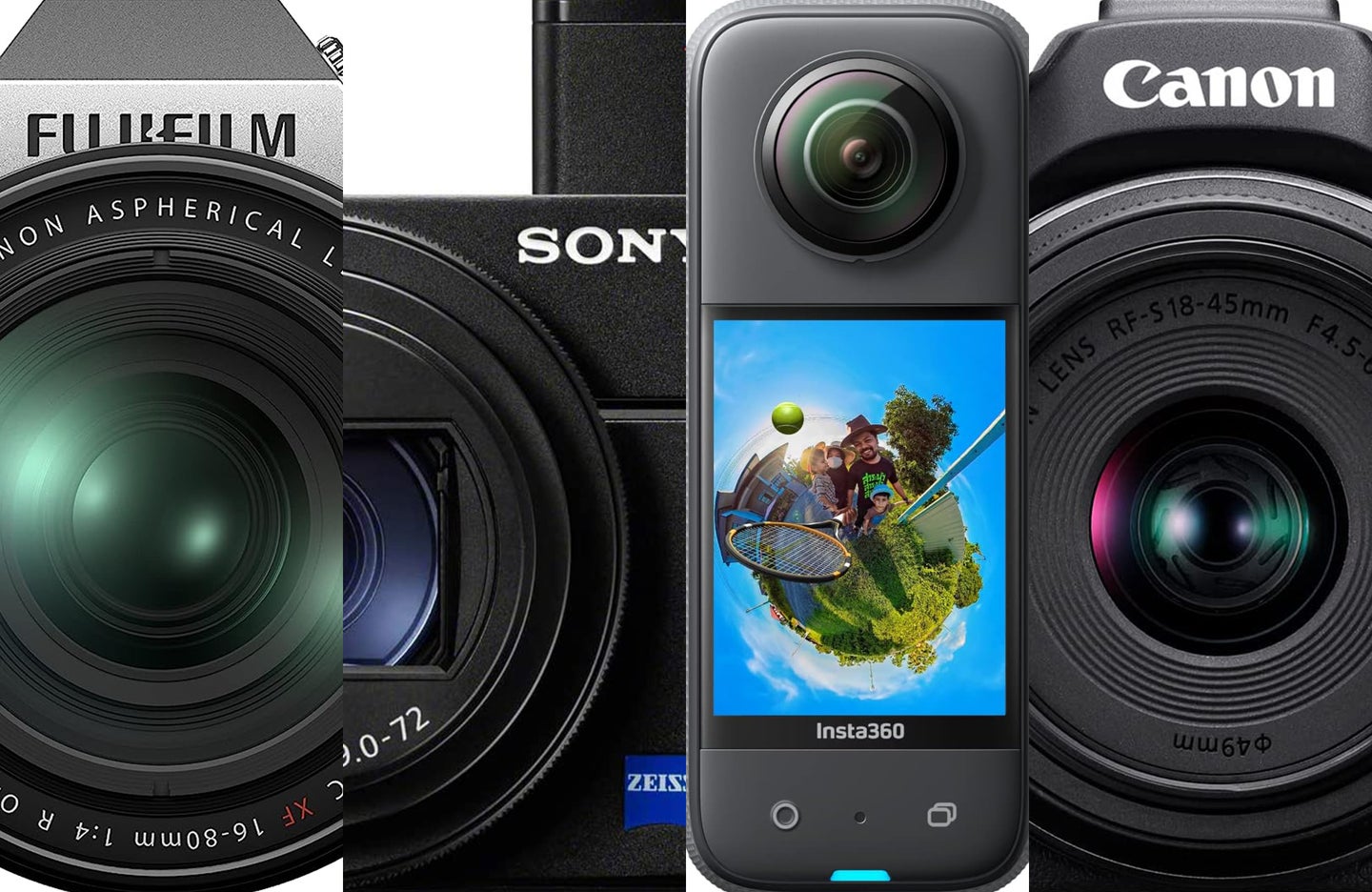
The best travel cameras of 2023
No matter where your travels take you, these cameras will set you up for success in documenting every detail of the journey.
We may earn revenue from the products available on this page and participate in affiliate programs. Learn more ›
Choosing travel cameras for your trips can be an overwhelming prospect. You’re faced with a ton of great options, from advanced mirrorless systems to compacts and action cameras. It’s easy to get lost in the noise. Plus, when you consider features like video capabilities, screen type, and sensor size, it can be downright confusing. All of these features need to fit your photographic—and budgetary—needs. Knowing what you intend to use your captures for and what is most vital for you when traveling with a camera is the best place to start. These are the best travel cameras available, no matter what you are looking for.
- Best overall: Sony Cyber-shot DSC-RX100 VII
- Best action camera: GoPro HERO11 Black
- Best 360 camera: Insta360 X3
- Best mirrorless: Fujifilm X -T5
- Best mirrorless on a budget: Canon EOS R100
- Best for video: Sony ZV-E1
- Best for video on a budget: Sony ZV-1
How we picked the best travel cameras
The editors and writers at Popular Photography have decades of photography experience in just about every genre and have covered and reviewed just about every major camera on the market. When selecting the products in this list of best travel cameras, we looked at a wide range of important features in travel cameras. We researched the different camera choices available and compared specs and image and video quality. Size and weight, sensor size, autofocus abilities, battery life, and lens options were just some of the considerations. In addition, we noted any unique attributes or settings available on the cameras. We also aimed to choose offerings at different price points and cover the range of camera types from DSLR to compact. All of these considerations allowed us to compile a list of cameras suitable to various travel styles and capture needs.
The best travel cameras: Reviews & recommendations
While you certainly can use your smartphone to document your travels, there are lots of reasons to bring a dedicated camera along. Whether you’re looking for better image or video quality, a different perspective, or just don’t want the distraction of your phone, the best travel cameras will help you capture epic images to help you relive your trip down the line.
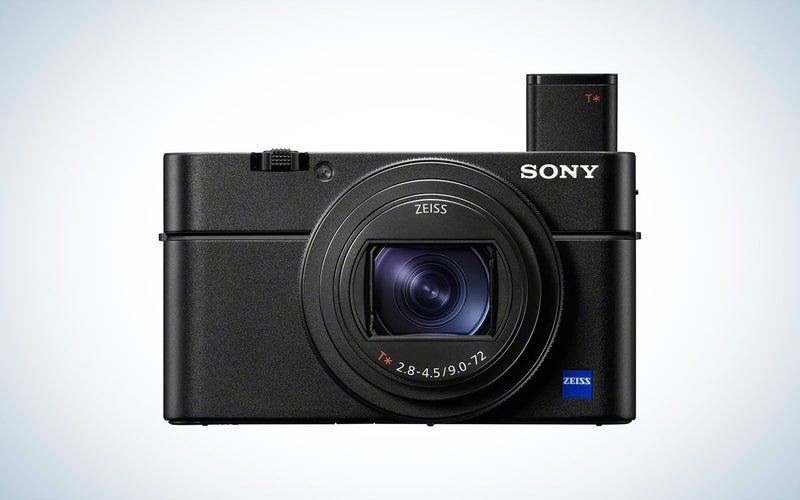
- Resolution: 20.1 megapixels
- Sensor size: 1-inch
- Lens mount: N/A
- Image stabilization: Digital and optical in the integrated lens
- Memory card slots: Single Slot: SD/SDHC/SDXC
- Weight: 10.65 ounces
- Dimensions: 4 x 2.29 x 1.69 inches
- Versatile 24-200mm zoom lens built into the camera
- Fast autofocus with AF points covering nearly the entire field of view
- Pricey for a compact
The newest iteration of the Sony RX100 is an excellent bridge between a compact camera and a DSLR or mirrorless option. Its pocket-ready size makes it easy to carry and pack, an important feature for a travel camera. The smooth finish on the camera body does make it a bit slippery, but a wrist strap can help with carrying.
Despite falling into the compact category , it has the option to use full manual mode (and other staples like aperture and shutter priority), allowing you to have complete control over your images. The 24-200mm equivalent lens covers both the wide-angle and telephoto sides of things, which is helpful for documenting a range of subjects on your travels. Plus, with a maximum aperture of f/2.8-4.5, you can still get nicely blurred backgrounds for drawing attention to your main subject. It’s also handy for shooting in low light if you don’t want to rely on the built-in pop-up flash.
The RX100 VII has 4K video recording with human and animal eye autofocus, which mimics Sony’s higher-end mirrorless models. The newly designed sensor and BIONZ X image processor allow for extremely fast autofocus, with 68% of the image area covered by AF points.
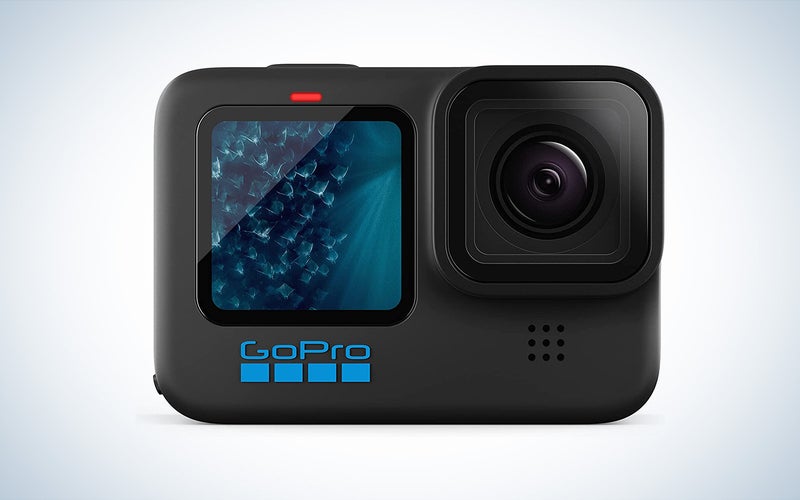
- Resolution: 27 megapixels
- Sensor size: 1/1.9-inch
- Image stabilization: Digital
- Memory card slots: Single microSD
- Weight: 4.5 ounces
- Dimensions: 2.8 x 2 x 1.3
- Award-winning stabilization
- Extremely compact
- Waterproof without a case
- Tons of mounting accessories
- Still not the best in low light conditions
- Limited controls
GoPro cameras have been synonymous with travel cameras for quite some time. That’s in part thanks to how rugged and compact they are. And now, the GoPro HERO 11 features the largest sensor of any GoPro yet. It can produce 27-megapixel stills, as well as 5.3k 60p video. And the expanded image sensor allows for more flexibility when zooming, cropping, changing digital lenses or adjusting the aspect ratio. You’ll be able to easily create vertical videos for social media platforms without losing most of your image.
GoPro’s HyperSmooth 5.0 image stabilization system is truly impressive, offering several modes depending on the activity in which you’re participating. It’s even burly enough to smooth out footage from high-impact activities like mountain biking or skiing. And it offers Horizon Lock to keep your footage level even as you move around.
GoPro also added new night effects to its latest action camera . That includes modes for documenting star trails, creating light painting photos, or capturing vehicle light trails. It still won’t perform as well in low light conditions as something like a mirrorless camera, but it has been improved compared to previous models.
If you want the latest GoPro, the recently released Hero 12 offers even longer run times and higher-quality HDR video.
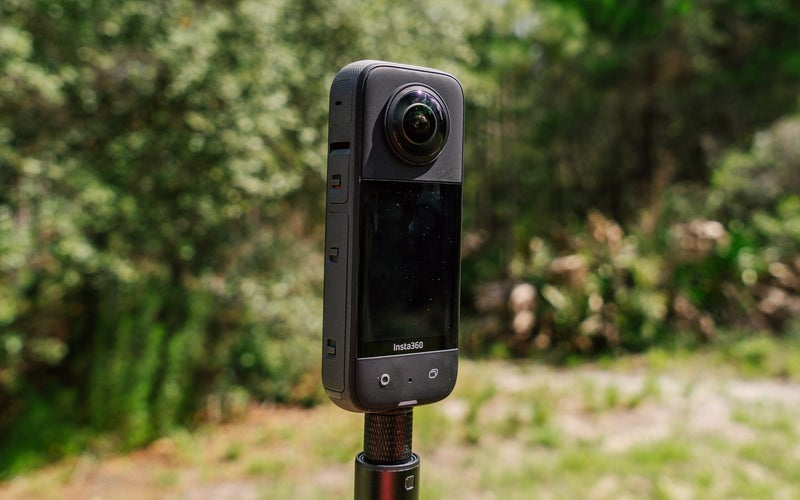
Abby Ferguson
- Resolution: 48 megapixels
- Sensor size: 1/2-inch
- Image stabilization: Yes
- Weight: 6.3 ounces
- Dimensions: 4.5 x 1.8 x 1.3
- Excellent stabilization
- Unique 360-degree perspective
- Lots of mounting options
- High-quality video
- App is a bit tricky to use
If you want something a bit unique for your travels, the Insta360 X3 action camera fits the bill. It records 360-degree video with its dual lenses so that you can show every direction for immersive content. The selfie stick is invisible in the footage, so you won’t have that distracting element in your shots. And it’s plenty rugged, with an IPX8 rating and waterproofing down to 33 feet without a case, making it an ideal travel camera for rugged adventures.
The X3 offers many different video and photo modes for extra versatility. It’s capable of 5.7K 24p 360-degree video, 4K 30p single-lens footage, 8K 360-degree timelapse, or ultra-wide 170-degree shots at 2.7K resolution. It can also create up to 72-megapixel photos, so you’ll be able to get high-quality stills as well. And thanks to its 6-axis gyroscope and FlowState Stabilization technology, your videos will be smooth and level no matter how adventurous your activity.
The camera pairs with the Insta360 app, which gives you lots of creative control. It provides lots of AI-powered features to simplify the process, or you can have full control. If working with 360-degree files, you can choose the direction the camera points, have it follow something, and so much more. The app is a little confusing to use, so takes some getting used to, but it offers nearly endless editing options.
To learn more about the Insta360 X3, read our full review .
- Best mirrorless: Fujifilm X-T5
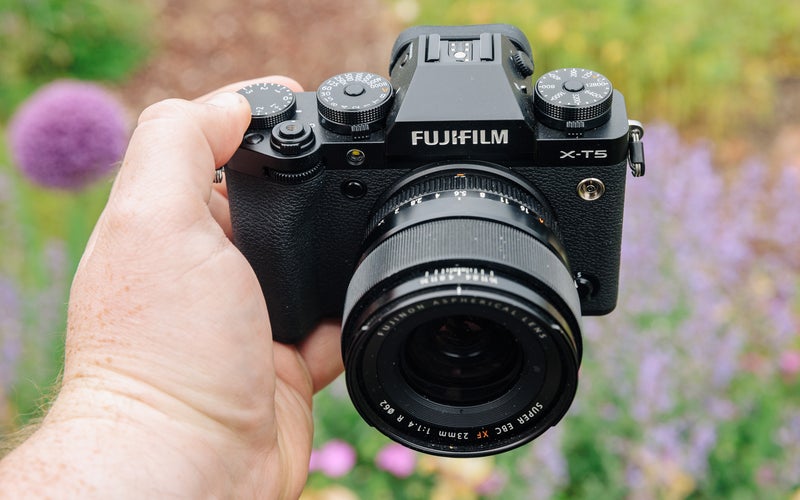
Stan Horaczek
- Resolution: 40.2 megapixels
- Sensor size: APS-C
- Lens mount: Fujifilm X
- Image stabilization: Sensor-Shift, 5-Axis
- Memory card slots: Dual slot: SD/SDHC/SDXC (UHS-II)
- Weight: 1.2 pounds
- Dimensions: 5.1 x 3.6 x 2.5 inches
- 6.2K video at 30fps
- In-body stabilization
- Attractive in-camera film presets
- Tactile camera controls
- Solid weather sealing
- Expensive for an APS-C camera
- Rear screen only tilts
The newest version of Fujifilm’s X-T5 camera is an ideal choice for a hybrid shooter who wants to take both photographs and video on their trips. As an APS-C mirrorless camera , the body is relatively compact, which is ideal for a travel camera since it won’t take up much room in your bag. And it features Fujifilm’s typical retro styling, so it will look cool when you bust it out on your trips. Plus, there are lots of tactile dials on the top of the camera that keep you from digging in the camera menus, which is always ideal for staying in the moment.
The X-T5 offers 40.2 megapixels for detailed, high-quality photos. If that’s not enough, you can take advantage of Pixel Shift Multishot, which automatically takes 20 frames with a single press of the shutter to produce a 160-megapixel file. The electronic shutter goes up to 1/180,000 seconds, with 20 frames per second burst shooting to help you document fast action.
On the video side, it’s capable of 6.2K 30p video or oversampled 4K footage. The seven-stop in-body image stabilization system will help with achieving sharp photos even when shooting in low light. And it will help keep your videos smooth, even without a gimbal.
As with other Fujifilm cameras , it comes with lots of different film simulation modes. These can give your photos a more polished, unique look without needing to spend time editing, which is ideal when traveling.
To learn more about the X-T5, check out our full review .
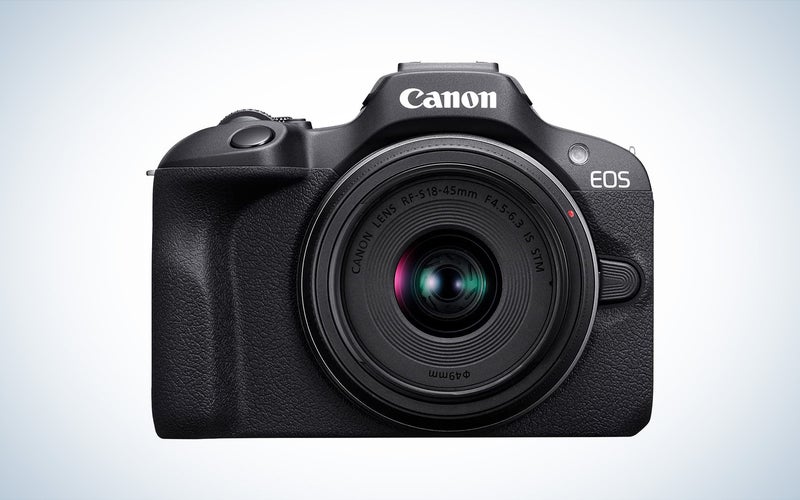
- Resolution: 24.1 megapixels
- Sensor size: APS-C
- Lens mount: Canon RF
- Image stabilization: None
- Memory card slots: Single slot: SD/SDHC/SDXC
- Weight: 12.6 ounces
- Dimensions: 4.6 x 3.4 x 2.7 inches
- Budget-friendly
- Very compact
- Excellent image quality
- 4K video 24p video
- Rear screen is fixed
- No touchscreen functionality
Canon’s EOS R100 is an absolutely tiny camera, especially for one that offers interchangeable lens functionality. It is compatible with all RF lenses, as well as EF lenses if you get an adapter. The camera weighs a measly 12.6 ounces, making it the smallest Canon R line camera yet. It’s also very affordable.
Despite the small size and budget price, this camera has a lot to offer. It’s capable of cropped 4K 24p video, of you can record full HD at up to 60p. The autofocus system is very advanced for a budget camera, so you can trust that your images and videos will be in focus without much work on your end. The Eye Detection will even work when you are trying to get full body shots of a subject. Still images will also be high-quality thanks to the 24.1-megapixel sensor and excellent dynamic range.
The main downside to the camera is the rear screen. It is fixed, so you won’t be able to flip it around for selfies. And it isn’t a touch screen. But it offers lots of wireless connectivity options for transferring your files, so you don’t need to worry about sitting down to a computer to get images to share to social media while traveling.
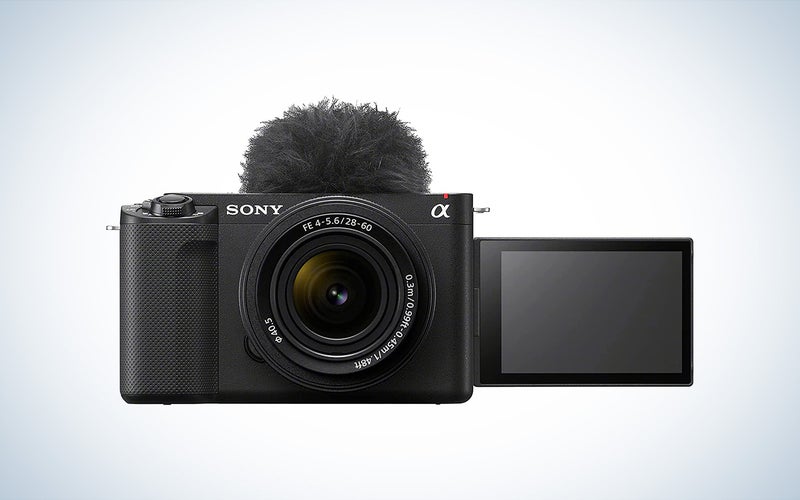
- Resolution: 12.9 megapixels
- Sensor size: Full-frame
- Lens mount: Sony E
- Image stabilization: Digital, 5-Axis
- Memory card slots: Single slot: SD/SDHC/SDXC (UHS-II)
- Weight: 1.1 pounds
- Dimensions: 4.8 x 2.8 x 2.1 inches
- Impressive autofocus
- Unlimited 4K recording
- Lots of color control options
- Single UHS-I card slot
- Lower resolution sensor isn’t as ideal for stills
Sony’s ZV-E1 is a full-frame camera that is specifically built for vloggers . It is an interchangeable lens camera, unlike its more budget-friendly sibling mentioned below, meaning you can have more control over the look of your content thanks to the wide selection of lenses for Sony E mount. And, even though it’s a full-frame camera, it’s still very compact and lightweight, making it ideal for travel.
The ZV-E1 offers advanced and impressive autofocus. It can even track multiple people in a single frame, which is helpful if you are traveling with a group. It also offers focus breathing compensation, which is a change in focal length when adjusting the focusing distance. A bokeh switch allows for a custom level of bokeh, so you can fine-tune the style of your shots.
Perhaps most importantly, the video from the ZV-E1 is excellent. It’s capable of up to 4K 120p video or 240 fps with full HD resolution. And there are no recording limits, so you can record long cuts. It provides access to advanced color control, such as S-Cinetone, for natural-looking skin tones. You can also adjust the gamma, black level, knee, color level, and more. Or you can import and apply your LUTs in camera to save you editing time.
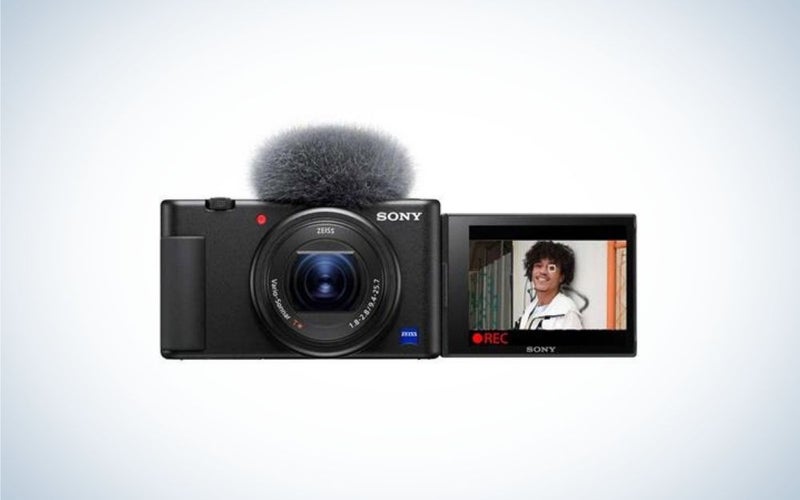
- Resolution: 10.1 megapixels
- Sensor size: One-inch
- Weight: 10.4 ounces
- Dimensions: 4.15 x 2.36 x 1.71 inches
- Compact and lightweight
- Excellent autofocus
- Flip-out screen great for vlogging
- Less than impressive battery life
- 24-70mm lens may not be wide enough for some
This is the first version of Sony’s entry-level vlogging camera, but it is still an excellent choice and will save you money over the latest iteration. To create this vlogger camera, Sony used much of the tech featured in the more expensive RX100 line, resulting in superb quality in a bit more stripped-down package. They also added a handgrip on the ZV-1, making it easier to hold. And, the screen flips to the side, making selfies easier to record even when you have accessories on the hot shoe.
Despite being a small point-and-shoot camera, you get 4K video and access to tons of AF points across the sensor. There is even a focus mode that allows you to easily shift focus from your face to elsewhere in the foreground, which is helpful for showing off your travel finds.
While the quality of the 24-70mm lens is solid, having something a little wider would have been ideal. If you do want a wider lens, the new ZV-1 II offers an 18-55mm equivalent lens. It also features a faster sensor and a new mic design. It will cost you a little over $100 more at the time of writing but may be worth it if you want that wide view for documenting travel.
Things to consider before buying the best travel cameras
When selecting the best travel cameras for your trips, there are a handful of things you should consider.
Your photography style
It is essential to consider what kind of traveler you are and how you intend to use the camera. For example, if you don’t mind traveling with heavy gear and want quality over anything else, your camera needs will differ from someone who likes to travel fast and light. Likewise, a backpacking trip through a jungle could call for a different camera than a luxury cruise. Deciding on what your priorities are first will help you narrow down all of the options available to you in a camera.
You’ll want to pay attention to both dimensions and weight in your setup. The amount of space that a camera takes up in your bag is significant when maximizing what you can bring along. Carrying a heavy camera around on your back while in between destinations or holding it for long periods while out and about gets old fast, so weight does make a difference. Even a few ounces can start to weigh you down on long treks.
You’ll want to choose a camera that offers features you’ll actually use but skips others that won’t be necessary. For example, if you want to take lots of selfies or group photos, a camera with a screen that flips around will be extremely helpful. Or, perhaps you would like to take lots of videos and share your travels. If so, paying attention to the video recording capabilities is a good idea.
Ruggedness and weather-sealing
Moisture and sand don’t play nicely with electronics. Hard falls can do even more damage. If you’re planning to take your camera out into the wilderness or other treacherous terrain, opt for a camera with robust weather sealing. Some cameras come with an IP (ingress protection) rating that will tell you exactly how much exposure to water, dust, and shocks they can withstand. Even if you’re not headed into the jungle, travel can take a toll on cameras, so ruggedness always comes in handy.
Image size and quality
Not every photo is destined to become a giant print. If you plan to use photos and videos solely for social media and to remember your trip, spending money on a camera with exceptional image quality and large files is unnecessary. However, if you want to make large prints of your images or produce high-quality films from video footage, you will want to invest in a camera with more megapixels and higher video resolution. Just remember, more pixels require more storage, so don’t skimp on those SD cards .
As with most purchasing decisions, cost is a significant factor. This is especially true with a travel camera, as you are likely putting an expensive piece of equipment at risk of getting broken, lost, or stolen, depending on how you use it. Finding a camera that isn’t pushing your budget to the max may be a good idea because of the risk. Insuring your equipment before trips is also recommended.
Q: Are mirrorless cameras better for travel?
Mirrorless cameras are often smaller than DSLRs because they can cut out all the space and weight required for the mirror mechanism. That also gives mirrorless cameras fewer moving parts, which means fewer things to break during your trip. As mentioned above, lighter and smaller cameras are ideal for travel, making mirrorless a frequently preferred option for travel cameras.
Q: Is GoPro good for travel photography?
GoPro cameras are excellent for travel for a few reasons. First, they are built to withstand extreme conditions, so you don’t have to baby them by any means. Second, they are tiny. You can easily throw one into your backpack or even a jacket pocket, making lightweight travel more possible. Lastly, they have excellent video capabilities and pretty solid still photo specs. However, they are limited in exposure control (among other things), and the ultra-wide-angle lens may not be ideal for all settings. There are tradeoffs, but overall it is an exceptional pick for travel.
Q: Can an iPhone 12 replace a DSLR?
The iPhone 12’s camera is impressive, no doubt. And as photographer Chase Jarvis once said, “the best camera is the one that’s with you.” Depending on your goals for your travel photography, the iPhone can absolutely replace a DSLR. However, if you want more control over your images or want higher-quality files, a dedicated camera, whether a DSLR or something else, will be the way to go.
Final thoughts on the best travel cameras
Choosing the best travel cameras will come down to your travel style (rugged adventures or luxury stays), documentation needs (stills or video), and how much control you want with your camera. For most users, the Sony Cyber-shot DSC-RX100 VII is a well-rounded option that meets a variety of needs. In addition, it offers more quality and features than a phone would, making it a worthwhile upgrade.
Why trust us
PopPhoto has a long history of delivering the opinions of some of the sharpest and most prolific camera dorks the world has to offer. Since 1937, we’ve been reviewing cameras, providing wisdom from well-known photographers, and generally just nerding out about all that goes into making great pictures. Our current crop of writers and editors have decades of professional photography and camera writing experience among them. Collectively, we’ve probably shot with just about every camera and lens combo you can imagine—as well as some obscure stuff you may not even know about. Remember the Casio Tryx folding camera? PopPhoto does.
We also get that buying a camera is a big decision, which is why we’re dedicated to helping folks choose the right one (or, in our case “ones”) for their needs. Case in point: Handing over top dollar for an expensive rig may leave you unsatisfied if it doesn’t fit your preferred shooting style. Sure, a $6,000 sports-oriented DSLR can capture landscapes, but do you really need to do it at 30 frames-per-second? No, you don’t.

Abby Ferguson is the Associate Editor for Gear and Reviews at PopPhoto, joining the team in 2022. She has been involved with the photography industry in various capacities since her undergraduate training at the University of Kentucky, with work ranging from client photography to program development and management of the photo department at Evolve, a vacation rental company.
Want more photography techniques, camera reviews, and inspiration?
Sign up for Popular Photography's newsletter and join the club.

Our Expert Guide to the BEST Travel Cameras in 2024
- Last Updated: December 13, 2023
We’ve spent years working as professional travel photographers, and are proud to have put together this definitive guide to the best travel cameras in 2024 for every budget, based on actual hands-on experience.
One of the best souvenirs you can bring home from your adventures abroad is photographs.
As the old saying goes, pictures are worth a thousand words, and nothing brings back the excitement and thrill of holiday memories quite like looking back at your photos.
These days almost everybody has a decent camera in their pocket, thanks to the wonders of modern smartphones. And while these are fine for the average person, if you really want great image quality, you’re going to have to invest in something better.
People say, “It’s not the camera that takes good photos, it’s the photographer”, and this is completely true. Yet there’s a reason professionals use expensive gear – they are better for the job.
Never fear though, that doesn’t mean you need to go out and spend $10k on a set-up! Definitely not.
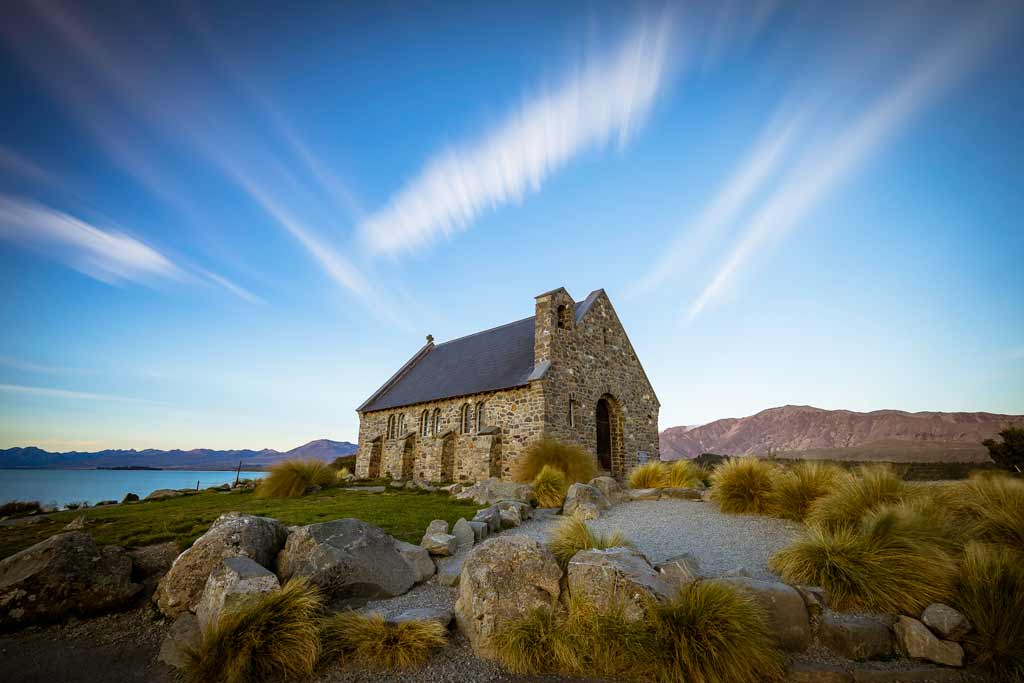
In fact this article is going to save you time and money by diving straight into the best travel camera for every budget.
So why listen to us?
We’ve been working as professional travel photographers for almost a decade, and have been fortunate enough to put hundreds of cameras to the test during our career.
Based on our personal experience, we’ve been able to narrow down the absolute top choice in every category.
Whether you are a beginner, intermediate or professional, or even if you know nothing at all, we’ll help you make the right choice so you don’t waste your money getting something that just isn’t up to the job.
READ MORE: Check out our comprehensive guide on how to take better travel photos .
Let’s dive into our comprehensive guide for the best camera for travel photography.
Table of Contents
Our Recommendation
Bonus: recommended lenses for sony a6600, bonus: recommended lenses for sony a7iv, size and weight, resolution/megapixels, interchangeable lenses, manual settings, weatherproofing, stabilization, mirrorless vs dslr, what camera do most professional photographers use, what camera is best for travel videos, what is the best small camera for travel, what is the best travel camera in 2024.
Without further ado, let’s get into the article!
Disclaimer – NOMADasaurus is a participant in the Amazon Services LLC Associates Program and the Amazon EU Associates Programme, an affiliate advertising program designed to provide a means for sites to earn fees by advertising and linking to Amazon.com and affiliated sites.
GoPro HERO12 Black – The Best Action Camera
Action cameras have come a long way since we bought our first one back in 2010.
They used to be reserved just for people who were into extreme sports – skiing, skydiving, motocross, scuba diving, etc.
Now they have become one of the top travel cameras on the market thanks to their durability, compact size and high quality.
The good ones shoot in at least 4K video (this one though actually goes up to 5.3k), are completely waterproof and even connect to your phone so can take great photos from any angle.
They also shoot time-lapse photography, which is great if you’re catching an epic sunrise or particularly busy urban scene.
Even if you are not interested in jumping off of cliffs or mountain biking through a jungle, having an action compact camera is still a brilliant tool to have in your suitcase.
They are especially awesome if you’re looking for the best cameras for adventure travel.
The undisputed king of action sports cameras is GoPro, and we’ve been proudly using them for over 13 years.
These epic cameras have insane image quality and shoot some remarkable video. They’re also extremely durable, waterproof and fit in your pocket.
Adding to the GoPro series is a huge range of accessories that makes getting footage limited by only your imagination.
Check out our brand new GoPro HERO12 Black review to see if it’s right for you!
Different mounts allow you to put them just about anywhere, extension poles get unique angles (perfect for selfies), you can stick a GoPro on a tripod and there are even filters available.
We’ve had just about every GoPro camera since the original HERO was released, and we’re super excited to share that the newest one on the market is by far the best ever.
Their latest camera is the GoPro HERO12 Black , following hot off the heels of the successful HERO11 (click the link to read our review of it), and it’s risen the bar once again.
When the HERO7 came out they introduced a number of revolutionary features, such as HyperSmooth (in-built image stabilisation), TimeWarp (awesome hyper-lapse videos) and SuperPhoto (HDR photos on steroids).
The HERO9 added a front-facing LCD screen, which really stepped things up a notch, especially for vloggers.
The HERO10 brought in the new GP2 processor, which made everything work, well, just better.
The HERO11 went bonkers with a brand new larger sensor, 10-bit colour and all new aspect ratio.
And now with the HERO12 the company has gone and made everything more refined with a host of new features and upgraded battery life.
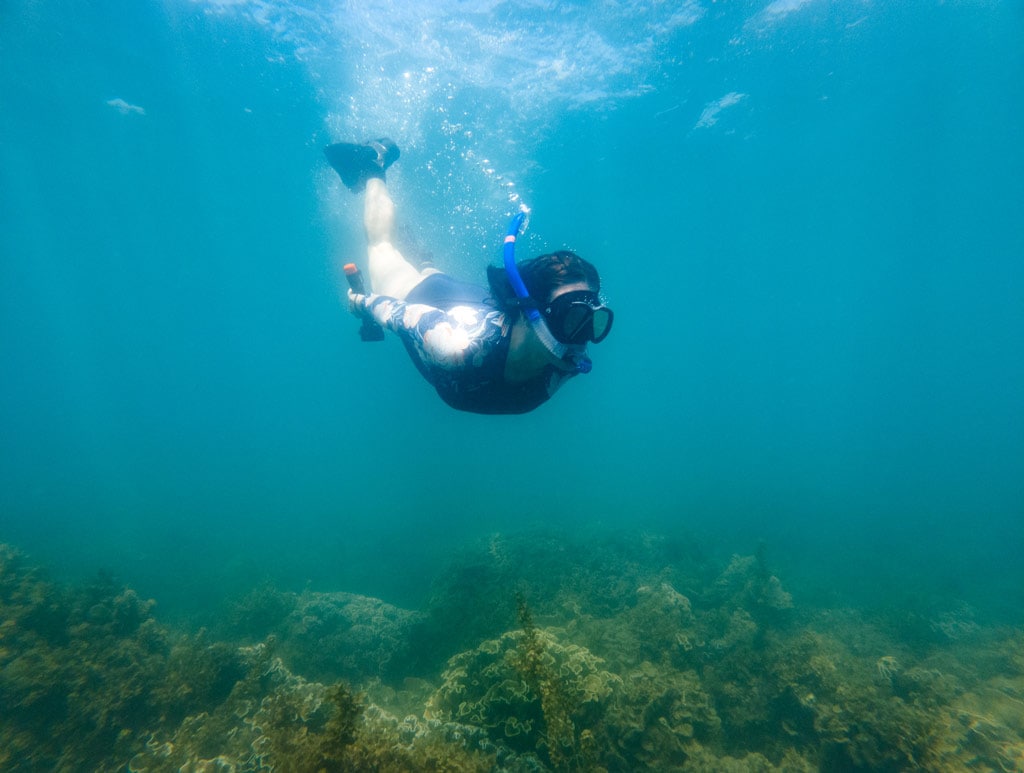
Boasting the fantastic GP2 processor, 1/1.9″ sensor and 8:7 aspect ratio, the latest GoPro HERO12 Black now has HDR video to go along with the expert camera settings.
The massive aspect ratio gives more room to crop, so you can shoot in one perspective and scale later for portrait social media content or landscape YouTube videos.
The camera shoots in 5.3k 60 frames per second, 4k at 120fps and 2.7k at a whopping 240fps (8x slow motion), which also allowing for 27 megapixel screen grabs when using 5.3k on the full 8:7 ratio.
The stabilization is even better with HyperSmooth 6.0 (in-built horizon levelling up to 360 degrees), TimeWarp 4.0 allows to switch between hyper-lapse, real-time and slow-mo recording in the same video with a tap of the screen, and the SuperPhoto has improved HDR abilities.
The screens are still very responsive and look excellent.
SuperPhoto for photographers, in particular, means you can point and shoot, and barely have to edit before uploading to social media. Although we still recommend shooting in RAW for the pros out there.
This article talks more about how to take better GoPro photos, written by a pro.
For the purists out there, the GoPro HERO12 shoots in RAW format for all photo modes.
There is still voice activation and the entire unit is waterproof to 10m, meaning there is no need for a dive housing if you’re not going below that depth.
Also the all-new Night Effects modes are really awesome. Who would have thought you could capture light trails and the Milky Way on such a tiny camera?
For the video gurus out there the HERO12 is a gimbal killer. What does that mean? It means HyperSmooth 6.0 is on another level.
The HERO7 stabilisation was amazing for vlogging and action sports, as was the HERO8 and 9, but after testing the new HERO12, the stabilisation is even better again. Don’t know how they do it, but they do! And it works at 4K at 120fps, TimeWarp and live streaming!
Want slow motion? How does 2.7k at 240FPS sound? Buttery smooth, that’s for sure.
Whereas in previous models they had White, Silver and Black models, the HERO12 only has a Black model.

Canon Powershot SX740HS – The Best Affordable Camera
If you want a dedicated camera that is cheap and still takes decent photos then you really are spoiled for choice.
We’ve personally owned a whole range of different brands in this range, from Canon to Fuji to Olympus to Sony, and with the way the best travel camera market is now if you’re not fussy about the brand you get, then you can’t really go wrong. But let us explain what you’ll need.
You’ll basically be looking for a small point and shoot, something that is foolproof and most importantly quite durable. Having a big zoom range is a big bonus so you can crop right in on different scenes.
The ability to use manual settings will come in handy if you ever want to play around and learn a bit more about how photography works.
And you want something affordable so that you won’t be overly worried if you lose it (just make sure you backup your photos).
The Canon Powershot SX720HS was a hugely successful compact camera, and Canon backed it up with the amazing SX730HS to become the best budget travel camera.
But like all good camera companies, Canon has stepped it up a notch again by bringing out the newest model in the range, the SX740HS .
This great little travel camera does it all, and for the price, it is the best travel zoom camera out there.
40x optical zoom, manual settings, shoots in 4K video, good color grading, and it is one of the better compact cameras out there.
It also has wifi so you can transfer photos straight to your phone or laptop without plugging it in, or control the camera from your phone. Perfect for the general traveler who just wants something to take decent photos with on their trip.
It also has a large articulated screen, so you can angle your shots perfectly, whether you’re shooting from the ground or above the head.
A few more updates over the SX730HS is an improved small sensor, meaning better low light capabilities, and faster burst shooting, cementing its position as the best budget camera for travelling.
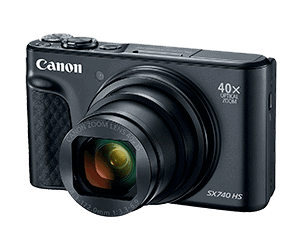
READ MORE: Check out our latest guide on the best camera accessories !
Sony RX100 vii – The Best Compact Camera for Travel
This is the next level up. You still want the portability and benefits of having a point and shoot, but you want to take incredible photos too.
You’re interested in learning about the fundamentals of photography, and perhaps want to one day print your photos or maybe put them up online. Ultimately you’re after the best pocket camera for travel.
Here are the things you’ll need: Full manual control, a decent size sensor, zoom, high-quality video, flip screen (so you can shoot from different angles while still framing your shot), ability to shoot in RAW format, good ISO performance and a wide aperture.
This is the category that most people will be in. So if you’re asking yourself what is the best compact digital camera for traveling, read on…
READ MORE: Check out our comprehensive guide to the best landscape photography tips !
This is, in our opinion, the best point and shoot camera for travel on the market. It does everything you’ll ever need it to do and has incredible image quality in a premium compact size.
Sony have completely revolutionized the market with the RX100 range, and with each update it just gets better and better.
Without a doubt there’s no better option for the best compact camera for travel out there than the Sony RX100 vii right now.
The Mark 7 has a very long zoom range (8.6x optical, up from 3.6x optical, which is like having a 24-200mm lens), an amazing 20mp one-inch sensor to capture huge dynamic range, high quality 4K video and an articulating flip screen.
It’s an expensive camera, yes, but if you want the absolute best quality on the market in a small, compact unit that fits in your pocket, this is the best travel camera out right now.
BONUS TIP – If you want to create travel vlogs and have a decent camera for photography too, this is the model for you!
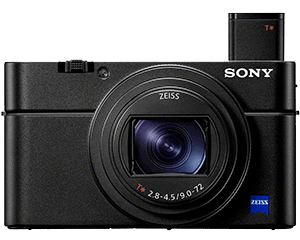
Canon G7X Mark iii – Best Camera for Vlogging
Vlogging is the newest craze, and it’s quite literally taking over as the new digital media of choice for many travelers and influencers.
If making videos is more your style instead of taking photos, then you’re going to want to look at a camera that has a range of specific features.
Most importantly is the ability to shoot in 4K (even if not many people have 4K monitors today, in a few years it will be common and you’re going to want to have footage to match the current standard).
Once you’ve got this another handy feature is an articulated LCD screen that can face you while you’re talking in the lens.
This allows you to frame your shot instead of cutting off half your head. Lastly you’ll want a microphone jack to catch better audio.
Get the camera, start filming and put some great videos up on YouTube ! Sounds easy, right? But what is the best travel camera for vlogging…
We’ve used more vlogging cameras than we can remember, from full-frame setups to GoPros and even putting to the test the brand new Sony ZV-1F .
But what have we settled on?
The Canon G7X Mark ii has always been considered the ultimate travel camera for vlogging, but it fell short in a few different categories.
That’s all changed now with the newest upgrade, the G7X Mark iii .
Shooting fantastic 4k video, this travel camera now has an in-built microphone jack for improved audio, a flip-up touchscreen for keeping your face in frame, and has a faster start-up time than previously.
The image quality is also much better now, and with manual control functions it really is a premium compact travel camera.
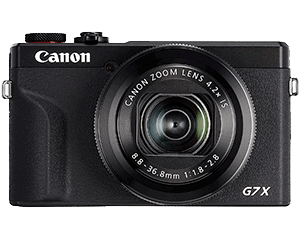
Sony A6600 – Best Mirrorless Camera for Travel
You’ve broken out of the realm of standard point and shoots, and you’re looking for a camera that has interchangeable lenses.
You’re getting into the idea of shooting wide, or perhaps portrait shots. Maybe you really would like to get a longer zoom.
Most of all, you really want to get serious about photography.
In your kit will be a range of lenses for a range of situations. You can look at getting filters to give beautiful effects on your shots. You might even want to start growing your photography portfolio .
A few years ago everyone would have recommended you to get an entry-level DSLR. This is no longer the case.
With the way mirrorless technology has gone DSLRs are losing traction and popularity. Now you can get something with the same image quality for half the size.
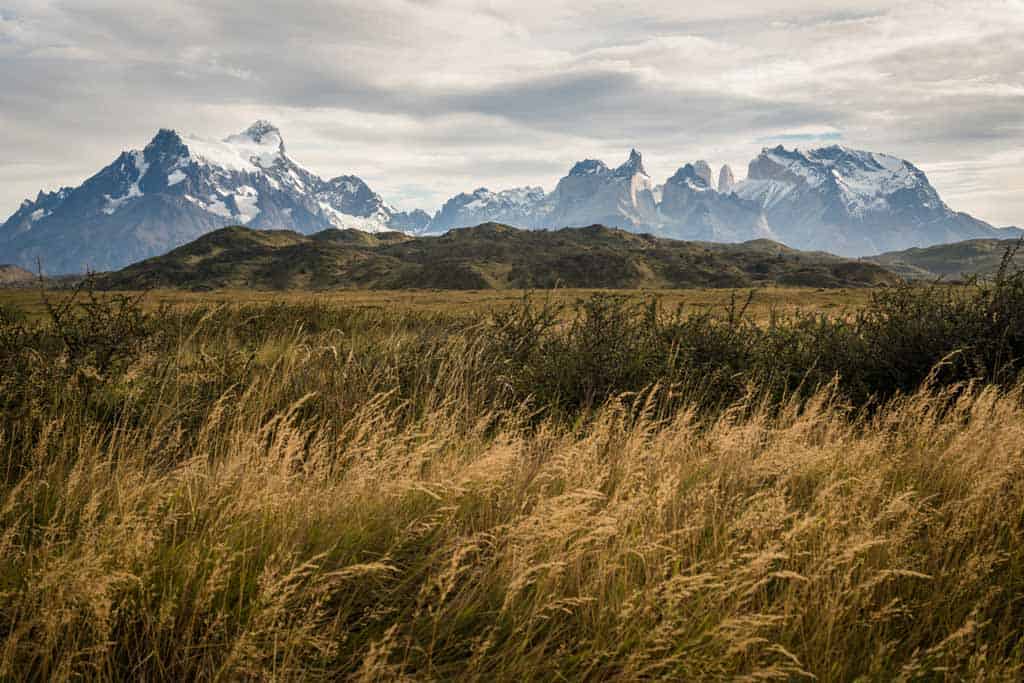
The Sony A6600 is an absolute powerhouse and puts up a good fight for being the ultimate travel camera.
For entry-level mirrorless cameras, Sony broke the mould by introducing the A6000 a few years ago. Since then every model has been lightyears ahead of the competition.
The latest A6600 is their newest offering, and for a compact camera, it is seriously next level.
It boasts one of the fastest autofocus capabilities of any camera on the market, an improved APS-C sensor capable of high-level video and great image quality, a touch-enabled articulating LCD screen and excellent electronic viewfinder.
The range of lenses available for this Sony mirrorless camera is huge, and manages to cover all bases for whether you want to shoot 4K video or take images that you can sell to magazines.
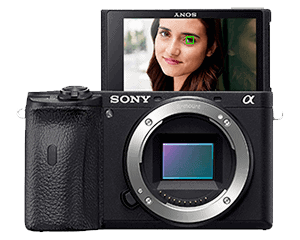
You can really get away with the standard lenses that come in most kits, but there are a couple of exceptions that you could splurge out for.
All Sony E mount lenses will fit onto the Sony A6XXX series (including the spectacular full-frame range, with a crop factor).
So if you are ever considering an upgrade to full frame and want to buy some new lenses for your APS-C sensor, you can fork out the money early and still use your lenses later on.
Best Wide Angle Lens
There’s really only one option in this range, and it’s the brilliant 10-18mm F4 . To this day one of the best photos we’ve seen taken of the Petronas Towers was taken with a Sony A6000 (older model) and this lens.
Best Portrait Lens
The Sony 50mm F1.8 is a great choice for a native portrait lens. It’s light, fast and cheap.
The quality is decent without being amazing, but it definitely does a wonderful job for what you pay for.
Otherwise step up to the FE 55mm F1.8 (read about it below), although this will give you a 85mm perspective on the APS-C sensor.
Best Zoom Lens
Keeping with the affordable and light range that makes for great travel camera lenses, we recommend the Sony 55-210mm f/4.5-6.3 .
For the amateur and hobbyist photographer, this will do just about everything you need and is a solid lens to have in your kit.
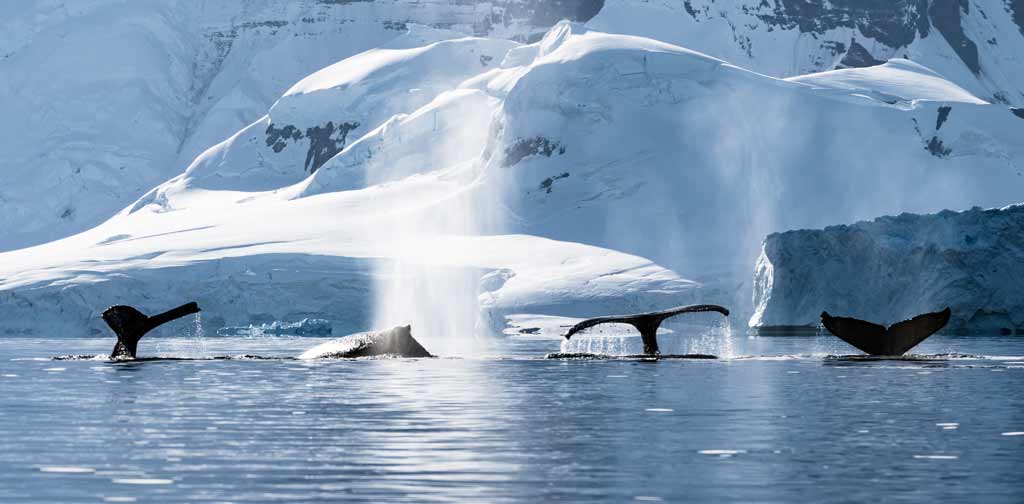
Sony A7iv – Best Professional Camera for Travel Photography
If you’re like us and want to make capturing the absolute best images of your travels a priority, then you’ll be looking at a professional range of travel cameras.
Following on from the discussion on mirrorless vs DSLR above, you’ll get many professional photographers who choose to stick to cameras like the Canon 6D or 5D series, or the Nikon D750 or D810.
These are legendary cameras in the industry, and with the enormous range of lenses available for each one, there’s a reason the best in the business use them.
But, we’re talking about travel cameras. And for this, we recommended sticking to mirrorless.
Full frame DSLRs are big and heavy, whereas their equivalent in mirrorless are a fraction of the size.
If you have decided you want to take the leap to a full frame sensor and want to be rocking the best mirrorless camera for travel, then you have only two choices.
READ MORE: But you need to carry everything, right? Here’s our new expert guide to the best camera backpacks on the market today!
Sony was the first major camera producer to create a full frame mirrorless camera, and while Canon has finally caught up, Sony has years of research and development on their side.
The Sony A7 series is almost flawless. Fantastic image quality, 4K video capabilities (on the A7R, A7S and the A7iv), articulating LCD screens, wifi, light, compact and a whole range of native lenses available for it makes them the absolute best cameras for traveling.
And with the Metabones adaptors you can even use your old Canon, Nikon, Sigma, Samyang or other type of lenses on it.
As of 2024, Sony’s top cameras are the A1, A7iv, A7Siii, A7Rv and the A9ii. Now while the A9ii, A7Rv and A1 are absolute beasts of cameras, the truth is you most likely don’t need all the features they have.
We currently own the A7iv and A7Rv, and for professional travel photography, they are the best on the market.
The image quality is superb and the dynamic range is insane. The low light capabilities are also amazing. Even at ISO 12800, there’s barely any noise that shows up on the shot compared to a compact camera.
We personally recommend the A7iv as the best travel camera out there , as it’s just damn near perfect, especially as a hybrid photo and video camera.
4K video with 60fps, a lightning-fast autofocus system, joystick control, touch screen, fast processor, upgraded full frame sensor and amazing battery life.
If you’re the kind of person that loves to blow up their images for print, or does a lot of cropping when you edit your shots, then that’s the only reason you’ll want to step up to the A7Rv, as it has a 62mp sensor.
But wait – isn’t the brand new Sony A7Rv the best in class right now? Yes, it is. However, while it is absolutely incredible and takes things up another notch, it’s quite expensive and the megapixel count is likely not something you need..
Instead we recommend that you save your money on the body, put what’s left over towards some lenses, and get the A7iv be your go to camera for travel photography.
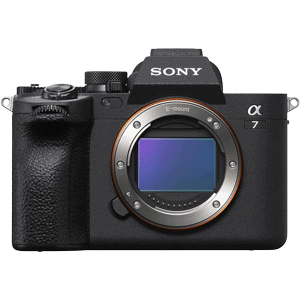
If you’re going for the Sony A7 series, we’ve got some bad news for you. Full frame lenses are expensive.
But if you’re considering turning your photography hobby into a profession, then this is a small sacrifice to make for the quality of photos you’ll be taking.
Trust us, if you’re buying the best camera for travel photography on the market, you’ll want to also have the best lenses to go with it.
The great thing with the Sony Alpha series is that their lenses are all interchangeable, meaning if you start out with a Sony A6600 and eventually upgrade to a Sony A7iv, you can take your old lenses and put them on the new camera (but it will have a crop factor).
Best All-Round Lens
The new FE 24-105mm f4 lens from Sony is pretty much the best all round travel zoom lens for photography.
It’s damn sharp, and with a constant aperture of f4, it means you can get excellent bokeh and decent low-light performance at any focal length.
This lens practically lives on our A7iv, as it’s so versatile, great for video and the image quality is fantastic.
The Sony 16-35mm f2.8 GM lens is one of the best wide angle lenses on the market, and when you throw it on your travel camera, you’re almost guaranteed to get fantastic shots.
Pretty much every review on photography sites raves about it, and having owned it for over three years now, we completely agree.
It’s not cheap, but to have such a fast and wide native lens for the Sony setup is pretty epic! If you want a cheaper alternative, check out the 16-35mm f4 , which is also very good.
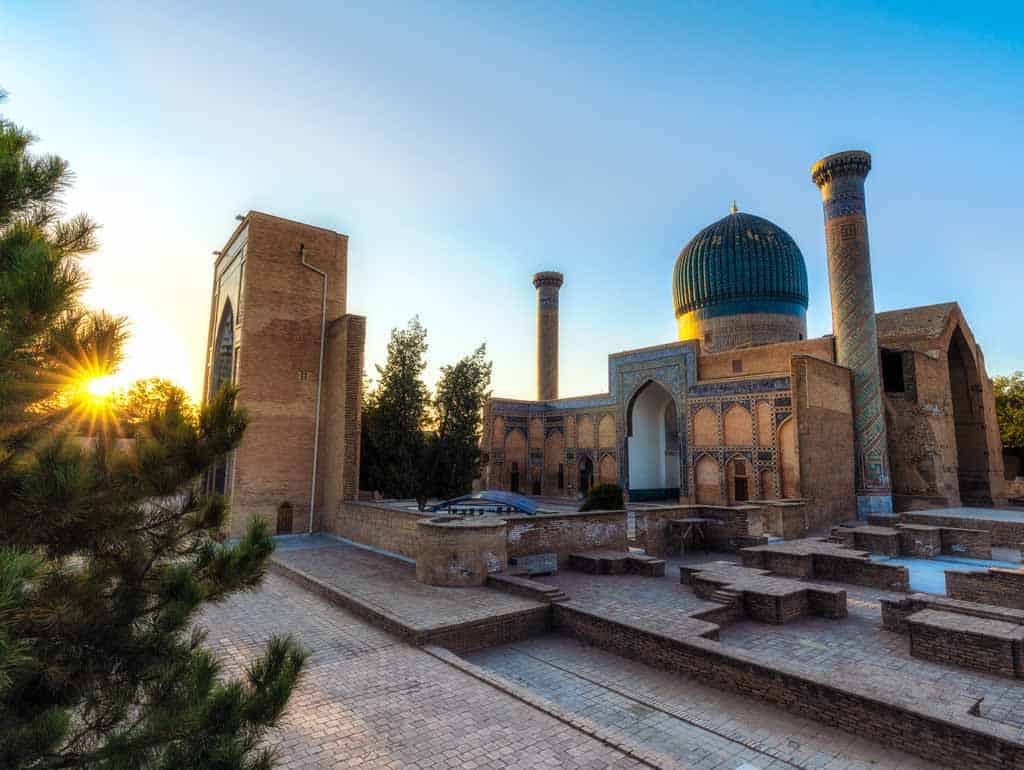
Best Prime Lens
If you are into portrait or street photography make sure you get the FE 55mm F1.8 prime lens.
It’s very fast, very light and very sharp. And with such a good value, it may be the best prime lens that Sony makes (excluding the high-end GM series).
Owning a telephoto lens isn’t just about taking photos of wildlife or zooming in on things that are far away from you. It adds a whole new creative element known as lens compression to your arsenal.
This is the optical illusion that happens when the further you zoom into something, the bigger the background appears.
You start to get this effect from around 100mm and on, so if you’re looking for the best zoom lens to put on your Sony A7iv, consider the 70-200 f2.8 GMii lens, or the 100-400mm GM lens .
We have both of these zoom lenses, and we love love love them!
DJI Mavic Air 2 – The Best Drone for Travel
Aerial photography has gained in popularity over the last two years, and it’s easy to see why.
Not that long ago the only way to get photos from the sky was by taking a chartered flight or helicopter.
But today just about anyone can go out, buy a drone and start taking shots from very unique angles.
The appeal is obvious. Capturing epic photos and video of landscapes from a perspective that few have ever seen before.
From the moment we bought our first drone (a DJI Phantom 4) we fell in love with it.
Good drones up until now have always been quite prohibitive when it comes to travel due to their bulky size.
The DJI Phantom series helped make it more accessible for most people, but even then it was still a commitment to travel with one.
Today the best drone for travel has finally been determined.
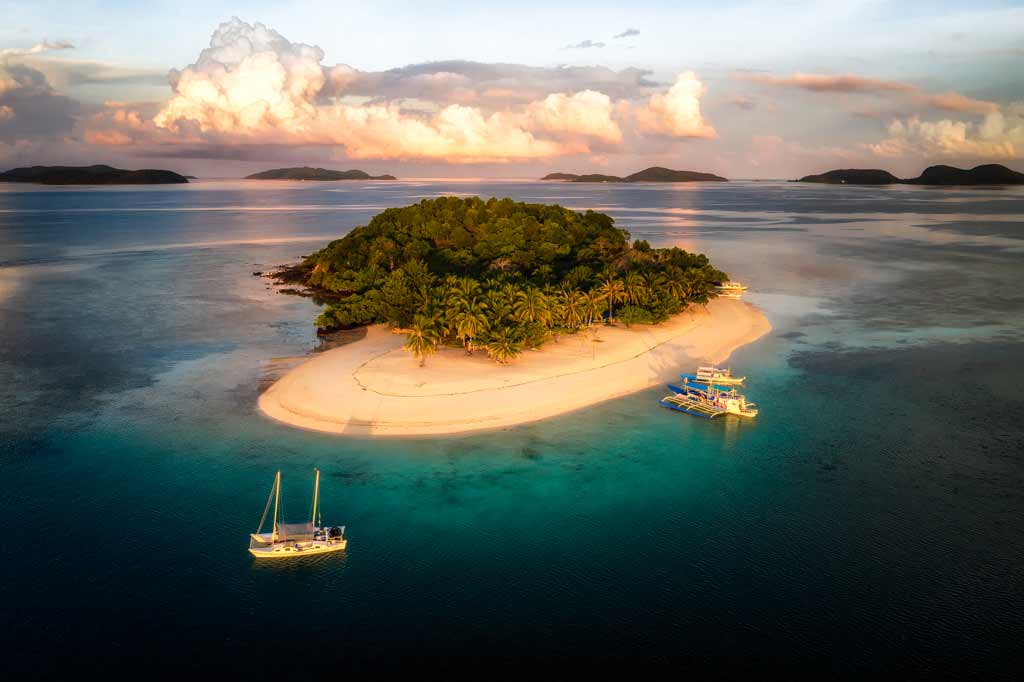
The DJI Mavic series is what you should be looking for when considering a travel drone.
With foldable legs and compact size, they tick all the boxes for portability.
There are a few different models to consider, and it really depends on your needs.
If you’re a professional, we recommend the DJI Mavic 2 Pro , thanks to its 1-inch Hasselblad Sensor and 360-degree collision avoidance.
But just announced is the Mavic Air 2 , and with features like 48-megapixel photo mode, panorama capabilities and 4k video, it’s the best option for anybody trying to take travel photos from the air on their next trip.
Its small size and great value makes it perfect for travel, but one thing to consider is the fixed focal length, meaning you can’t zoom in to take photos.
Note – With whatever drone you buy we highly recommend buying extra batteries. You’ll be surprised how quickly you chew through these. Check out the bundle packages from DJI (called ‘Fly More’ on the Mavics).
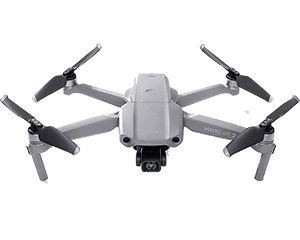
GoPro Max – Best 360 Travel Camera
With virtual reality becoming more and more popular, it might be no surprise that one of the best travel cameras for 2024 is actually a 360-degree camera!
These incredible little devices come with multiple cameras on one piece, managing to capture an entire scene in one shot in both photos and high definition video.
When they first came out they were very poor quality, but now they’ve improved enough that we actually travel with one full-time now.
360 cameras became popular when the Chinese company Insta360 started to bring out their affordable options, but the image quality was always pretty poor.
Then GoPro stepped onto the scene with the Fusion, and it changed the industry forever.
With all the standard great features GoPro is known for, such as being waterproof, having awesome connectivity and packing it all into compact cameras, the Fusion took things to the next level.
It did require a bit of work to use though, and the stitching wasn’t great. Plus with two SD card slots required to save media, it was just that bit too cumbersome for most photographers.
Cue the Max!
The GoPro Max took the best parts of all their cameras and threw it together into one unit with this one.
The Max, with its dual lenses on either side of the body, now uses just one SD card, making storage and management so much easier, and it has a touch LCD screen that can be used on the go.
For people looking for travel cameras that can do it all, it doesn’t just shoot in 360-degree mode.
There is their ultra-wide single perspective, and for having a small sensor, the low light shots are surprisingly good.
If you’re a travel vlogger you’ll be amazed at the quality of this! The inbuilt microphones do a great job at picking up audio while cutting out background noise, and the battery life is great.
It shoots at 5.6k video quality and 30 frames per second. You can change the pitch, yaw, field of view and angles to get the view you desire.
Even more unique, it can create 360 time-lapses and hyper lapses with a simple click. No need to pull it up in a program like Adobe Premiere Pro to make your videos any more!
Best of all it connects seamlessly to your smartphone using the GoPro app, so you can do all your editing, sticking and keyframing on the go.
When it comes to a travel camera that tries to do it all, this one is hard to beat.
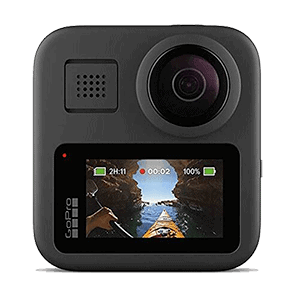
That concludes our list of the best cameras for traveling. Let us know if you have any other recommendations, or if you use any of these cameras while traveling the world!
How to Choose the Best Camera for Travel
No matter what level you are, the first piece of kit you are going to need to buy is the camera.
This can range from a cheap point-and-shoot right up to a top-of-the-line DSLR that can cost as much as a small car.
A quick visit to a camera store can leave you feeling completely overwhelmed with all the choices.
Keep on scrolling to find detailed information about each of these, and why they really are the best cameras for travel.
READ MORE: See what made the cut as the best travel tripod on the market in our expert guide!
What Features to Look for in a Travel Camera
There’s a number of different features that you need to look for when searching for the best travel camera to buy, based on your needs.
The first thing to look out for is how big and heavy a camera is.
When you’re on the road traveling, weight and space is a huge issue to overcome. You don’t want to be lugging around a heavy backpack full of gear if you don’t have to.
If you’re not a pro or a big enthusiast, we recommend checking out a compact camera or mirrorless camera, as they are smaller and more portable, while also providing decent image quality.
One thing that camera companies and salespeople like to preach about is megapixels. But what exactly does that mean?
A pixel is a tiny dot of color that you see on your computer or phone display. A megapixel is 1 million (actually 1,048,576 to be technically correct) of those dots. So ‘24 megapixels’ so about 24 million dots of color
You may hear that more megapixels equal better quality photos, but this isn’t entirely true.
The sensor has more to do with image quality than the resolution does, but it does play a small part.
In short don’t get caught up about more buying a camera with more megapixels, unless you’re planning on printing your images on billboards.
Instead just use this guide to the best travel cameras to find out exactly what is the best choice you can afford.
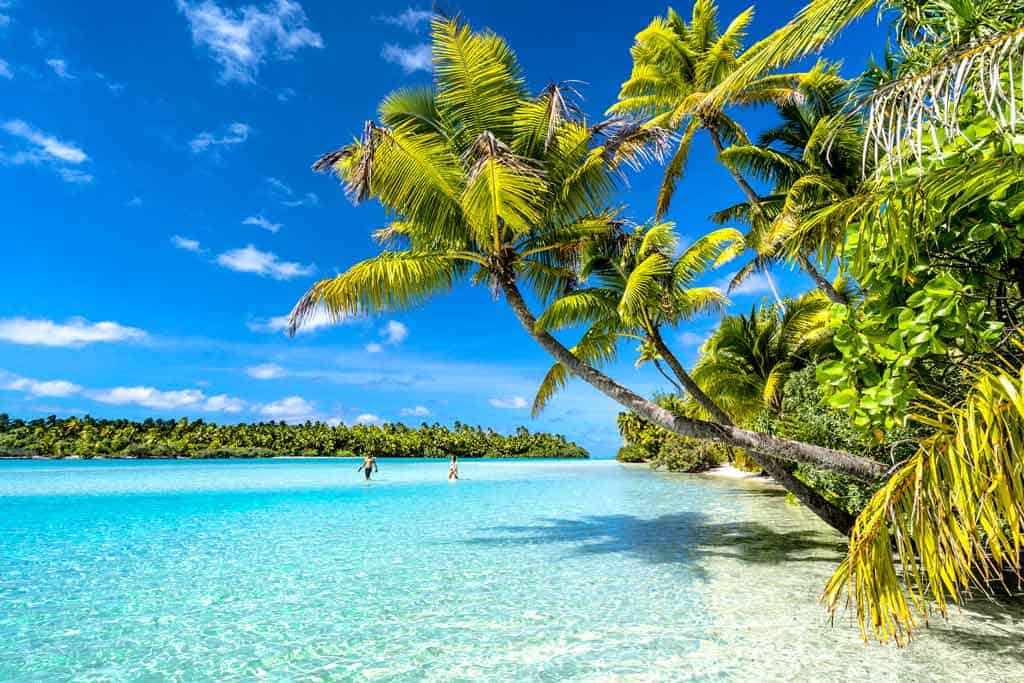
One thing to consider when looking at the best travel camera is whether or not you can change the lens.
The reason this is important is that it gives you more choices down the road if you decide you want to get into different styles of photography.
A compact travel camera is most likely a fixed lens, meaning that whatever zoom range it comes with you can’t change.
A camera that you can change the lens on will let you upgrade to wide-angle lenses, a zoom lens, better maximum aperture options for low light performance, etc.
In general, if you can afford a mirrorless camera or DSLR, it’s worth buying.
A camera that allows you to change the manual settings gives you complete control over things like aperture, ISO and shutter speed.
This opens up a whole new world of creativity, and in our opinion, you shouldn’t consider a camera that doesn’t have this feature.
Luckily every recommendation on this list allows you to control those settings, even the GoPro HERO camera below!
It’s 2024 – make sure you get a camera that can shoot 4K video!
This provides much higher resolution when shooting video, and even if you don’t have a 4K monitor at home, you can always take that clip and watch it in high definition 1080p, or even crop into your footage.
Just beware that 4K video chews up your battery life, so make sure you have some spare ones!
Unless you plan on always being in perfect weather when you travel, it’s a good idea to get a camera that is either waterproof, or has good weather sealing.
Unfortunately you often have to compromise on a waterproof camera or a quality travel camera (unless you buy a GoPro), so we don’t recommend buying a camera that is fully waterproof.
Instead just make sure it has decent sealing, or look at buying an underwater housing if you want to get into underwater photography.
How far you can zoom in on a subject is very important when trying to decide the best travel camera.
If you buy a fixed lens camera, make sure it has a long zoom range, like a Canon Powershot or the Sony RX100vii.
Or if you buy a mirrorless camera or DSLR, you don’t have to worry about this as you can always upgrade later.
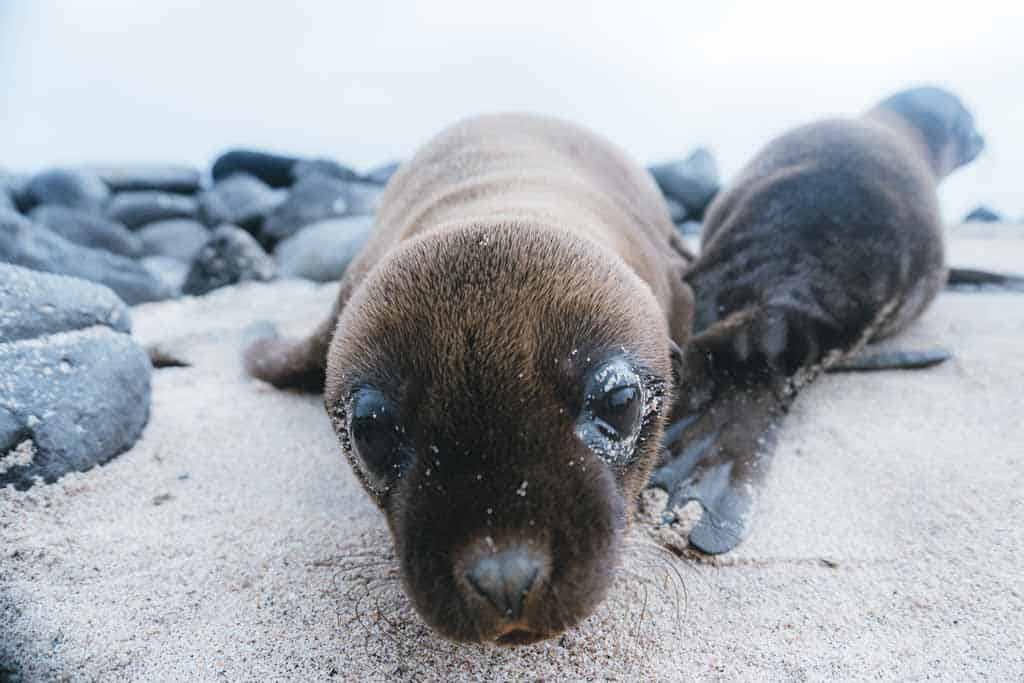
No matter how steady you think you are, you will almost always have a small amount of camera shake when taking handheld photos.
If you’re shooting at fast shutter speeds, this isn’t a problem. But if you’re photographing in low light, you can end up with motion blur.
Look out for cameras that have inbuilt image stabilization to counter this.
A DSLR ( digital single lens reflex ) works by having a mirror inside the camera. When you are looking through the viewfinder the mirror is down, covering the sensor, and you are looking at a reflected scene.
When you push the shutter the mirror flips up mechanically, allowing the image to be exposed onto the sensor, and then onto your SD card. All these moving parts take up room, hence why DSLRs are larger in size.
With mirrorless cameras, there are no moving parts inside. The image comes through the lens and directly onto the sensor.
There is an electronic viewfinder, meaning you are seeing a digital copy of what you’re pointing the camera at, rather than a live view.
So without a mirror constantly flipping, the camera can be made a lot smaller. That’s why mirrorless cameras can be half the size of a DSLR.
When mirrorless cameras first came out the quality wasn’t that great. Now they are just about on par with DSLRs, and the portability means that they are the best cameras for travel photography!
In case you’re not sure what we mean, this article goes into a bit more information, but in short, we recommend getting a mirrorless camera.
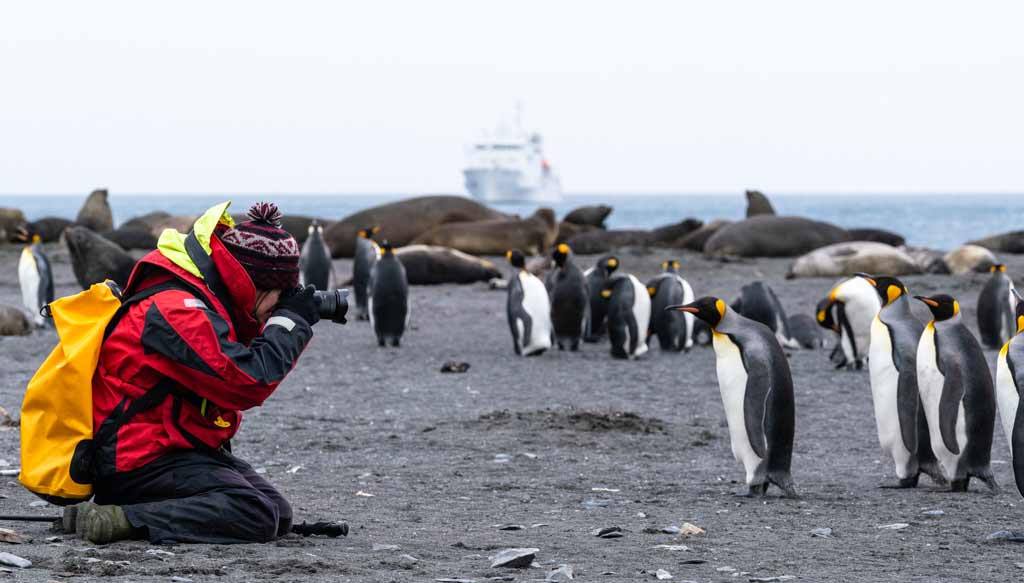
The 3 most popular cameras that pros use are the Canon 5Div, the Nikon D850 and the Sony A7Riv.
For general travel videos, the kind of stuff you would publish on YouTube, we recommend the Sony RX100vii. If you’re looking to create more cinematic videos, the A6600 is the best compact travel camera for videos.
If you need the best small camera for travel, you should buy the Canon SX740HS. Compact, high quality and affordable, this little beast is a fantastic travel camera.
DISCLAIMER: Some of the links in this article are affiliate links, which means if you book accommodation, tours or buy a product, we will receive a small commission at no extra cost to you. These commissions help us keep creating more free travel content to help people plan their holidays and adventures. We only recommend the best accommodations, tours and products that ourselves or our fantastic editorial team have personally experienced, and regularly review these. Thanks for your support, kind friend!
Alesha and Jarryd
Hi, We’re Alesha and Jarryd!

We’ve been traveling the world together since 2008, searching for the planet’s best destinations and adventures.
Love Travel?
Sign up for our free weekly newsletter for the best travel tips, ideas and deals!
We respect your privacy. Unsubscribe at any time.
READ MORE...
Protected: Sim Local eSIM Review (2024 Guide)
GoPro HERO 13 Review – The Ultimate Camera Guide [2024]
10 BEST Camera Backpacks for Travel [2024 Guide]
Leave a comment Cancel reply
Save my name, email, and website in this browser for the next time I comment.
- Reviews TV REVIEWS v1.11 HEADPHONES REVIEWS v1.8 MONITOR REVIEWS v2.0 SOUNDBAR REVIEWS v1.3 MOUSE REVIEWS v1.5 KEYBOARD REVIEWS v1.3.1 PRINTER REVIEWS v1.2 VACUUM REVIEWS v1.3 ROUTER REVIEWS v0.8 PROJECTOR REVIEWS v0.9 TOASTER REVIEWS v1.0 AIR FRYER REVIEWS v1.0 BLENDER REVIEWS v1.0 MICROWAVE REVIEWS v1.0 DEHUMIDIFIER REVIEWS v1.0 AIR PURIFIER REVIEWS v1.0 KEYBOARD SWITCH REVIEWS v1.0 SPEAKER REVIEWS v0.8 CAMERA REVIEWS v0.12.1 LAPTOP REVIEWS v0.8.2
- What's New COMPUTER Monitors, Mice, Keyboards, Printers, Routers, VPNs, Keyboard Switches, and Laptops HOME ENTERTAINMENT TVs, Soundbars, and Projectors AUDIO Headphones and Speakers HOME Vacuums, Dehumidifiers, Mattresses, Humidifiers, and Air Purifiers PHOTO & VIDEO Cameras KITCHEN Toasters, Air Fryers, Blenders, and Microwaves REVIEW PIPELINE See upcoming reviews, cast your vote, and suggest products
- Newsletters
- Compact Travel
- Table of Contents
- Best Camera
- Best Large Sensor
- Best Mid-Range
- Best Budget
- Best Vlogging
Notable Mentions
Recent updates, all reviews, the 5 best compact cameras for travel - fall 2024.

Point-and-shoot cameras are a natural choice for travel thanks to their compact sizes and built-in zoom lenses, making it a breeze to capture all your memories abroad without having to lug around a bulky kit with multiple lenses. While smartphone cameras have continued to improve, and they're usually the camera you've already got on you, some point-and-shoots offer improved image quality with larger sensors than the ones typically found in phones, while others offer longer zoom ranges that you simply can't get with the physically limited lenses on your smartphone.
We've bought and tested over 105 cameras in our lab, and below, you'll find the best pocket cameras for travel that we recommend in 2024. If you don't mind carrying a larger kit with interchangeable lenses, check out our picks for the best mirrorless cameras for travel . If you want to capture beautiful images of destination vistas, you might also want to check out our best cameras for landscape photography . Alternatively, if you're less interested in snapping places and more interested in the people that populate them, see our picks for the best street photography cameras .
Best Compact Camera For Travel

It ain't cheap, but the Sony RX100 VII is the best compact travel camera we've tested. Sony has perfected the formula for compact zoom cameras with its RX100 series. This latest model features a stacked 1-inch sensor that delivers blazing-fast burst rates and great image quality for its class, along with a pop-up viewfinder and flash, a large tilting screen, and a zoom lens—all packed into an incredibly portable camera.
While it doesn't have the widest zoom range on this list, its 24–200mm full-frame equivalent focal length still gives you a fair amount of range, offering some flexibility for framing and composition. The camera also has a highly effective autofocus system, ensuring your subjects stay in focus, even in busier settings. That said, like most compact cameras, it has a pretty short battery life, though you can always pack a spare battery or portable power bank to charge it on the go.
See our review
Best Large Sensor Compact Camera For Travel

While you'll still get great images from 1-inch sensor cameras like the Sony RX100 VII , there are a select few compact cameras that feature even larger sensors that'll give you better dynamic range and more flexibility in low light. The best of these is the highly popular Fujifilm X100VI. With one of the highest-resolution APS-C sensors on the market, it can capture images with stunning levels of fine detail. Beyond that, this is one of the most full-featured compact cameras you'll find, with a hybrid optical/electronic viewfinder, in-body image stabilization (IBIS), and advanced video features. Unlike the Sony, the built-in lens on the Fuji has a fixed 35mm equivalent focal length, so you'll have less flexibility with far-away subjects, but it delivers superior image quality and has a wider aperture.
All that said, this is not the most compact of compact cameras. It's substantially bulkier than the RX100 VII. If, however, you don't mind a more pared-down camera, the RICOH GR III makes for a fantastic alternative to the X100VI. It, too, uses a larger APS-C sensor and IBIS, but in a much more discreet and significantly more portable design. Of course, you'll be giving up a viewfinder and tilting screen here, but it's the best pocket camera for travel if you want something truly pocketable with a larger sensor for better image quality.
Best Mid-Range Compact Camera For Travel

If you want to save money, the Canon PowerShot G7 X Mark III is a great mid-range option. Like other Canon cameras, its user interface is highly intuitive. It has a comfortable finger grip and thumb rest, and the tilt-out screen can flip up for selfies or vlogs. Plus, it features a 1-inch stacked sensor and quick 16 fps burst shooting.
The built-in lens has a fairly versatile 24–100mm equivalent focal length, which is a shorter zoom range than the Sony RX100 VII but still wide enough to give you some flexibility with framing. That said, its autofocus system isn't quite as reliable. Otherwise, this camera has plenty to offer for travelers who want something compact and comfortable to shoot with.
Best Budget Compact Camera For Travel

The Canon PowerShot SX740 is one of the best point-and-shoot cameras to get if you're on a tighter budget. It uses a smaller sensor than the more premium options above, so there's a slight trade-off in image quality. On the upside, its built-in lens has a 40x optical zoom range, giving you a remarkably wide focal length range of 24–960mm. Though it doesn't have a viewfinder, the camera's tilt screen can flip up for selfies or waist-level shots, and it's incredibly portable.
Of course, the most cost-effective choice if your budget is really tight is to simply use your smartphone! Most smartphone cameras these days feature pretty impressive processing to compensate for their smaller sensors, which means you can still get great results despite some hardware limitations. The best part is that you've likely already got a smartphone on you, so it won't cost you anything extra or take up more space in your luggage. Still, if you want the shooting experience of a dedicated point-and-shoot camera, the PowerShot SX740 has quite a bit of value for its price.
Best Compact Vlogging Camera For Travel

While the previous picks are more photography-oriented, travel vloggers should take note of the Sony ZV-1, the best point-and-shoot camera for travel vlogging. Though it doesn't have a viewfinder, it's the only option on this list to feature a fully articulated screen, making it easy to monitor yourself while recording or to take the odd selfie. On top of that, it has vlogging-specific features like a detachable windscreen to reduce ambient noise when recording outside.
The Sony ZV-1 II has since replaced it and features a wider-angle lens that's a good fit for walk-and-talk vlogs. However, the newer model doesn't have optical stabilization, and its digital stabilization feature crops in some of that wider field of view. For those reasons, the original ZV-1 is still our top pick here, especially since you can get it for cheaper. It checks all the boxes for a compact, all-in-one travel vlogging camera.
- Panasonic LUMIX ZS80: The Panasonic LUMIX ZS80 is one of the best budget options you can get, offering a ton of value for its price, and unlike the Canon PowerShot SX740, it even has a viewfinder. However, it's been discontinued and is harder to find. See our review
Jul 30, 2024: We replaced the RICOH GR III with the Fujifilm X100VI as the 'Best Large Sensor Compact Camera For Travel' since it offers more features, but we've kept mention of the RICOH as a more portable alternative.
Jun 04, 2024: We replaced the Canon PowerShot G5 X Mark II with the Canon PowerShot G7 X Mark III as the mid-range pick because it has better availability. We also added mention of the HDF variant of the RICOH GR III.
Apr 10, 2024: We brushed up some of the text throughout the article for clarity and added a mention of the Fujifilm X100VI to ensure the article is up to date with the current market.
Mar 14, 2024: We've reviewed the article to ensure the text and recommendations are up to date.
Feb 14, 2024: Moved the Panasonic LUMIX ZS80 to the Notable Mentions because it's been discontinued and is hard to find in stock, and replaced it with the Canon PowerShot SX740 as the main budget pick.
Our recommendations above are what we think are currently the best point-and-shoot cameras for travel for most people, according to their needs. We factor in the price, feedback from our visitors, and availability (no cameras that are difficult to find or almost out of stock in the U.S.).
If you would like to choose for yourself, here's the list of all our compact fixed-lens camera reviews. Be careful not to get caught up in the details. There is no single perfect camera. Personal taste, preference, and shooting habits will matter more in your selection.
- Student Successes
- My Learning
6 Best Mirrorless Cameras for Travel in 2024

You can also select your interests for free access to our premium training:
Whether you’re a roving reporter or a sun-seeker, the best mirrorless camera for travel helps you capture memorable images on the go.
It’s best if you have a camera that’s compact, lightweight, and easy to carry. But you don’t want to compromise on photo or video performance. That’s why the best travel cameras are portable and powerful!
The Nikon Z50 is our choice as the best mirrorless camera for travel. It’s a compact APS-C mirrorless camera with excellent features for photography and videography. It’s beginner-friendly yet high-performance. And you can select the best travel glass from Nikon’s Z-range of lenses.
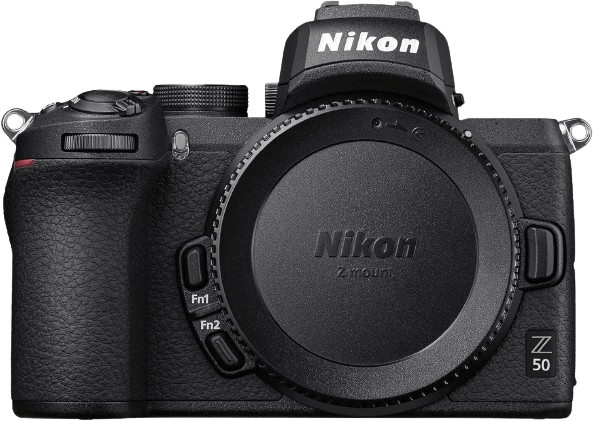
If you buy a product through one of our referral links we will earn a commission (without costing you anything). Prices last updated on .
As an Amazon Associate, I earn from qualifying purchases. Product prices and availability are accurate as of the date/time indicated and are subject to change. Any price and availability information displayed on Amazon at the time of purchase will apply to the purchase of this product.
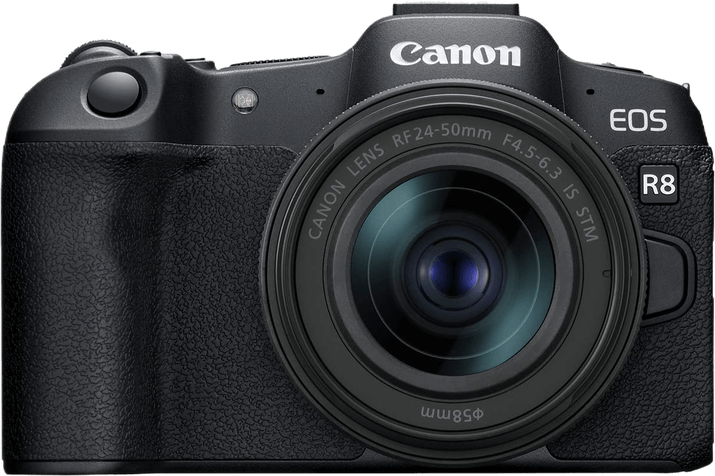
What Is the Best Mirrorless Camera for Travel?
The best mirrorless camera for travel should be portable but still produce eye-catching media. This is why the Nikon Z50 , Canon EOS R8 , and Fujifilm X100V are our top three recommendations.
Traveling is always a huge source of inspiration. And to capture the wondrous sights in all their glory, you need a reliable camera. For this reason, mirrorless cameras are perfect travel companions.
They are lighter and more compact than DSLR cameras. And they have more well-rounded features. As we’ll see in our list, many mirrorless models are complete hybrid cameras . This means they produce high-quality photographs and videos.
You also have a wider selection of mirrorless cameras available than DSLRs. Manufacturers are going full steam ahead with their mirrorless lines while phasing out DSLRs . Now’s the time to invest in a mirrorless travel camera!
Here’s a quick rundown of all the best cameras for travel with some pro points. We look at each camera in more detail in the section after. And we have an FAQ section at the end if you need more information about travel cameras and gear .
- High-quality images with 20.9 MP sensor
- Compact and lightweight, perfect for travel
- Excellent low-light performance with high ISO
- "Selfie" flip-down LCD touchscreen for vlogging
- Ease of sharing with built-in Wi-Fi and Bluetooth
- Exceptional 24.2 MP full-frame sensor
- Compact design with advanced functionality
- Versatile 24–50mm zoom lens option
- Built-in OLED EVF, vari-angle LCD touchscreen
- Outstanding 4K recording with oversampled 6K
- 26.1 MP sensor for superior image quality
- Advanced Hybrid Viewfinder to capture the perfect shot
- Tilting LCD touchscreen for intuitive controls, framing
- Weather-sealing option for tough conditions
- Stunning 4K video and super slow-motion footage
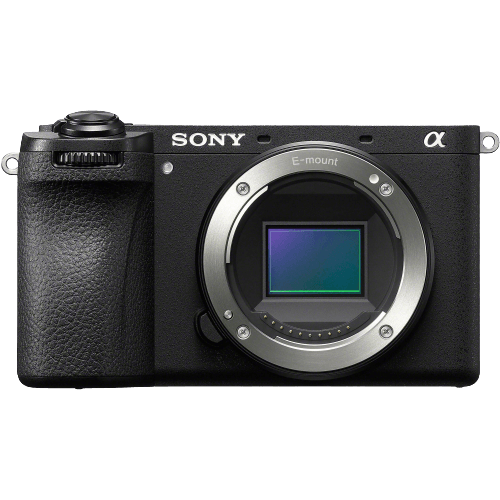
- 4K/60p 6K oversampled recording
- Pack a powerful 26 MP APS-C sensor
- Superior image quality with BIONZ XR processing
- AI and Real-Rime Recognition for precision tracking
- Lightweight, perfect for creative adventures

- High-quality images with 20 MP 4/3 Live MOS sensor
- Compact, lightweight for easy portability
- Provides 1,053 high-precision focus points
- Advanced high-res, ND, focus-stacking, HDR features
- Dustproof, splashproof, freezeproof

- Incredible 40 MP X-Trans 5 HR sensor
- Pixel-Shift Multi-Shot mode for 160 MP files
- Fast, action-freezing shutter speeds up to 1/180,000 s
- 7-stop in-body image stabilization
- Records up to 6.2K in 4:2:2 10-bit color internally
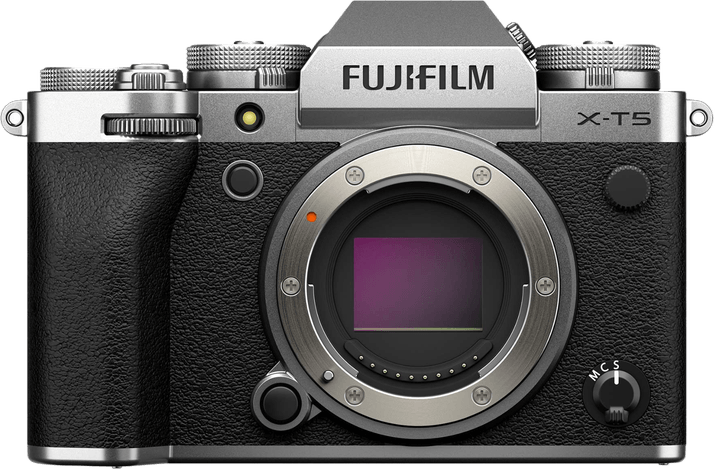
6 Best Mirrorless Cameras for Travel
Now, we look at all the best mirrorless cameras for travel in more detail. We’ve included a wide range of mirrorless cameras so everyone can find the best camera for them.
We have beginner-friendly APS-C cameras and full-frame models for more experienced travelers. It’s a short but optimized list of the best cameras for travel.
1. Nikon Z50
The Nikon Z50 takes the top spot as the best mirrorless camera for travel. It won’t be the right camera for every travel photographer. But its beginner-friendly design and feature set give it broad appeal. Even the most cynical users will be impressed by its results.
Its lightweight and compact body make it an easy fit for any travel camera backpack . Its decent level of environmental sealing protects the camera in dry or humid conditions. And it can even withstand light rain showers.
Nikon’s DX-format (APS-C) sensor produces lovely 20.9 MP images. While that resolution isn’t record-breaking, the image quality is fantastic. The images are bright and vibrant. And you get a low level of digital noise when working at higher ISO settings.
You can also enhance your travel photos on the go using the in-camera effects and filters. You don’t need a computer or photo editing software. It’s easy to add the filters in the camera’s interface and then send them to your smartphone using Wi-Fi connectivity.
With 4K video features, the Z50 is also a great camera for travel vloggers . It offers a frame rate of 30 fps (frames per second) at full resolution. And the flip-down screen makes it easy to record yourself. Webcam functionality lets you live stream or video call loved ones back home.
Face- and eye-detection autofocus (AF) is ideal for capturing environmental portraits as you pass through exotic places. The AF also tracks moving subjects and works well in low-light situations.
As you can see, this entry-level Nikon has plenty to offer the enthusiastic traveler. It’s also an affordable mirrorless camera . You can buy a brand new Z50 with a versatile kit lens .
2. Canon EOS R8
We’re confident in promoting the Canon EOS R8 as the best full-frame camera for travel. First, it’s one of the most compact and lightweight cameras . Second, it’s weather-sealed and rugged. Third, it has incredible features for photography and video.
You’ll find plenty of full-frame cameras with higher resolutions than 24.2 MP. But the R8 still captures the world around it with accuracy and vitality. The larger pixel size gives you a better dynamic range, meaning you get more detail from bright and dark areas.
A wide ISO range gives you plenty of flexibility with your exposure settings. Low-light performance is excellent, with very little noise. And you have a 50 ISO range for sunny days, helping you maximize picture quality.
This Canon camera is also a great option for traveling videographers. Its 4K video footage is sharp and crystal-clear, and its 60 fps frame rate at full resolution enhances the footage further. The 4K video is uncropped and has no 30-minute time limit.
When working in Full HD, you have faster frame rates, including a 180 fps mode for super-smooth slow-motion videos. You also have ports for external sound devices, like microphones. And the flexible vari-angle touchscreen helps you film from any angle.
The 100% AF frame coverage gives you incredible accuracy when focusing. It can detect heads, faces, and eyes, even working with cats, dogs, and other animals. And the advanced subject tracking helps you capture those more hectic moments.
The lack of image stabilization is disappointing. And there’s only one memory card slot. That means you’ll have to carry plenty of spare SD cards in a secure memory card case.
The EOS R8 is brilliantly versatile, delivering for photographers and videographers. It’s the perfect camera for the globe-trotting multimedia producer. And it’s the best Canon mirrorless camera for travel.
You need a slightly bigger budget to buy the R8 instead of the Z50 . But it’s worth it if you want a full-frame mirrorless camera that does almost everything ! There is also a versatile 16-50mm lens kit version you can buy.
3. Fujifilm X100V
There are many different types and styles of travel photography. Travel street photography is one of the most popular. If that’s how you like to shoot when traveling, we recommend the Fujifilm X100V .
Okay, the X100V isn’t exactly a mirrorless camera. Due to its fixed lens and rangefinder design, it’s more of a compact camera. But it’s packed with some of Fujifilm’s best mirrorless technology. And it’s such a great travel camera that we can’t leave it off our list.
The first thing you might notice is the stylish retro design. There’s no denying it looks fabulous. And that fixed lens has a 23mm focal length, giving you a lovely wide-angle field of view. It also has an f/2 max aperture, so the low-light performance is good too.
Unlike your standard compact camera, this Fujifilm camera packs a powerful 26.1 MP APS-C sensor. A quad-core X-Processor 4 processing engine backs this, and together, they make a formidable team.
The image quality is truly breathtaking. It beats many other interchangeable-lens cameras in this category.
Fujifilm’s unique film simulation modes give images a retro look that matches the camera’s design. These modes have special filters for some of Fujifilm’s most famous film stocks. Thus, you get the classic film aesthetic without the hassle and expense of using an analog camera.
Analog cameras can’t shoot sharp 4K video, but the Fujifilm X100V can. It even records 10-bit 4:2:2 color via the HTML port. And you have slow-motion frame rates in Full HD quality. You can even apply the film simulation effects to your high-res video footage.
Manual on-body controls round out the retro camera style, giving you a more traditional, hands-on experience. The camera is a bit heavy for its size, weighing 1.05 lb (478 g). But the build quality is exceptional, and the weather sealing gives you peace of mind when shooting outdoors.
The Fujifilm X100V is proving evermore popular with street and travel photographers. Its weight is a problem if you like traveling light. And its price means you must take extra care when you travel through dangerous countries. But those who buy one rarely regret it.
4. Sony a6700
The a6700 is the perfect travel camera if you’re a filmmaker with a severe case of wanderlust. It has all the camera features for vlogging and streaming. Its video quality is good enough for professional travel videographers. But it’s pretty good for still photography, too.
We’ve grown accustomed to mirrorless cameras with 4K video . But not all 4K video is equal. The Sony a6700 produces 4K video superior to most of its rivals despite its compact size and light weight. The video quality is sharp and clear.
The video is also uncropped and has no time limit other than battery power. It uses 10-bit 4:2:2 color sampling, enhancing the quality even further. It even gives you faster frame rates, like a 120 fps option at full resolution. That’s spectacular 4K slow-motion footage!
You can leave your camera gimbal at home when traveling with this Sony mirrorless . It has five-axis image stabilization and gyroscopic video stabilization. So you can shoot hand-held without fear of camera shake ruining the shot.
A 26 MP resolution sensor means you can also snap gorgeous travel shots. The expanded ISO range gives you excellent flexibility in variable conditions. And there is very little noise at the top end. There’s even a 50 ISO setting for those bright sunny days.
A 759-focus-point AF system is impressive for an APS-C mirrorless. The speed and accuracy are outstanding. And the subject detection and tracking work well in low-light situations. Face- and eye-detection help you snap portraits of the people you meet on your travels.
The battery life is excellent, even when shooting 4K videos. It’s compatible with fast UHS-II SD cards, which is another bonus for videographers. The weather-sealing makes it a durable camera for adventurous media makers .
The Sony a6700 is the definition of a hybrid camera. The videography and photography features are impressive by any standards. And the size and durability make it one of the best mirrorless cameras for travel.
5. Olympus OM System OM-5
The Olympus OM System OM-5 is compact, rugged, and packed with features. It might only have a small Micro Four Thirds camera sensor, but it holds its own compared to other mirrorless cameras.
It’s a great camera for producing high-quality video content . And overall performance belies its compact size. A 20 MP resolution gives you lovely image quality with a true-to-life color rendition.
But if 20 MP isn’t enough, you can switch to the high-res shot mode for more. It creates a composite of several exposures, giving you stunning 50 MP images. You can even use this mode without a tripod!
You can also play with the camera’s built-in HDR mode. It works similarly, using several exposures for one image. The camera combines them, so you don’t need a computer or editing software. The same goes for the focus stacking mode.
Five-axis image stabilization gives you even better control over your exposure settings. And an advanced 1053-point AF system keeps everything in focus. It handles human faces well and tracks fast-moving subjects.
Recording 4K video at 30 fps means this OM System camera is a great choice for video makers. The rotating touchscreen helps you shoot vlogs or streams. And you can hook it up with external audio devices like microphones.
It even has a vertical video mode. This helps you produce social media-optimized video content.
USB charging is a big bonus on a travel camera. It means you can charge up whenever you find a cafe or social venue. You can also take a portable power bank to keep yourself topped up at all times.
The Olympus OM System OM-5 is a rugged mirrorless camera. It’s weather-sealed against rain and dust. And it even works in sub-zero temperatures, which is good news for Arctic explorers.
You can take this camera anywhere, and it will still work. This is exactly what you need from the best travel camera!
6. Fujifilm X-T5
The Fujifilm X-T5 is one of the most powerful APS-C mirrorless cameras ever. Its retro-style body design looks fabulous and is reasonably compact. This Fujifilm camera is ideal for travel photographers who want high-resolution images.
A 40.2 MP resolution would be impressive enough on a full-frame camera. But on an APS-C model, it’s truly breathtaking. The level of detail is intense, and the colors have a deep richness. This is perfect for capturing the sights as you navigate the globe.
The expanded high ISO setting of 51,200 is somewhat limited. But the camera’s low-light performance is generally strong . It also has a 64 ISO low setting, helping you get the most out of the 40.2 MP sensor.
You’re also not only limited to 40.2 MP. The X-T5 takes picture quality to a whole new level with the Pixel-Shift Multi-Shot mode. It creates a composite of several exposures using the image stabilization system. And the final result is a phenomenal 160 MP image.
The video specs are just as impressive, with 6.2K video resolution and 10-bit 4:2:2 color rendering. Video recording at 6.2K is limited to a 30 fps frame rate. But you can shoot at 60 fps in 4K, which is uncropped, and there’s no time limit. It also doubles as a high-resolution webcam.
In-body stabilization helps keep your images sharp and your videos shake-free. The advanced AF system also recognizes subjects like humans, animals, cars, and airplanes!
A strong 580-shot battery life keeps you snapping for hours on end. Using the Pixel-Shift mode or recording in 6.2K drains the battery quickly. But the USB charging capability lets you top up on the go.
The Fujifilm X-T5 might be overkill for some travel photographers. But if you want incredible high-resolution travel images, this camera delivers . It’s also weather-sealed, so it’s rugged enough for a life chasing horizons.
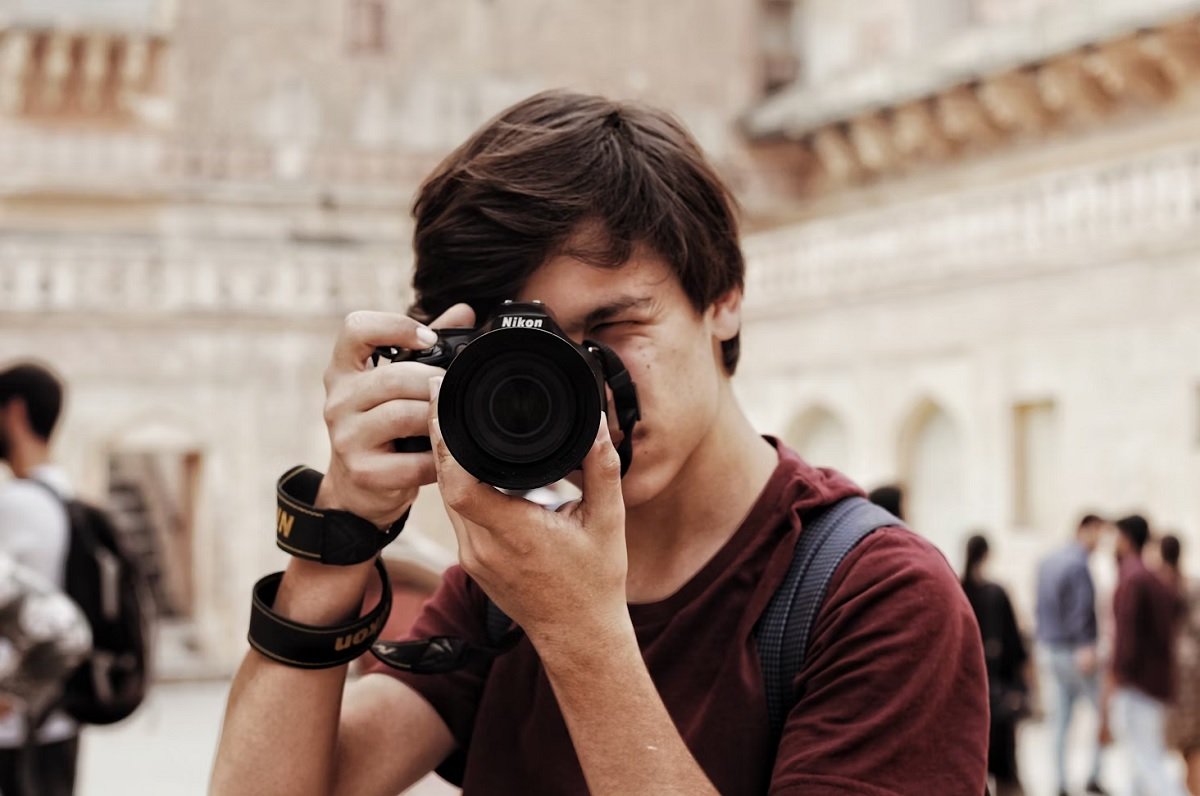
Best Cameras and Gear for Travel FAQs
One key to successful travel photography is getting the right gear. Of course, a good travel camera is the top priority. But that’s not the only equipment you need before you set off. Here is some info on other gear a travel photographer might need .
What’s the Best Compact Camera for Travel?
True compacts like the Panasonic Lumix ZS200 are brilliant travel companions. You can carry the ZS200 in your pocket—it’s that small! Yet it offers 20 MP images from a one-inch sensor and 4K video recording.
As a compact or point-and-shoot camera , it has a fixed lens. It’s a Leica lens, so the optical quality is excellent. And it gives you a 15x optical zoom for incredible versatility.
Vloggers and travel video makers might prefer the Sony ZV-1 II . With 4K video, a built-in microphone, and a rotating LCD screen, it has everything a vlogger needs. It even has special cinematic vlogging modes to help your content stand out.
We included the Fujifilm X100V on our list. It’s technically a compact camera. But it’s a bigger camera and has more features in common with a mirrorless camera.
If you want a smaller travel camera, see our full article for all the best compact cameras for travel . These pocket-sized machines are perfect for international travel. And they are all-in-one units, so there’s no need for extra gear like lenses.
What’s the Best Travel Camera Backpack?
If you’re traveling with a lot of high-end camera gear, we recommend the Manfrotto PRO Light Multiloader . We reviewed and scored 18 of the best camera backpacks , and the Multiloader came out on top.
This camera backpack has everything a photographer needs. It has plenty of storage space for your gear and extra pockets and pouches for other essentials. It has padded shoulder straps, a chest strap, and back padding for added comfort.
Exceptional build quality gives you peace of mind. It can endure a lot of tension and strain, so you know this backpack won’t fall apart on the first trip.
Every little detail has been thought through. Nothing is random or there for the sake of it. It’s one of the most well-designed camera backpacks a photographer can buy.
Read our in-depth review of the PRO Light Multiloader .
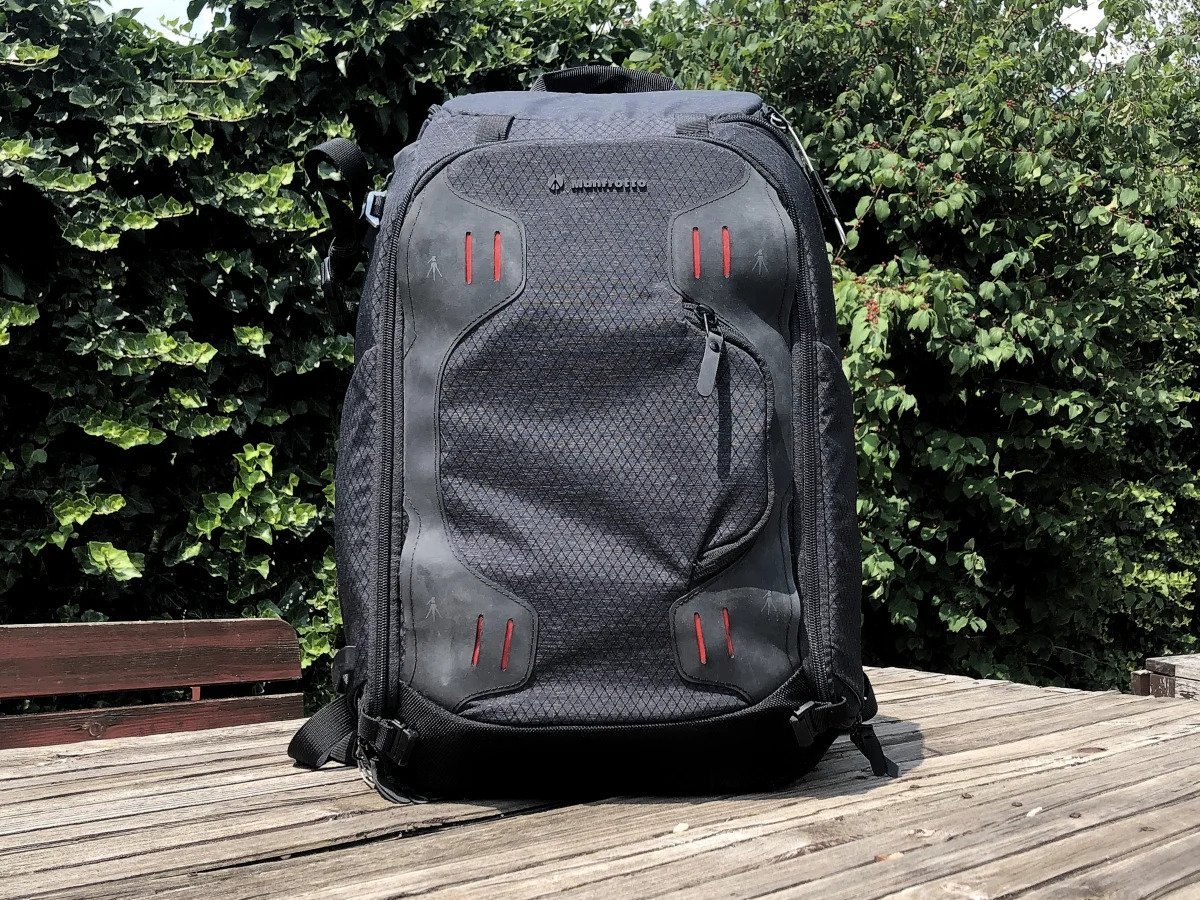
If you want something smaller for day trips, the Wandrd Duo Daypack is the perfect solution. Its overall quality is brilliant, and the durable materials make it a robust day bag. The outer nylon is waterproof, and rubber-covered zippers create a weather-sealed cocoon for gear.
It has a sleek and subtle design. It doesn’t look like a camera backpack, so you’re not making yourself an easy target for thieves in dangerous countries. But it also protects your camera equipment.
There’s also a unique “pop camera cube” for your mirrorless. And there are extra padded pockets for lenses and other photography accessories.
Check out our full Duo Daypack review for a detailed look at this fabulous camera backpack.
Every travel photographer needs a reliable camera backpack to carry their gear. It’s best not to travel with a mirrorless camera unless you have a spacious and protective camera backpack .
What’s the Best Travel Tripod?
The K&F Concept Lightweight Tripod is the perfect option for travelers. It weighs 2.4 lb (1.1 kg) with a folded size of 15.3 inches (39 cm), making it easy to attach to your camera backpack.
It’s also a strong tripod with a maximum load capacity of 17.6 lb (8 kg). That’s enough for any mirrorless cameras on our list, even if you’re using larger lenses.
Telescopic legs and a ball head give you excellent mounting flexibility. An Arca-Swiss-type quick-release plate makes mounting and dismounting the camera super easy. And it’s a versatile tripod you can take anywhere.
Traveling with lots of gear can be a pain. So you have to make sacrifices when choosing what to take with you. But even if you’re traveling light, you can still pack a handy travel tripod .
Conclusion: Best Mirrorless Camera for Travel
The best mirrorless camera for travel is compact and lightweight but still delivers eye-catching media. And all the cameras we’ve listed today hit that brief. Whether you’re shooting stills or video, a travel camera on our list will meet your needs.
The Nikon Z50 is our top mirrorless camera for travel. It has a compact camera body that’ll fit in any camera backpack. You get gorgeous photographs and video footage. And it has creative features for curious travel photographers.
More experienced photographers prefer the EOS R8 with its full-frame sensor and advanced features. Street-style travel photographers will love the X100V . Traveling videographers should consider the a6700 . There’s a mirrorless travel camera for everyone!

Discover the Best Mirrorless Camera for Travel 2023
Table of Contents
Are you ready to capture your travel adventures like never before? Look no further!
We’ve scoured the market to bring you the best mirrorless cameras for travel in 2023. These cutting-edge devices are a game-changer, revolutionizing the way we document our journeys.
Say goodbye to bulky DSLR cameras and limited point-and-shoot cameras , and hello to lightweight yet powerful companions that will take your travel photos to new heights.
With advancements in mirrorless camera technology, capturing breathtaking landscapes and vibrant street scenes has never been easier.
The latest features and innovations will enhance your photography experience, allowing you to effortlessly freeze those precious moments in time.
It’s time to upgrade your gear and embark on a visual journey with these top-rated mirrorless cameras. Whether you’re a seasoned pro or an enthusiastic beginner looking for a great beginner mirrorless camera , these devices will unlock endless possibilities for stunning travel photos.
So buckle up, fellow wanderlust enthusiasts! Get ready to explore the world armed with the best mirrorless cameras of 2023.
Your next adventure awaits, and it’s time to seize it with style and precision. Let’s dive into this captivating world of travel photography together!

Note: This blog post is not sponsored by any specific brand or manufacturer. Our recommendations are solely based on expert opinions and thorough research.
Key Highlights
- Mirrorless cameras are the best choice for travel photography, offering portability and advanced features.
- Sony Alpha 7C is a versatile option with intuitive controls, high-resolution sensor, and impressive autofocus for both beginners and experienced photographers.
- Sony a7R IV is a powerful full-frame mirrorless camera with outstanding image quality, advanced autofocus, and excellent low-light performance.
- Olympus OM-D E-M1 Mark III offers a compact design, weather-sealed construction, and advanced image stabilization, making it an ideal choice for travel photography.
- Canon EOS R and Nikon Z series are great options offering full-frame image quality, versatility, and a wide range of compatible lenses for travel photography.
Top 3 Travel Mirrorless Cameras Ranked


#1 Sony a7R IV

#2 Sony a7C

#3 Canon EOS R
Top mirrorless cameras for travel photography.
Are you an avid traveler looking to capture stunning travel photos? Look no further! We have curated a list of the best mirrorless cameras specifically designed for travel photography. These compact and lightweight marvels will not only help you document your adventures but also ensure that each shot is a masterpiece. Let’s dive into the key features that make these mirrorless cameras stand out from the rest, and discover why professional photographers choose them for their travel assignments.

Explore a Curated List of the Best Mirrorless Cameras for Travel
There are several factors to consider. The first on our list is the best budget mirrorless camera . Traveling can be expensive, so it’s important to find a camera that offers excellent value for money without compromising on quality. The Canon EOS M50 is an outstanding option in this category if you’re looking for affordable camera options in the sub-$500 price range . It provides exceptional image quality, versatile shooting modes, and a user-friendly interface.
Next up is the intermediate-level mirrorless camera , which caters to both beginners interested in becoming a professional travel photographer and experienced photographers alike.
The Sony Alpha 7C strikes the perfect balance between ease of use and advanced features. With its intuitive controls, high-resolution sensor, and impressive autofocus capabilities, this camera ensures that capturing those precious travel moments becomes effortless.
If you’re looking for a camera that offers exceptional image quality with superb low-light performance, then consider a full-frame mirrorless camera .
The larger sensor size allows more light to be captured, resulting in breathtaking shots even in challenging lighting conditions. The Sony a7R IV is one such gem that delivers outstanding dynamic range and detail while maintaining portability—a must-have companion for any serious travel photographer.

Capture Unforgettable Moments with Top-Notch Mirrorless Cameras
One of the advantages of mirrorless cameras is their compact size, making them ideal for travel. The compact mirrorless category focuses on portability without compromising on image quality. With its sleek design and lightweight build, the Canon G7X mark III fits perfectly into your travel bag while delivering exceptional performance. Say goodbye to lugging around heavy gear without sacrificing the ability to capture stunning shots.
Travel photography often involves capturing fast-moving subjects or fleeting moments.
This is where autofocus performance becomes crucial.
The budget mirrorless camera excels in this area by offering lightning-fast autofocus capabilities, ensuring that you never miss a shot while exploring new destinations.
Its advanced tracking system and precise subject detection make it a top choice for travel photographers who need speed and accuracy.

Not limiting yourself to mirrorless cameras? Check out our ultimate best camera for travel guide (all types!)
Our Best Camera for Travel Guide covers all types of cameras, not just mirrorless options like this article, so check it out to see what we think of DSLRs, compacts, action cameras and more!
1) Sony a7R IV : Powerful Full-Frame Option

If you’re on the hunt for the best mirrorless camera for travel, look no further than the Sony a7R IV . This powerhouse of a camera offers an array of features that will elevate your photography game to new heights. Let’s dive into why the Sony a7R IV is such an impressive choice for capturing your travel adventures.
- Compact and Lightweight
- Electronic Viewfinder (EVF)
- Video Capabilities
- Interchangeable Lenses
- Silent Shooting
Advanced Autofocus System
- Battery Life
- Ergonomics and Handling
- Heat Generation
Limited Lens Selection
Check out this in-depth video review of the Sony A7 IV.
Unparalleled Image Quality with High-Resolution Full-Frame Sensor
One of the standout features of the Sony a7R IV is its high-resolution full-frame sensor. With an astonishing 61 megapixels, this camera delivers unparalleled image quality that will bring your travel photos to life.
Whether you’re capturing sweeping landscapes or intricate details, the level of detail and clarity in each shot is truly remarkable.
The large full-frame sensor allows for excellent light-gathering capabilities, resulting in vibrant colors and stunning dynamic range . Every nuance and texture will be faithfully reproduced, allowing you to relive your travel memories with breathtaking realism.
Impressive Autofocus System for Capturing Fast-Moving Subjects
When you’re exploring new destinations, there’s always something exciting happening around every corner. That’s where the Sony a7R IV ‘s autofocus system shines. Its advanced technology ensures that even fast-moving subjects are captured with precision and accuracy.
The camera boasts 567 phase-detection autofocus points that cover approximately 99% of the frame.
This extensive coverage means that no matter where your subject is within the frame, you can trust that it will be in sharp focus. From bustling city streets to wildlife encounters in nature, you’ll never miss a moment with this fantastic autofocus system.

Exceptional ISO Performance for Low-Light Shooting
Travel often presents unique lighting challenges, especially when exploring dimly lit interiors or capturing mesmerizing sunsets. The Sony a7R IV rises to these challenges with exceptional ISO performance capabilities.
With an ISO range of 100-32000 (expandable to 50-102400), this camera excels in low-light conditions.
You can confidently shoot in challenging lighting situations without compromising image quality.
The noise reduction algorithms built into the camera ensure that even at higher ISO settings, your photos will retain impressive detail and clarity.

Advanced Video Recording Capabilities for Photography and Videography
The Sony a7R IV isn’t just a powerhouse for photography; it’s also an excellent choice for videography during your travels.
With its advanced video recording capabilities, you can capture cinematic footage that truly brings your adventures to life.
The camera supports 4K video recording at up to 30 frames per second, ensuring smooth and detailed footage. It offers various picture profiles and color grading options, allowing you to unleash your creativity and achieve the desired look for your videos.
Whether you’re documenting bustling city streets or capturing breathtaking landscapes in motion, the Sony a7R IV ‘s video capabilities make it a versatile companion for both photography and videography enthusiasts.

2) Compact Powerhouse: Sony Alpha 7C

Looking for a mirrorless camera that combines portability with exceptional image quality? Look no further than the compact yet powerful Sony Alpha 7C . This camera is designed specifically for travelers who don’t want to compromise on their photography experience while on the go.
The Sony Alpha 7C is packed with innovative features that make it an ideal companion for your travel adventures. With its lightweight design, you can easily slip it into your backpack or carry-on without adding unnecessary bulk. But don’t let its size fool you – this camera delivers stunning image quality thanks to its advanced sensor technology and impressive low-light performance.
- Compact and lightweight design
- Advanced sensor technology
- Wide range of compatible lenses
- Fast and accurate autofocus system
- The menu system can be complex and overwhelming for beginners
- The camera lacks in-body image stabilization
- The camera’s price point may be higher compared to some other mirrorless cameras in its class
Check out this video review of the Sony A7C.
One of the standout features of the Sony Alpha 7C is its flexibility. It offers a wide range of shooting modes and customizable settings, allowing you to capture every moment exactly as you envision it. Whether you’re photographing landscapes, portraits, or narrowing down a selection of the best street photography cameras , this camera adapts effortlessly to any situation.
With built-in Wi-Fi and Bluetooth connectivity, sharing your travel photos has never been easier. Simply connect your camera to your smartphone or tablet and instantly transfer images to your favorite social media platforms . Stay connected with friends and family back home by sharing breathtaking snapshots of your journey in real-time.

3) Canon EOS R

The Canon EOS R is a notable addition to Canon’s line of mirrorless cameras, designed to provide photographers with exceptional image quality and versatility.
With its 30.3-megapixel full-frame CMOS sensor, the EOS R delivers stunningly detailed images and excellent low-light performance. The camera’s DIGIC 8 image processor enhances processing speed and overall performance, enabling continuous shooting at up to 8 frames per second. One of the standout features of the EOS R is its innovative RF lens mount, which allows for high-quality optics and opens up new creative possibilities for photographers.
The camera’s Dual Pixel CMOS AF system provides fast and accurate autofocus performance, making it ideal for capturing both stills and videos. The fully articulating touchscreen LCD and high-resolution electronic viewfinder further enhance the shooting experience by providing multiple ways to compose and review images.
- Impressive Image Quality
- RF Lens Compatibility
- Dual Pixel CMOS AF
- Touchscreen Interface
- 4K Video Capabilities
- Compact Design
- Limited Lens Selection (initially)
- Single Card Slot
- 4K Video Crop
Check out this video review of the Canon EOS R.
The Canon EOS R offers a blend of impressive imaging capabilities and advanced features, making it a strong choice for photographers seeking high-quality results in both still photography and videography. However, its pros and cons reflect considerations that potential users should keep in mind based on their specific needs and preferences.
4) Innovative Vlogging Companion: Sony ZV-E1

If vlogging is more your style, then the Sony ZV-E1 is the perfect choice for capturing your travel experiences. This camera is designed with content creators in mind, offering a flip-out screen that allows you to easily frame yourself while recording videos.
- High-quality video and image output
- Built-in image stabilization
- Convenient flip-out screen
- No headphone jack
- Limited customization options
- Limited external accessory support
- Limited buffer capacity
Video review .
The touchscreen functionality of the Sony ZV-E1 adds another layer of convenience when navigating through menus and adjusting settings. With just a few taps on the screen, you can quickly access various shooting modes, adjust exposure settings, or switch between photo and video mode.
Not only does the Sony ZV-E1 excel in vlogging, but it also delivers impressive image quality for still photography.
Its advanced autofocus system ensures sharp and accurate focus, even in challenging lighting conditions. Whether you’re capturing stunning portraits or documenting the vibrant street scenes of your travels, this camera will exceed your expectations.
To enhance your vlogging experience further, Sony offers a wide range of accessories specifically designed for the ZV-E1 . From external microphones to versatile tripods, these accessories allow you to take your content creation to the next level.

Versatility at Your Fingertips
Both the Sony Alpha C and Sony ZV-E1 provide manual control options that give you complete creative freedom over your shots. Adjust aperture, shutter speed, and ISO settings to achieve the desired effect in any lighting situation.
The intuitive controls make these cameras excellent for beginners to get started while offering advanced features for more experienced photographers. Whether you prefer shooting in auto mode or taking full control of every aspect of your images, these cameras cater to all skill levels. Check out this article about the best beginner mirrorless cameras for more great reccomendations.
While both models excel in their respective areas, it’s important to consider some factors before making a decision.
The Sony Alpha C boasts an APS-C sensor that delivers exceptional image quality but may have limitations when compared to full-frame sensors like those found in the Sony ZV-E1 or other high-end mirrorless cameras.
Availability information is another crucial factor to consider when choosing between these two cameras. Check online retailers like Amazon for current availability and pricing options as they often offer competitive prices and reliable customer service through their Amazon Associate program.

5) Olympus OM-D E-M1 Mark III : Compact and Feature-Packed Travel Camera

If you’re a travel enthusiast looking for the best mirrorless camera to accompany you on your adventures, look no further than the Olympus OM-D E-M1 Mark III . This compact camera is not only lightweight but also packed with features that make it an ideal companion for capturing stunning travel photos.
- Professional-grade Micro Four Thirds mirrorless camera.
- Excellent image quality with a 20.4MP Live MOS sensor and TruePic IX processor.
- Advanced 5-axis in-body image stabilization for steady handheld shooting.
- Smaller sensor size may have limitations in low-light compared to larger sensors.
- High price point, geared towards professional photographers and enthusiasts.
- Limited lens selection compared to full-frame systems.
One of the standout features of the Olympus OM-D E-M1 Mark III is its compact size.
Weighing in at just under a pound, this camera allows you to embrace lightweight travel without sacrificing functionality. Gone are the days of lugging around heavy gear while exploring new destinations. With the Olympus OM-D E-M1 Mark III , you can pack light and still capture incredible shots.
In addition to its compact design, this camera boasts a weather-sealed construction.
This means that you can take it with you wherever your travels may lead, even in challenging shooting conditions. Whether you find yourself amidst a sudden downpour or in dusty environments, the Olympus OM-D E-M1 Mark III will continue to perform reliably, allowing you to focus on capturing those memorable moments without worrying about damaging your equipment.

Another key feature that sets this camera apart is its advanced image stabilization technology.
Travel photography often involves capturing scenes on-the-go, which can sometimes result in blurry images due to hand movement or vibrations. However, with the Olympus OM-D E-M1 Mark III ‘s powerful image stabilization system, these concerns become a thing of the past. You’ll be able to achieve sharp and blur-free images even when shooting handheld or in low-light conditions.
This camera offers an array of options to enhance your travel photography experience. With various shooting modes and creative features at your disposal, you have the freedom to experiment and capture unique perspectives of your surroundings. Whether it’s playing with different exposure settings or utilizing artistic filters, the Olympus OM-D E-M1 Mark III allows you to unleash your creativity and add a personal touch to your travel photos.
In terms of specifications, the Olympus OM-D E-M1 Mark III is equipped with a micro four thirds sensor. While some may argue that larger sensors offer superior image quality, the micro four thirds sensor in this camera delivers exceptional results while keeping the overall size of the camera compact. It strikes a balance between image quality and portability, making it an excellent choice for travel photographers who prioritize convenience without compromising on image performance.
To further expand your photographic capabilities, Olympus offers a wide range of lenses specifically designed for their OM-D series cameras. Whether you’re looking for a versatile zoom lens or a fast prime lens , there are options available to suit various shooting scenarios. This flexibility allows you to adapt to different situations and capture breathtaking landscapes, vibrant street scenes, or intimate portraits during your travels.
In comparison to other compact cameras on the market, such as the Canon EOS M50 Mark II or Fujifilm X-E4, the Olympus OM-D E-M1 Mark III stands out with its robust build quality and extensive feature set. It’s not just a great camera for travel; it’s also suitable for enthusiasts who demand professional-level performance in a compact package.
If you’re searching for the best mirrorless camera for travel photography, look no further than the Olympus OM-D E-M1 Mark III . Its compact design, weather-sealed construction, advanced image stabilization technology, and creative features make it an ideal companion for capturing stunning images while exploring new destinations. With this camera in hand, you can embrace lightweight travel without sacrificing functionality and ensure that every moment of your journey is beautifully preserved.

Panasonic Lumix G Series : Best Mirrorless Cameras for Travel Videos
If you’re an avid traveler who loves capturing your adventures on video, then look no further than the Panasonic Lumix G series . Renowned for their exceptional video recording capabilities, these cameras are a must-have for anyone seeking to document their travel experiences in stunning detail.
Discover the Panasonic Lumix G series
The Panasonic Lumix G series is a line of mirrorless cameras that has gained widespread acclaim among videographers and travel enthusiasts alike. These cameras offer a range of features specifically designed to enhance your video recording experience while on the go.
One standout feature of the Lumix G series is its ability to capture high-quality 4K videos. With this cutting-edge technology at your fingertips, you can record your travel moments with incredible clarity and vividness. Whether it’s capturing breathtaking landscapes or documenting bustling city streets, the Lumix G series ensures that every frame is filled with detail and lifelike colors.
Enjoy smooth and cinematic footage
Nothing beats having smooth and cinematic footage. The Panasonic Lumix G series excels in this aspect, thanks to its advanced video stabilization capabilities. Say goodbye to shaky shots that make viewers feel seasick! With the Lumix G series , you can confidently record steady footage even while walking or moving through crowded streets.
These cameras boast ergonomic controls that allow for easy adjustment of settings on the fly. This means you can quickly adapt to changing lighting conditions or unexpected scenes without missing a beat. The lightweight design of the Lumix G series also adds to its appeal as a travel companion, ensuring that you can effortlessly carry it around during long days exploring new destinations.
Benefit from a wide range of lenses

To truly unleash your videography skills while traveling, it’s essential to have access to a variety of lenses. The good news is that there are numerous lens options available for the Lumix G series , allowing you to capture different perspectives and achieve professional-looking shots.
Whether you’re looking to capture wide-angle landscapes, zoom in on distant subjects, or achieve a shallow depth of field for stunning portraits, there’s a lens for every situation. The Lumix G series is compatible with various bodies and lenses, including the Lumix GH6 model , which offers even more advanced video features and capabilities. With the right lens in your arsenal, you can take your travel videos to new heights and truly stand out from the crowd.
Canon EOS R and Nikon Z Great Options for Travel
If you’re a travel enthusiast looking for the best mirrorless camera to capture your adventures, look no further than the Canon EOS R and Nikon Z series . These two camera systems offer exceptional features and performance that make them ideal companions for your journeys. Let’s dive into why these cameras are worth considering.
Experience Budget-Friendly Full-Frame Photography with the Nikon Z Series
The Nikon Z series was a game-changer when the line was first launched back in 2018 . With options like the Nikon Z6 and Nikon Z50 , you can enjoy the benefits of shooting with a full-frame sensor without breaking the bank. These cameras deliver stunning image quality, allowing you to capture every detail of your travel experiences.
One of the advantages of using a full-frame camera is its ability to handle low-light situations effortlessly. Whether you’re exploring vibrant city streets at night or witnessing breathtaking sunsets, the Nikon Z series excels at capturing those magical moments with minimal noise and impressive dynamic range.
Furthermore, both the Nikon Z6 and Nikon Z50 offer excellent burst shooting capabilities, allowing you to freeze fast-paced action during your travels. From bustling street markets to wildlife encounters, you won’t miss a single moment with their speedy continuous shooting modes.
Benefit from a Wide Range of Compatible Lenses Offered by Both Canon and Nikon Systems
Both Canon and Nikon have extensive lineups that cater to various photography styles and preferences. The Canon EOS R system boasts an array of RF lenses specifically designed for their mirrorless cameras. From wide-angle landscapes to telephoto wildlife shots, there’s an RF lens suitable for every travel scenario.
Similarly, the Nikon Z series offers an impressive selection of lenses through their versatile Z-mount system. Whether you’re seeking prime lenses for portrait photography or zoom lenses for capturing distant subjects, there’s a lens available that fits your needs. Nikon’s F-mount adapter allows you to use their vast range of DSLR lenses, providing even more options for your travel photography.
Having a wide range of lenses at your disposal expands your creative possibilities and ensures that you can capture the perfect shot in any situation. From capturing the intricate details of architectural wonders to zooming in on distant landscapes, these camera systems offer the flexibility you need as a travel photographer.

Enjoy Intuitive Controls and User-Friendly Interfaces
Both the Canon EOS R and Nikon Z series cameras are designed with user-friendliness in mind. Whether you’re a seasoned professional or just starting your photography journey, these cameras provide intuitive controls and easy-to-navigate interfaces that make them accessible to photographers of all skill levels.
The Canon EOS R6 and Canon EOS M50 exemplify Canon’s commitment to user-friendly design. The EOS R6 features a comfortable grip and well-placed buttons, allowing for effortless handling during long shooting sessions. Its menu system is straightforward to navigate, ensuring quick access to essential settings while on the go.
On the other hand, the Canon EOS M50 is an excellent option for beginners or those looking for a compact travel companion. With its simplified interface and touch-screen controls, this camera makes it easy to capture stunning images without getting overwhelmed by complex settings.
Similarly, Nikon’s Z series cameras offer an ergonomic design that prioritizes ease of use. The Nikon Z6 boasts a robust build quality with weather-sealing capabilities, making it suitable for rugged travel conditions. Its tilting touchscreen provides convenient control over settings and allows for seamless operation when shooting from various angles.
Pros and Cons of Mirrorless Cameras
- Compact and Lightweight: One of the major advantages of mirrorless cameras for travel is their compact size and lightweight design. Unlike bulky DSLRs, mirrorless cameras are more portable, making them ideal for capturing stunning shots while on the go. Whether you’re hiking up a mountain or exploring bustling city streets, carrying a mirrorless camera won’t weigh you down.
- Interchangeable Lenses : Another benefit of mirrorless cameras is their ability to use interchangeable lenses. This versatility allows photographers to adapt to various shooting situations, whether it’s capturing wide-angle landscapes or zooming in on distant subjects. With a wide range of lenses available, you can easily find the perfect lens for your travel photography needs.
- Silent Shooting : Mirrorless cameras operate without the traditional mirror mechanism found in DSLRs, resulting in quieter shooting. This feature is particularly useful when photographing in quiet environments such as museums or during intimate moments where loud shutter sounds would be disruptive. You can capture candid shots without drawing unnecessary attention to yourself.
- Electronic Viewfinder (EVF) : Mirrorless cameras come equipped with electronic viewfinders that offer real-time previews of how your image will look before you press the shutter button. This feature allows you to make adjustments to exposure settings and composition directly through the viewfinder, eliminating guesswork and ensuring accurate results.
- Advanced Autofocus System: Many mirrorless cameras boast advanced autofocus systems that excel at tracking moving subjects accurately and quickly acquiring focus even in challenging lighting conditions. This makes them well-suited for capturing action-packed moments during your travels, whether it’s wildlife encounters or fast-paced street scenes.
- Video Capabilities: If you enjoy shooting videos while traveling, mirrorless cameras often offer impressive video capabilities with high-resolution options, manual controls, and even features like 4K recording. You can capture cinematic footage of your adventures without having to carry additional equipment.
- Limited Battery Life: Due to their smaller size, mirrorless cameras generally have smaller batteries compared to DSLRs. This can result in shorter battery life, requiring you to carry spare batteries or be mindful of charging opportunities during your travels. It’s essential to plan accordingly and ensure you have enough power for a full day’s worth of shooting.
- Expensive Lenses: While the camera bodies themselves may be more affordable than high-end DSLRs, the lenses designed specifically for mirrorless systems can be quite expensive. Investing in a range of lenses to cover different focal lengths and shooting styles can significantly add to the overall cost of your camera setup.
- Limited Lens Selection: Although mirrorless systems have been gaining popularity, they still have a more limited selection of lenses compared to DSLR systems that have been around for much longer. While there are many excellent options available, some specialized lenses or niche focal lengths may not yet be readily accessible for certain mirrorless camera brands.
- Heat Generation: Extended use of mirrorless cameras, especially when shooting videos or continuous bursts, can generate heat due to the electronic viewfinder and sensor constantly operating. Some models may have limitations on recording time or require breaks between prolonged usage to prevent overheating issues.
- Ergonomics and Handling: Mirrorless cameras’ compact size can sometimes compromise ergonomic design and handling comfort compared to larger DSLRs with well-defined grips and controls perfectly suited for extended periods of use. Depending on personal preferences and hand size, some photographers might find it less comfortable holding a smaller body for extended periods.
- Learning Curve: If you’re transitioning from a DSLR system or starting from scratch as a beginner photographer, getting accustomed to the electronic viewfinder, menu systems, and unique features of mirrorless cameras might require a learning curve initially. Familiarizing yourself with these aspects before embarking on your travels will help you make the most of your camera’s capabilities.
Choosing the Perfect Mirrorless Camera for Travel
In today’s fast-paced world, capturing our travel experiences has become more important than ever. And what better way to do that than with a mirrorless camera? Let’s quickly summarize the key points and help you make an informed decision.
We began by highlighting some of the top mirrorless cameras specifically designed for travel photography. These cameras offer exceptional image quality, portability, and versatility to ensure you capture stunning moments during your journeys.
Sony a7R IV : Powerful Full-Frame Option
The Sony a7R IV stood out as a powerful full-frame option suitable for both professional photographers and enthusiasts alike. With its high-resolution sensor and advanced autofocus system, this camera delivers outstanding image quality and allows you to capture every detail of your travels.
Sony Alpha 7C and Sony Alpha ZVE1 : Versatile Choices for Travel
We then explored two versatile choices from Sony – the Alpha 7C and Alpha ZVE1 models. These cameras provide excellent performance in compact bodies while offering various features that cater to different shooting styles.
Olympus OM-D E-M1 Mark III : Compact and Feature-Packed Travel Camera
The Olympus OM-D E-M1 Mark III emerged as a compact yet feature-packed travel camera ideal for those seeking a lightweight companion without compromising on functionality and image quality.
For those interested in capturing high-quality travel videos, we recommend exploring the Panasonic Lumix G series . These cameras excel in video performance, offering features such as 4K recording and advanced stabilization.
Canon EOS R and Nikon Z Series : Great Options for Travel
Lastly, we mentioned two other great options – the Canon EOS R and Nikon Z series . These cameras offer excellent image quality, robust build quality, and a wide range of compatible lenses, making them reliable choices for travel photography enthusiasts.
In conclusion, when selecting the best mirrorless camera for travel in 2023, it’s crucial to consider factors such as image quality, portability, versatility, budget constraints, and personal shooting style. By assessing these key elements alongside our recommendations above, you can confidently choose a camera that suits your needs perfectly. So go ahead and embark on your next adventure armed with a powerful mirrorless camera that captures every moment beautifully!
Mirrorless technology refers to digital cameras that do not have an optical viewfinder system found in traditional DSLR cameras . Instead, they use an electronic viewfinder (EVF) or the camera’s rear LCD screen to preview and compose images.
Mirrorless cameras offer several advantages over DSLRs for travel photography. They are typically more compact and lightweight, making them easier to carry during your travels. Mirrorless cameras often provide advanced autofocus systems, improved image stabilization, and excellent video capabilities. If you want more tips on traveling with camera great, we’ve got a guide about everything you’ve ever needed to know about how to get the most photography gear on a plane as cabin baggage for free . Having said I always recommend mirrorless cameras, if you’re open to another type of camera check out this great article about the best beginner cameras of all types .
Many mirrorless camera manufacturers offer adapters that allow you to use your existing lenses from DSLR or other systems. However, it’s important to note that while adapters can provide compatibility, they may not fully utilize the capabilities of the lens or the camera.
If you’re looking to become a travel photographer , while full-frame mirrorless cameras offer exceptional image quality and low-light performance, they may not be necessary for all travel photographers. APS-C or Micro Four Thirds sensor sizes found in smaller mirrorless cameras can still deliver excellent results and are often more affordable options.
To choose the right mirrorless camera for your needs, consider factors such as image quality, portability, versatility (including lens selection), budget constraints, desired features (e.g., video capabilities), and personal shooting style. Researching different models and reading reviews can also help inform your decision-making process.

I’m a professional travel photographer, and I’ve been living the digital nomad lifestyle since 2016. I make money by working on client assignments, selling stock photography and helping other photographers by sharing my experiences on this website. I move around at my own pace (I hate fast-paced travel) and like to spend a few months getting to know each place I base myself in.
My writing and photos have been featured on industry leading websites such as Digital Photography School , Atlas Obscura and the world’s leading underwater photography resource The Underwater Photography Guide . I authored an eBook called “ Breaking Into Travel Photography: The complete guide to carving out a career in travel photography ” that has been published on Amazon. My stock images have also appeared in ads promoting destinations and companies that sometimes has been a surprise, even to me. But I guess that’s the nature of stock photography, you never know who will license them!
I’m always happy to connect, so feel free to reach out!
- Search Please fill out this field.
- Manage Your Subscription
- Give a Gift Subscription
- Newsletters
- Sweepstakes
We independently evaluate all of our recommendations. If you click on links we provide, we may receive compensation.
- Travel Products
- Tech Essentials
The 13 Best Compact Cameras of 2024
These are the top point-and-shoot options for epic travel photography.
:max_bytes(150000):strip_icc():format(webp)/JessicaMacdonald-348aae07a15a41db984f7b3091d7dc40.png)
In This Article
- Our Top Picks
- Tips for Buying
Frequently Asked Questions
- Why Trust T + L
Travel + Leisure / David Hattan
What’s the best way to relive your favorite travel experiences over and over again? By taking epic photos that you can upload to social media or transform into a coffee table photo book, of course. Investing in a proper camera with a high-quality sensor and a decent number of megapixels will yield better, more printable results than your phone camera. But that doesn’t mean you need to lug a full-size DSLR and several interchangeable lenses around with you. You can get amazing results with a compact, or point-and-shoot, camera.
B&H Senior Technologist Mark Steinberg defines a compact camera as one that is “pocketable, with a minimum number of protrusions, that can be used one-handed.” They’re a great option for anyone who prioritizes easy portability or casual photographers who want good results without a steep learning curve. There are several different kinds of compact cameras, from the budget-friendly to the professional quality, and from digital to film and instant. We’ve researched them all to find the best options across several different categories.
Best Overall
Sony cyber-shot dsc-rx100 vii digital camera.
It has a high-quality sensor, near-instant autofocus, and a lens that fulfills both wide-angle and telephoto functions.
It’s an expensive option for occasional use only.
Chosen by Mark Steinberg as the best overall compact camera, the Sony Cyber-shot DSC-RX100 VII is the seventh generation of a series that has been raising the bar for compacts since its inception. It’s simple to use for novice photographers, with enough manual settings to allow for experimentation and growth. The 1-inch Exmor RS BSI CMOS sensor is a major highlight, allowing for high sensitivity with a maximum resolution of 20.1 megapixels. With 8x optical zoom and 24–200mm equivalence, the ZEISS Vario-Sonnar T* lens gives you the freedom to switch between wide angle and telephoto photography for everything from landscapes to wildlife.
Whatever your subject, the 0.02-second hybrid autofocus ensures sharp images in both still and video mode. You can shoot single, continuous, burst, and self-timer images and set an upper or lower limit for your ISO up to a maximum of 12800 for impressive low-light results. If film is your passion, you’ll love the camera’s 20 frames-per-second, 4K video for its smooth movement and cinema-quality resolution. When it comes to viewing your footage, framing (and taking) your shot, or scrolling through the menu, use the 180-degree-flip LCD touchscreen. In high-glare conditions, you can also revert to the pop-up electronic viewfinder.
The RX100 VII offers Bluetooth and Wi-Fi connectivity for instant uploads to social media.
The Details: 20.1 megapixels | 1-inch Exmor RS BSI CMOS Sensor | 24–200mm lens | 3-inch LCD screen | 4K video | 4 x 2.3 x 1.7 inches | 10.7 ounces | Electronic viewfinder
Best Image Quality
Ricoh gr iiix digital camera.
This camera uses advanced lens and sensor technology to deliver undistorted, true-color images with a high level of sharpness across the entire frame.
If video is a priority, bear in mind that the GR IIIx shoots Full HD rather than 4K.
Suitable for all experience levels, the Ricoh GR IIIx Digital Camera was designed with the express purpose of providing superior image quality. The 26.1mm GR lens offers a 40mm angle of view in the 35mm format that’s meant to mirror your natural field of view. It also uses premium technology to eliminate distortion, render colors accurately, and create amazingly sharp images. This is complemented by the camera’s high-resolution CMOS image sensor, which captures HD detail suitable for large-scale prints with up to 24.2 megapixels.
Other highlights include the camera’s impressive shake reduction technology and its fast, precise hybrid autofocus with eight focus modes to choose from including one that automatically detects the eyes and faces for perfect portraits. We love that you can shoot in macro, while an interval composite shooting mode allows you to capture star trail images (you’ll need to buy a tripod separately.) These are the unique images that set your travel shots apart. The camera offers Full HD video, a LCD touch screen with instantly adjustable brightness, and 2GB of built-in memory — a lifesaver when your memory card malfunctions at the crucial moment.
The Details: 24.2 megapixels | 1-inch CMOS sensor | 26.1mm GR lens | 3-inch LCD screen | Full HD video | 4.3 x 2.4 x 1.4 inches | 9.2 ounces | No viewfinder
Best Full-frame Compact
Sony cyber-shot rx1r ii digital camera.
This camera packs the full-frame sensor of a professional DSLR into an unbelievably compact, travel-sized body.
You could buy a good DSLR body and lens for a similar price.
The Sony Cyber-shot DSC-RX1R II is meant for professional photographers with a price tag and learning curve to match. The 35mm full-frame back-illuminated CMOS sensor is the largest available, offering more light, more information, better quality, and a greater dynamic range than the APS-C frame found in standard compact cameras. With 42.5 megapixels and the ability to shoot in uncompressed 14-bit RAW, this camera will produce pro-quality, large-scale prints with an astonishing amount of detail.
The ZEISS Sonnar T* 35mm f/2 lens is fixed with no optical zoom, making it best for wide-angle and close-up subjects (and especially, street photography). The large aperture allows you to work in low light and use an unusually shallow depth of field. And, if you’re familiar with terms like moiré and aliasing, you’ll appreciate the inclusion of the world’s first optical variable low-pass filter for reducing these kinds of distortion. Other perks include super-fast hybrid autofocus, Full HD video with the ability to capture slow-motion HD video, an electronic viewfinder, and an adjustable 3-inch LCD screen.
The Details: 42.4 megapixels | Full-frame BSI CMOS sensor | 35mm lens | 3-inch LCD screen | Full HD video | 4.5 x 2.6 x 2.8 inches | 1.1 pounds | Electronic viewfinder
Panasonic Lumix DC-ZS200D Digital Camera
You can bring subjects 15 times closer without sacrificing image quality, thanks to its optical zoom.
It’s slightly heavier and bulkier than some of the other compact cameras on this list.
If you want to be able to photograph animals, birds, or any other subject from a distance without forking out thousands of dollars for a DSLR with a telephoto lens, the Panasonic Lumix DC-ZS200D is an excellent option. The Leica DC Vario-Elmar 24–360mm lens offers a 15x optical zoom — which brings subjects 15 times closer without any of the pixelation associated with digital zoom. Optical Image Stabilizer technology means your photos won’t suffer from blurry camera shake either.
The 1-inch MOS sensor with 20.1 megapixels results in bright, colorful images that lend themselves well to print. You can expand your photographic skills by playing around with traditional aperture and shutter priority modes, or use preset scene and filter modes for instantly different effects. We especially love the camera’s Post Focus feature, which varies the focal point while taking 30 photos per second so that you can go back afterwards and select the best one. In terms of video, shoot in 4K or use high-speed Full HD for instant 120 frames-per-second, slow-motion playback.
The Details: 20.1 megapixels | 1-inch MOS sensor | 24–360mm lens | 3-inch OLED screen | 4K video | 4.4 x 2.6 x 1.8 inches | 12 ounces | Electronic viewfinder
Best Splurge
Leica q3 digital camera.
This is a professional camera that pays equal attention to still images and video, delivering best-in-class results for both.
It’s not the best choice for those who want telephoto functionality.
The Leica Q3 is an ultra-exclusive option limited to one purchase per customer. And don’t be fooled by its compact size — coming in at just under $6,000, it’s a premium product for serious professionals. It boasts a full-frame BSI CMOS sensor for unparalleled photo and video quality. With a maximum aperture size of f/1.7 and a maximum ISO of 100000, it performs unbelievably well in low light conditions. The Summilux 28mm fixed lens includes an integrated macro mode, making the camera ideal for close-up work as well as wide-angle street photography.
There’s no optical zoom. However, Triple Resolution Technology with up to 60 megapixels means you can use the digital zoom without losing significant detail. You can also shoot in 36 or 18 megapixel mode to save space on your memory card. Video is equally versatile with multiple formats to choose from including 8K, 4K, ProRes, and Full HD. All of your work benefits from hybrid autofocus and subject tracking, while the Leica FOTOS app can be used for audiovisual content creation. Finally, you can frame shots using the 3-inch display or the OLED viewfinder.
The Details: Up to 60 megapixels | Full-frame BSI CMOS sensor | 28mm lens | 3-inch LCD screen | 8K video | 5.1 x 3.2 x 3.6 inches | 1.6 pounds | Electronic viewfinder
Best for Videos and Vlogging
Canon powershot g7 x mark iii camera.
Designed to shoot high-quality video in vertical or horizontal formats, this camera offers Wi-Fi and Bluetooth connectivity and can live-stream direct to YouTube.
To realize full vlogging potential, you may need to purchase a tripod and remote control separately.
Looking for the best camera for filming quality reels? The Canon PowerShot G7 X Mark III is designed especially for this purpose with 4K and Full HD video, the ability to shoot horizontally or vertically, Wi-Fi and Bluetooth connectivity to social media, and the ability to live stream straight to YouTube. Whether you’re shooting video or still photos, the fact that you can tilt the LCD touch screen by 180 degrees makes it ideal for framing quality selfies.
The technology is impressive, too. We’re talking a 1-inch stacked CMOS sensor paired with a DIGIC 8 image processor for exceptionally fast autofocusing, with facial recognition that puts you in the center no matter how much you move around. The 24–100mm lens is suitable for a versatile mix of wide-angle and short telephoto shots, while the f/1.8-2.8 aperture performs well in low light conditions. Finally, the Optical Image Stabilizer reduces camera shake for clear, crisp results. Adding other gadgets is easy. The camera has a 3.5mm microphone terminal and can be purchased as part of a video creator kit that includes a tripod grip and remote control.
The Details: 20.1 megapixels | 1-inch stacked CMOS sensor | 24–100mm lens | 3-inch LCD screen | 4K video | 4.1 x 2.4 x 1.6 inches | 10.7 ounces | No viewfinder
Fujifilm X100VI Camera
This camera combines state-of-the-art technology with a vintage aesthetic and a full range of film simulation modes.
The lens is fixed, so any zoom comes with the compromise of digital cropping.
First off, the Fujifilm X100VI just looks cool, with a gorgeous silver-and-black or all-black aesthetic reminiscent of a vintage film camera. Beneath the retro exterior lies a cutting-edge X-Trans CMOS 5 HR sensor with a revolutionary image-processing algorithm for efficient light reception and amazing image resolution at any ISO sensitivity. Thanks to the fixed 23mm f/2 lens, you’ll also get 35mm equivalency in terms of low-light performance and the ability to achieve a shallow depth of field — for a much lower cost than a full-frame compact camera.
You can zoom digitally by 1.4x or 2x. The 425-point intelligent autofocus system is super fast, while built-in image stabilization reduces the appearance of camera shake by up to six f-stops. And when it comes to video, you can switch between 6.2K, 4K, and Full HD at will. Above all, we love that this camera includes 20 simulation modes inspired by iconic Fujifilm film types ranging from Eterna Bleach Bypass to Nostalgic Neg. You can even shoot using a Grain Effect that replicates the textured look of vintage film photography.
The Details: 40.2 megapixels | X-Trans CMOS 5 HR sensor | 23mm lens | 3-inch LCD screen | 6.2K video | 5 x 3 x 2.1 inches | 1.1 pounds | Hybrid electronic and optical viewfinder
Kodak Ektar H35 Half Frame Film Camera
It’s an inexpensive and easy-to-use film camera for maximum fun.
There’s a limit to how much you can do with such a basic setup, so it may not be ideal as your primary travel camera.
Perhaps you feel nostalgic for the days of film, or perhaps you grew up in the digital era and want to experience photography as it used to be. Either way, the Kodak Ektar H35 Half Frame Film Camera is great for film novices, those wanting to stretch their abilities as a photographer, and those who just love the retro look of original film. It’s inexpensive in terms of initial layout and because the half-frame format gives you twice as many images per roll as you’d get from a full-frame camera.
Weighing in at just three and a half ounces, this pocket-sized camera is made for on-the-go convenience. It features a 22mm f/9.5 lens — so with no zoom and no autofocus, it’s best for wide-angle shots and back-to-basics experimentation that’s as fun as it is challenging. You can frame shots using the optical viewfinder and deploy the built-in flash in low light or at night. The camera is compatible with black-and-white and color film and requires one AAA battery to work. Choose yours in Black, Brown, Sand, or Sage.
The Details: 22mm lens | 4.3 x 2.4 x 1.5 inches | 3.5 ounces | Optical viewfinder
Best Instant
Fujifilm instax mini evo instant camera.
Not only can you print photos instantly, you can also save a digital version to your smartphone via the app.
You’ll need to recharge after approximately 100 photos.
Available with a retro black or brown leather effect, the Fujifilm Instax Mini Evo Instant Camera lets you create 2 x 3-inch prints of your images in approximately 16 seconds. It features an autofocusing 28mm f/2 lens and uses automatic shutter speed and ISO for fool-proof results. Expressing your creativity is easy, with 10 lens effects (including Light Leak, Double Exposure, and Soft Focus) and 10 film effects from Vivid to Sepia. You can use these interchangeably for a total of 100 different possibilities.
Other features include a built-in flash, a self-timer, a selfie mirror, and a 3-inch LCD screen. What makes this instant camera different from the Polaroids of the past is the ability to use it in conjunction with the INSTAX app. This means being able to use your smartphone as a remote for releasing the camera shutter (handy for group shots and selfies) and being able to save a digital version of your instant prints complete with an INSTAX frame. From there, you can upload them to social media. You can even use Bluetooth to send pictures from your smartphone to the camera to print.
The Details: 2560 x 1920 pixels | 1/5-inch CMOS sensor | 28mm lens | 3-inch LCD screen | 4.8 x 3.4 x 1.4 inches | 10.1 ounces | No viewfinder
Best Durable
Ricoh pentax wg-90 digital camera.
Drop it, crush it, take it out in a sandstorm or underwater and this camera should still emerge in one piece.
If you’re looking for an underwater camera for scuba diving, scroll on — we’ve found ones with better depth ratings.
When it comes to durability, B&H’s Mark Steinberg recommends the Ricoh Pentax WG-90 above all others. It lives up to its armored appearance with some pretty impressive technical specs. It’s waterproof up to 46 feet underwater for up to two hours of continuous operation, making it ideal for surface water sports or snorkeling. It’s also shockproof against falls from five feet, crushproof against 220-pound-force weights, and dustproof. Heading somewhere cold? Unlike many of the cameras on this list, this one will still operate in temperatures as low as 14 degrees Fahrenheit.
Toughness aside, it’s also a great little camera from a photography perspective. The 16-megapixel BSI CMOS sensor offers high sensitivity and minimal noise, even when using the maximum ISO setting (6400.) A built-in ring light and flash help out in low-light situations, while the 28–140mm equivalent lens is suited to both wide-angle and short telephoto use with a 5x optical zoom. Choose from a range of shooting modes including Fish-Eye, Sports, and Handheld Night; or capture moving images with Full HD video.
The Details: 16 megapixels | 1/2.3-inch BSI CMOS sensor | Equivalent 28–140mm lens | 2.7-inch LCD screen | Full HD video | 4.8 x 2.4 x 1.2 inches | 6.1 ounces | No viewfinder
Best for Action Sports
Gopro hero12 black.
This camera stands out for its Emmy Award-winning video stabilization, 177-degree field of view, and action-ready, rugged build.
With a super wide-angle lens and no zoom functionality, this is a specialist camera for POV filming and photography only.
GoPro’s reputation precedes it in the action sports category, and the latest Hero12 camera really is a thing of wonder. Film High Dynamic Range (HDR) video in 5.3K, 4K, 2.7K, or Full HD. Revel in the 177-degree field of view that shows more of your daredevil POV than ever before. And know that whether you’re jumping out of an airplane or racing at high speed down a mountain, the camera’s HyperSmooth 6.0 video stabilization ensures the footage is super smooth. Turning a full 360 degrees? Horizon Lock keeps the horizon level throughout.
You can film vertically for direct upload to social media and slow things down by up to eight times for an epic fast-action/slow-motion effect. Meanwhile, Bluetooth audio support allows you to connect headphones for sound recording and remote voice commands. The camera also takes 27-megapixel still photos. Or, you can grab 24.7 megapixel stills from your video. The GoPro 12 is waterproof to 33 feet, can run continuously for over two and a half hours on Full HD, and features a new Enduro battery especially for temperatures down to 14 degrees Fahrenheit.
The Details: 27 megapixels | 1/1.9-inch CMOS sensor | 12–39mm equivalent lens | 2.3 and 1.4-inch LCD screens | 5.3K video | 2.8 x 2 x 1.3 inches | 5.4 ounces | No viewfinder
Best Waterproof
Sealife micro 3.0 digital underwater camera.
This camera dives as deep as you can and takes the stress out of O-ring maintenance with a permanently sealed body.
It’s very definitely geared towards underwater photography rather than as an all-rounder for topside travel shots.
Unlike the other waterproof cameras on this list, the SeaLife Micro 3.0 is designed with scuba divers in mind. It’s waterproof to 200 feet (exceeding recreational dive limits) and is permanently sealed making it suitable for even the most careless or inexperienced underwater photographer. Use the 100-degree wide-angle lens to get as close as possible to your subject for the best results. You can rely on the built-in underwater color correction to counteract the loss of red tones; or, for the more advanced, there’s a manual white balance option.
We love the large, f/2.8 aperture for its ability to make the most of limited ambient light. But if you tend to dive deep, the camera is also compatible with single or double after-market strobe sets. The camera delivers high-quality, 16-megapixel images in single or burst shooting mode and can also film 4K or Full HD video. And if you get all the way out to the dive site and realize you’ve left your memory card at home? No problem, the 64GB internal memory’s got your back. Finally, Piano Key controls make for easy menu navigation, even with dive gloves on.
The Details: 16 megapixels | 1/2.3-inch CMOS sensor | 20mm equivalent lens | 2.4-inch LCD screen | 4K video | 4.2 x 2.1 x 2.9 inches | 11.6 ounces | No viewfinder
Best Budget
Kodak pixpro az255 camera.
This is the ideal camera for beginners who want to learn, with automatic and manual settings at a very reasonable price point.
It requires two AA batteries.
If you’re just getting into photography and don’t want to make a major investment just yet, the Kodak Pixpro AZ255 offers plenty of functionality for roughly nine times less money than our overall winner. It uses a 16-megapixel CMOS sensor and is well suited to most kinds of photography with a wide-angle 24mm lens and a 25x optical zoom that brings you significantly closer to your subject without compromising image quality. You can also use the 4x digital zoom, although you should expect some pixelation.
Optical Image Stabilization helps eliminate blur, a continuous shooting mode ensures you never miss that action shot, and a built-in flash allows for nighttime shooting. And although the autofocus isn’t nearly as advanced as the more expensive models on this list, you’ll still benefit from subject tracking and face detection. Our favorite feature? The ability to keep things simple with 22 preset scene modes or to experiment with aperture priority, shutter priority, and full manual settings. You’re not limited to still photos — this camera also shoots Full HD video.
The Details: 16 megapixels | 1/2.3-inch BSI CMOS sensor | 24–600mm equivalent lens | 3-inch LCD screen | Full HD video | 4.5 x 3.1 x 2.7 inches | 12.5 ounces | No viewfinder
Tips for Buying a Compact Camera
Understand the specs.
Before purchasing a compact camera, it’s important to understand some of the key specifications to look out for.
Sensor size: Sensor size has the greatest impact on photo quality and clarity, especially in low-light conditions. The larger the sensor, the better your image quality will be with greater sensitivity and less noise (or graininess). B&H Senior Technologist Mark Steinberg says that BSI, or Back Side Illumination, sensors are superior for their ability to increase light-gathering efficiency.
Megapixels: A megapixel equals one million pixels. Pixels are the tiny digital squares that make up your image and the more you have, the more detail you’ll capture. Most digital cameras offer sufficient megapixels for viewing on a screen. But the number of megapixels becomes important when zooming in on an image, cropping it, or printing it. Look for a higher number of megapixels if you plan on printing your photos, but bear in mind that more megapixels means larger files and less space on your memory card.
Zoom: If you plan on photographing wildlife or anything else that requires a zoom, it’s important to understand the difference between optical and digital zoom. Optical zoom brings the subject closer before capturing the image, with a lens that extends outwards from the camera body. This preserves photo quality. Digital zoom simply crops and resizes a smaller section of the original image, resulting in a blurrier, grainier picture.
LCD screen: The LCD screen is important because it allows you to view and compose your image before taking a picture. It also allows you to play your images back and scroll through the settings menu. Therefore, it’s important to choose a high-resolution LCD screen that displays colors accurately, even in bright light. It also needs to be big enough for you to see details clearly. Some point-and-shoots offer touchscreen capability for increased ease of use.
Viewfinder: Many compact cameras lack a traditional viewfinder (the hole you look through to view and frame your image). But if you plan on shooting in bright conditions, investing in a camera with a viewfinder is helpful for when glare impacts your ability to see the LCD screen clearly.
Video resolution: Video resolution refers to the number of horizontal and vertical pixels. The more you have, the more detailed your footage will be. Look for Full HD (1920 x 1090 pixels) as a minimum or 4K (3840 x 2160 pixels) for premium, cinema-quality video.
Prioritize quality
It goes without saying that for the best results, you should spend as much as you can afford on the best quality camera possible. All of the specifications detailed above are worth considering, but if you focus on just one thing, Steinberg says that the most important factor in terms of image quality is the type and size of the sensor. If you plan on printing your vacation photos or using them to create a photo book or other memento, a reasonable number of megapixels (10 or more) is key. Finally, Steinberg points out that build quality and manufacturer support are also important.
Choose a camera based on your skill level and goals
Having said that, there’s no point in spending a fortune on a high-end compact camera with advanced specifications if all you really want is a simple way of capturing fun vacation snaps for social media. Beginners should prioritize cameras that are intuitive and simple to use. If your goals are more ambitious, Steinberg recommends looking for manual settings that will allow you to fine tune shutter speed, aperture size, and ISO for the best results.
It’s also worth considering where you’re traveling and your planned activities. If your camera will be exposed to dust, sand, humidity, or water, then looking for one that’s IP rated against dust and water ingress is crucial. When it comes to interpreting IP numbers, remember that the first number after the IP relates to dust while the second number relates to water. Only water ratings of seven or higher are fully waterproof. Scuba divers should be sure to check depth ratings.
In addition to considering all of the specifications listed above and how they relate to your requirements, Steinberg says it’s important to consider the ergonomics of the camera. Does it feel comfortable in your hands and next to your face? Are the controls and buttons easy for you to access and operate? Can you view the LCD screen clearly and does the menu navigation system make sense? You should also think about the ease of use. If you’re not sure, consider booking a free in-person or virtual appointment with a B&H expert to talk through different options.
Absolutely, and especially if you choose one with a decent number of megapixels. It’s generally accepted that in order for an image to be made into a high quality print, it needs to have 300 pixels per inch (300 PPI). The number of megapixels required to achieve this depends on how big you want your prints to be. For a standard 6 x 4 inch image, you’d need at least 2.2 megapixels. For a 5 x 7 inch image, you’d need at least 3.2 megapixels. It’s also worth remembering that good printing results are dependent on printer and paper quality too.
Before we tackle this question, it’s important to note that while compact cameras lack a mirror (and mirrorless cameras are more compact than DSLRs), mirrorless cameras are not the same as compact cameras for the purpose of this list. We’ve focused on point-and-shoot cameras for novice photographers and more advanced photographers who prioritize portability. Advantages of point-and-shoots over DSLRs include reduced size and weight, ease of use, and cost.
Mirrorless cameras were introduced in 2004 and have since evolved to compete with DSLRs as the category of choice for intermediate and professional photographers. They have a larger sensor than a traditional point-and-shoot, offering superior image quality. They’re bulkier, cost a lot more, and come with interchangeable lenses. The key difference between mirrorless and DSLR cameras is that mirrorless cameras let light hit the sensor directly whereas DSLRs use a mirror to reflect light onto the sensor.
This difference makes mirrorless cameras quicker and quieter — key advantages for fast-action and wildlife photography. High-end mirrorless cameras can also offer superior autofocus and better performance in low light conditions. DSLRs still hold the edge in terms of viewfinder accuracy, battery life, and a greater range of compatible lenses.
Why Trust Travel + Leisure
Jessica Macdonald has been writing about travel gear for more than a decade. She’s also a professional photographer who has sold images to many publications including Travel + Leisure. Although she typically shoots with her trusty Nikon DSLR, she has often used compact cameras especially for underwater photography. For this article, she conducted hours of online research and consulted the opinion of Mark Steinberg , a B&H Senior Technologist.
Love a great deal? Sign up for our T+L Recommends newsletter and we’ll send you our favorite travel products each week.
:max_bytes(150000):strip_icc():format(webp)/JasmineGrant-c7aebf391faf4c1c8767a407a955548a.jpg)
Related Articles
National Geographic content straight to your inbox—sign up for our popular newsletters here
The 10 best compact cameras, according to National Geographic
From budget-friendly point-and-shoots to high-tech wonders designed for wildlife photography, check out these recommendations from our photo engineering team.

Things may still be far from “normal,” but our desire for adventure remains the same. Whether it’s spotting a rare bird in your local park or exploring an ancient wonder in a far-flung destination, technology has made it easier than ever to capture and preserve precious moments.
A powerful travel image not only has the ability to tell a story but also reminds us of the extraordinary beauty the world offers. “As a biologist and conservation photographer, I’m always amazed by the diversity of life on the planet,” says Jen Guyton, photojournalist and National Geographic Explorer . “Traveling to see and photograph nature’s riches allows me to learn new things and appreciate the abundance of this planet.”
With that in mind, we tapped the photo engineering team at National Geographic for which compact cameras they recommend—and why. They design and build custom equipment for professional photographers and test consumer products for this annual guide. Here are their picks for travel:
Fujifilm X-T5

The XT series from Fujifilm—often our top pick—has had a major revamp this year with the XT-5. It can go toe-to-toe with professional full-frame mirrorless models and DSLRs in performance, autofocus, image quality, and handling. While the X-T5 has gotten a little smaller than the X-T4, it gained the fantastic 40 megapixel (MP) sensor from the X-H2, one of the most detailed APS-C sensors on the market, which makes it—in the authors’ opinions—the reigning champion of 2023 travel cameras.
One of the most impressive things about the X-T series is that it provides an enjoyable shooting experience for amateurs and pros by blending vintage dials with modern, professional-grade controls, weather sealing, and ports for video or still photography. For more: Fujifilm
Ricoh GR III and GR IIIx

The GRIII packs some serious photographic power into a pocketable size. It has a stabilized 24 MP APS-C sensor, dual-type autofocus, a responsive touch screen, and an easy-to-navigate menu system. It’s suits for casual point-and-shoot photography, or more controlled manual shooting. If you find the 28mm f/2.8 effective focal length too wide, the GR IIIx, released in 2021, is identical to the GR III in every way except for its lens, which is a slightly tighter 40mm f/2.8 equivalent lens. For more: Ricoh
Tip : The camera’s battery does not have a high capacity, but the built-in USB-C port makes it simple to top off the battery with a phone charger.
Fujifilm X100V

When it was first released in 2011, the original X100 rocked the digital camera industry, revitalizing this legendary camera film brand and bringing retro styling to the forefront of camera design.
The latest, the X100V, brings a few significant changes. The lens has the same value (35mm f/2 equivalent), but the new design significantly increases sharpness corner to corner, both for wide-open and close-up images.
The camera’s body design adds nearly full weather sealing, a flip-out screen, and a slightly changed grip, as well as improvements to the control layouts (including a control stick). Fujifilm cameras produce the best JPEGs in the industry, with amazing film simulations; cameras in the X100 line are often the backup of choice for photojournalists. This one has a leaf shutter that can sync to high speeds with a strobe and a built-in neutral-density (ND) filter for combatting bright sunlight. For more: Fujifilm
Tip : When photographing with the Fujifilm X100 always pack a hot shoe thumb rest, a lens hood, and a wrist strap. These allow you to ditch the camera bag and lens cap.
Sony RX100VII

Despite being more than three years old, the seventh-generation RX100 line remains as one of the most versatile ultra-compact cameras. This version comes with real-time autofocus from Sony’s pro line, giving photographers highly reliable eye/face autofocus that now works with animals. No other camera in this size has autofocus or shoot speeds close to this little wonder. Plus, it shoots electronically with almost no distortion of moving subjects.
( These photos from the Nat Geo archives capture extraordinary moments in time .)
This means silent shooting and high shutter speeds for working in bright light. The RX100VII sports a 24-200mm equivalent zoom lens that, while not as bright as we would like, covers a wide range for the traveler. Tom regularly describes this camera line as his “desert island” choice. Does it command a high price for such a small camera? Yes, but it delivers outstanding performance. For more: Sony
Leica Q2 and Q2 Monochrom

Though expensive, the venerable Q series cameras are wonderful to use. The Q series comprises These full-frame, fixed-lens cameras with full-frame, fixed-lens cameras with a 28mm f/1.7 lens providing built-in stabilization. Since the first-generation Q and Q-P have been discontinued, we recommend the modern Q2 and Q2 Monochrom, which both have a 47.5 MP sensor, a larger battery, and full weather sealing.
The Q2 Monochrom is nearly identical to the Q2, except that it shoots only in black and white and has a sleek black paint job. Removing the color filter stack (or Bayer array) makes for astounding black-and-white images; it also increases sharpness and high ISO performance because more light reaches the pixels. If you prefer color, the Q2 will be more to your liking. For more: Leica
OM System OM-1

The OM System (aka Olympus cameras) just released the flagship OM-1 camera, a major upgrade from the beloved Olympus E-M1 series.
The OM-1 has a similar layout to the E-M1 series but it packs a super fast stacked sensor for high-speed stills shooting at up to 10 FPS mechanical and a blazing 120 FPS electronic. An updated sensor brings better low light performance and subject detection autofocus algorithms that can detect cars, planes, animals, and humans.
This model also has hand-held high-res shooting (you can take 50 MP images out of a burst of 16 frames) and the Live-ND filter, which simulates a neutral-density filter. In addition, computational photography for handheld shooting emulates some tripod-based long exposure shooting (for example, a blurred waterfall). The pro line lenses have a high-quality build, integrated lens hoods, smooth zoom and focus rings, and round bokeh visualization (background blur).
The OM-1’s lens options make it ideal for birders and wildlife watchers. The new 150-400mm F4.5 TC1.25x IS PRO gives you a lightweight 300-800mm range and an integrated teleconverter up to 1000mm handheld. Tom tested this lens/camera combo and had a blast photographing birds in his neighborhood without his arms getting too tired. For more: OM Systems
Tip : The best lenses include the Olympus 12-100mm F/4 IS PRO (24-200mm), 12-24mm f/2.8 II PRO (24-80mm f/2.8 equivalent), 40-150mm F/2.8 PRO (80-300mm pro zoom), 7-14mm PRO (wide-angle zoom), 300mm F/4 IS PRO (600mm F4 equivalent), 150-400mm F4.5 TC1.25x IS PRO (300-800mm f/4.5).
Fujifilm X-S10

With an internally stabilized 26 megapixel APS-C sensor, the X-S10 features impressive ergonomics despite its smaller size. It also has contemporary unmarked command dials and a mode selector, compared to the retro style used on other Fujifilm bodies.
What do you give up for the affordability and compact size? It has a smaller battery, a single card slot, a smaller viewfinder, no weather sealing, and a slightly lower top shutter speed. But these are all fair trades in our book. For more: Fujifilm
Tip : Thanks to its ergonomic grip, this camera pairs well with an all-around zoom lens. The Fujifilm XF18-135mm f/3.5-5.6 R LM OIS WR makes the perfect single lens travel kit.
Nikon Z30

Nikon’s new Z30 is the third version in the company’s Z-mount APS-C lineup. Its compact size sets it apart. That’s thanks in part to not having an electronic viewfinder or a 30-minute recording limit, plus a vari-angle (or “tilty-flippy,” if you prefer) screen.
Although it’s considered an entry-level camera, the Z30 is capable of 4K 30p recording without a crop, which cannot be said of its bigger, full-frame brother, the Z5. Its stills credentials are impressive as well, with the same amazing low-light performance, an 11fps mechanical shutter with AF tracking, strong AF performance, and the option to save images as high-quality raw files.
More importantly, it’s light, easy to carry around all day, and just plain fun to shoot with. It’s a perfect match for Nikon’s compact DX 16-50mm f/3.5-6.3 VR, which makes for an excellent setup to document your adventures. For more: Nikon
Tip : If range is more of a concern than camera size, consider adding the Nikkor Z DX 50-250mm f/4.5-6.3 VR to your camera bag. At effectively 375mm on the long end, with five stabilization stops, you’ll have no trouble capturing brilliant images of distant subjects.
Canon EOS R7

The R7 is among Canon’s first APS-C RF mount cameras (announced in May of 2022 alongside the trimmed down R10). The largest camera on this list justifies its size with impressive features, including one of the best APS-C sensors on the market (X-T5 has the crown now) at 32 megapixels.
Additional features include an in-body stabilization that can auto-level your horizons, a 15fps mechanical shutter (and a blistering 30fps electronic), two UHS-II card slots, and a comfortable ergonomic grip that houses the same LP-E6NH batteries used by its full-framed siblings, giving it a very dependable battery life.
We’ve also been impressed by its auto-focus on objects—using the same deep learning algorithms as the R3—but the face and eye detection performance leaves something to be desired. Its weather sealing means you can feel comfortable taking it just about anywhere, making it a solid action and adventuring companion. For more: Canon
Tip : Pair this powerhouse body with a good lens. We recommend purchasing a Canon EF-RF mount adapter so that you can take advantage of the countless affordable used EF DSLR lenses on the market.

The a7C lost out last year to the Canon RP (the first full-frame, interchangeable lens camera to make our list). But the a7C offers some noteworthy features. It’s remarkably compact for a full-frame camera.
Our research suggests this camera body has the smallest full-frame, interchangeable lens with a mechanical shutter or stacked sensor on the market. This is an important distinction because there are smaller full-frame cameras, but they either have a fixed lens or do not possess a shutter/fast read out sensor. As a result, photographing moving subjects is impaired.
Despite its small size, the a7C comes loaded with Sony’s quick and dependable real-time autofocus system. Pair this camera with one of the ultra-small prime lenses from Sony, such as the Sony 24mm f/2.5, 35mm f/2.8, 40mm f/2.5, or 50mm f/2.5. Doing so will give you a wonderfully compact travel camera that keeps a full frame sensor in your hands. For more: Sony
Related Topics
- PHOTOGRAPHY
- DIGITAL CAMERAS
- TRAVEL PHOTOGRAPHY
- PHOTOGRAPHY TIPS
- PHOTOGRAPHIC LENS
You May Also Like

7 video cameras we love for every kind of traveler

The Masterclasses 2023: 10 practical tips to help you succeed as a travel photographer
Become a subscriber and support our award-winning editorial features, videos, photography, and more—for as little as $2/mo.

The 9 best digital cameras for travelers, according to National Geographic

How I got the shot: Ben Pipe on coming face to face with a lion

6 of our favorite point and shoot digital cameras

How I got the shot: Jonathan Stokes on distilling Marseille's past, present and future

The best cameras for bird photography
- Environment
History & Culture
- History & Culture
- Paid Content
- Terms of Use
- Privacy Policy
- Your US State Privacy Rights
- Children's Online Privacy Policy
- Interest-Based Ads
- About Nielsen Measurement
- Do Not Sell or Share My Personal Information
- Nat Geo Home
- Attend a Live Event
- Book a Trip
- Inspire Your Kids
- Shop Nat Geo
- Visit the D.C. Museum
- Learn About Our Impact
- Support Our Mission
- Advertise With Us
- Customer Service
- Renew Subscription
- Manage Your Subscription
- Work at Nat Geo
- Sign Up for Our Newsletters
- Contribute to Protect the Planet
Copyright © 1996-2015 National Geographic Society Copyright © 2015-2024 National Geographic Partners, LLC. All rights reserved
10 bestselling cameras in 2023 so far – we promise, #10 will surprise you!
These are the 10 top-selling cameras at B&H in 2023 so far – some you'll predict, but one will leave you gobsmacked!
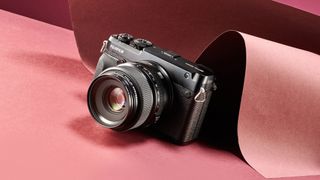
While we've seen a few camera launches in the early part of 2023, and we saw a lot toward the back end of 2022, camera stock has been still been a concern. And while things are slowly getting back on track, some of the bestselling cameras of the year so far will leave you scratching your head.
Camera retailer B&H Photo shared with us its 10 top-selling cameras of 2023, and it's quite the eye-opener. Some on the list seem like obvious candidates, thanks to their leaps in technological milestones, advances in autofocus, filmmaking, ISO, you name it. But I bet you didn't expect a 5-year-old camera to be on this list – and number 10 will leave you speechless!
So let's take a look at the list of the most popular cameras being bought right now in 2023…
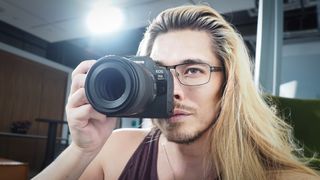
1. Canon EOS R6 Mark II
One of the best all-rounder cameras around, with class-leading AF
Type: Mirrorless | Sensor: Full frame CMOS | Megapixels: 24.2MP | Monitor: 3-inch fully articulating touchscreen, 1,620k dots | Continuous shooting speed: 12fps mechanical shutter, 40fps electronic shutter | Viewfinder: 0.5-inch OLED EVF, 3,690k dots, 100% coverage | Max video resolution: 4K 60p, 1080p 180p
The EOS R6 Mark II is the serious enthusiast's model of the EOS R series, taking the place of the slightly muddled EOS R, and for those who don't need the leading-edge tech and resolution of the EOS R5 (more on which below). The original Canon EOS R6 has been discontinued in favor of this new model, but that means that the best Canon EOS R6 deals are better than ever, making it a very covetable camera if you don't mind the slightly lower 20.1MP resolution and "slower" 20fps bursts.
The R6 Mark II's combination of speed, video, and low light capabilities gives it professional appeal, too. What you get here is a top shooting speed of 40fps, Canon 's mind-blowing Dual Pixel AF II with Deep Learning, up to 6K RAW video, and a 24.2MP image sensor with a standard ISO range of 100-102,400 that's expandable to 50-204,800. When you combine this with the introduction of Canon's 5-axis in-body image stabilization system, which provides up to eight stops of effective compensation, this is a seriously capable low-light camera. It's still pretty pricey, being relatively new and all, but EOS R6 Mark II is an amazingly capable all-rounder.
Read our full Canon EOS R6 Mark II review for more details

2. Sony A7 IV
A very powerful do-it-all camera at a sensible price
Type: Mirrorless | Sensor: Full frame | Megapixels: 33MP | Lens mount: Sony E | Screen: 3in vari-angle touchscreen, 1.04m dots | Viewfinder: EVF, 3.69m dots | Continuous shooting speed: 10fps | Max video resolution: 4K
The Sony A7 IV signals a step up in ambition for Sony 's vanilla A7 model. Traditionally, the Sony A7 has been the range’s entry-level camera, with the R models adding resolution and the ’S’ models adding speed/sensitivity. But there’s nothing ordinary about the Sony A7 IV, and while it does technically supersede the A7 III, it’s an altogether more advanced camera that, we think, targets a higher-level audience. Compared to the A7 III, the A7 IV is a major step up – but in price as well as features. The A7 III will keep going for now, so it makes for a tricky buying decision, not helped by the A7 IV's patchy availability. If you see one, get it!
Get the Digital Camera World Newsletter
The best camera deals, reviews, product advice, and unmissable photography news, direct to your inbox!
Read our full Sony A7 IV review

3. Fujifilm X-T5
The best Fujifilm camera with a traditional design
Type: Mirrorless | Sensor: APS-C X-Trans 5 HR BSI | Megapixels: 40 | Lens mount: Fujifilm X | Viewfinder: 3.69M-dot OLED EVF, 100fps refresh | Memory card: 2 x SD UHS-II | LCD: 3-inch tilting touchscreen | Max continuous shooting speed: 20fps | Max video resolution: 6.2K/30P | User level: Expert/professional
The Fujifilm X-T5 is the company's latest camera, and an evolution of the X-T series, rather than a revolution. It's a classically controlled SLR-style camera that is ideal for serious enthusiasts, thanks to the traditional dials on the top of the camera which will help you change ISO and shutter speed settings quickly.
The X-T5 takes the much-loved Fujifilm X-T4 further in terms of resolution but is still ideal for shooters who want a lightweight camera. It has an excellent 40.2MP sensor, 10-bit 4:2:2 video at 6.2K/30P, and a 3-way tilting touchscreen for flexible image composition. In terms of the way that it looks, feels, and handles, the X-T5 is in a class of its own, and it's currently several hundred pounds/dollars cheaper than the X-H2. See our comparison article: Fujifilm X-T5 vs X-H2 if you're not sure which is right for you.
For more details, see our full Fujifilm X-T5 review
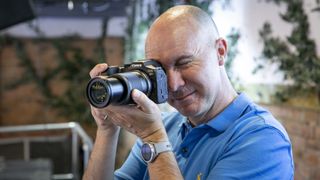
4. Canon EOS R7
An instant classic, meet Canon's best APS-C camera
Type: Mirrorless | Sensor: APS-C size | Megapixels: 32.5MP | Screen type: Articulating LCD, 1.62million dots | Viewfinder: 2.36m dot, 120fps | Maximum continuous shooting speed: 30fps electronic, 15fps mechanical | Max video resolution: 4K 60p
Not only is the Canon EOS R7 the manufacturer's finest APS-C camera to date, but it may also be the finest APS-C camera on the market period . It's lightning-fast both mechanically and electronically, the resolution offers glorious detail as well as the opportunity to crop into your shots, and the 1.6x crop factor makes your lenses even longer for shooting faraway subjects.
There's plenty of play in the files, giving you lots of leeway for post-production, and the video quality is crisp and clear in both 4K (whether its the 4K 60p or 7K-oversampled 4K 30p, with autofocus performance straight out of the R3 / R5 / R6 that won't let you down. On top of that, it accepts both the new line of RF-S (APS-C specific) lenses as well as the existing full frame RF optics. Throw in a joystick, fully articulating touchscreen and dual memory cards, and this is one of the best bang-for-buck Canon cameras out there.
Read our full Canon EOS R7 review for more details
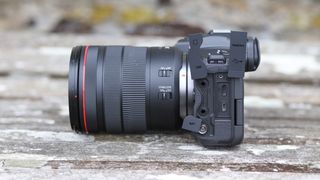
5. Canon EOS R5
The EOS R5's next-generation tech makes it a landmark camera
Type: Mirrorless | Sensor: Full frame CMOS | Megapixels: 45MP | Monitor: 3.15-inch fully articulating touchscreen, 2,100k dots | Continuous shooting speed: 12fps mechanical shutter, 20fps electronic shutter | Viewfinder: 0.5-inch OLED EVF, 5,690k dots, 100% coverage | Max video resolution: 8K DCI or UHD at 30p
The EOS R5 is a technological bombshell. It's Canon's new flagship mirrorless camera, and at first, glance seems to be trying to corner every segment of the market at once. It's got a brand-new 45MP sensor that produces images of incredible detail thanks to a new low-pass filter, as well as the class-leading autofocus system of the EOS-1D X Mark III, with a whopping 5,940 AF points for photography and 4,500 for video. Indeed, the EOS R5's video specs are nothing short of next-generation.
Uncropped 8K Raw video internally at up to 29.97fps in 4:2:2 12-bit Canon Log or HDR PQ (both H.265) in both UHD and DCI – this is a cinema-quality performance. But of course, there's a catch. You've likely heard about the pretty steep recording limits that afflict the EOS R5 when shooting both 8K and 4K. While firmware has been introduced to lessen the blow of this, there's no doubt that it's definitely a drawback to the EOS R5 as a professional video tool.
Read our full Canon EOS R5 review for more details

6. Sony A7R V
61 megapixels, 8K video, 10fps shooting and revolutionary AI AF
Type: Mirrorless | Sensor: back-illuminated APS-C Exmor R CMOS | Megapixels: 61MP | Monitor: Tilting/vari-angle touchscreen, 3.1-inch, 2,095k dot | Continuous shooting speed: 10fps | Viewfinder: 9,444k dot EVF, 0.9x magnification | Max video resolution: 8K 24p
Technically overwhelming, physically underwhelming – that’s how the A7R V feels. The camera body feels too small – or not tall enough in the body – for the big pro lenses you’ll be using with it, and the controls follow a generic layout rather than being adapted to this camera’s strengths. You can customize the buttons endlessly to suit the way you work, but that takes time and also a good memory for which button you’ve customized to do what.
Technically, the A7R V is stunning. With 61 megapixels paired with new AI subject recognition AF is remarkable, both for its rapid identification and acquisition and its very sticky ‘tracking’. The image quality is every bit as good as that of the A7R IV before it (Sony says it’s better), and the bigger buffer makes the A7R V much more effective for prolonged burst shooting.
Read our full Sony A7R V review for more details
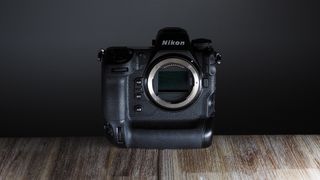
7. Nikon Z9
Nikon's fastest, most advanced camera yet blew us away and it's still getting better
Type: Mirrorless | Sensor: Full frame CMOS | Megapixels: 47.5MP | Monitor: 3.2-inch, 2,100k dot 4-axis tilting touchscreen | Continuous shooting speed: 20fps RAW (up to 1,000 buffer), 30fps hi-res JPEG, 120fps lo-res JPEG | Viewfinder: EVF, 3,690k dots, 100% coverage | Max video resolution: 4K UHD at 30p
Here, at long last, is the shot across the bows of Canon and Sony – the Nikon Z9 , the firm's latest pro mirrorless camera and a startling step forward for professional imaging. The Nikon Z9 boasts an intimidating set of features. It's capable of burst-shooting at a face-melting 120fps, for one, and its buffer can record a nominal 1,000 images per burst, with Nikon recording it being capable of as many as 5,000 when used with a high-spec CFExpress card.
It also uses deep-learning AF, meaning its focusing ability should get better over time, and the back-side illuminated sensor delivers superior low-light performance. However, several of its headline features, like 8K 60p video and the compressed high-efficiency N-RAW format, are not going to be available at launch but will come in a firmware update expected later in 2022. Nikon is not the only manufacturer doing this, but it's still a trend we're not fans of.
Read our full Nikon Z9 review for more details
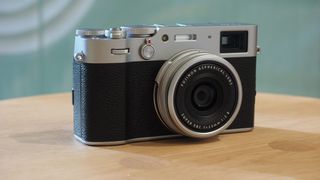
8. Fujifilm X100V
Blending retro charm with modern tech, our reviewer loved it so much they bought one!
Sensor: APS-C | Megapixels: 24.3MP | Lens: 23mm f/2 | Monitor: 3in fixed, 1,620,000 dots | Viewfinder: Hybrid optical/EVF | Continuous shooting: 11fps | Max video resolution: 4K UHD
The Fujifilm X100V is styled like a classic rangefinder camera and is the latest model in a highly successful line. It has a new, sharper lens than previous X100 models, in order to do full justice to the latest sensor, and the tilting touchscreen on the back makes this camera much easier to use at awkward angles, without compromising its slimline design. The improved autofocus and 4K video capabilities bring this classic camera design right up to date.
The X100V has external lens aperture, shutter speed, and ISO dials which, for those raised on film cameras like much of the DCW team, are just wonderful to use – and it's amazing how they encourage all the key exposure skills we still need but which are easily forgotten about with 'P' modes and digital interfaces. It also has a clever hybrid optical/digital viewfinder which is not just super bright and clear but lag-free too.
Read our full Fujifilm X100V review for more details

9. Canon PowerShot SX740 HS
An oldie, but today is still a great point and shoot compact
Sensor: 1/2.3" | Megapixels: 21MP | Lens: 24-960mm (35mm Equivariant) | Monitor: 3in Tilting LCD, 922,000 Dot | Continuous shooting: 10fps | Max video resolution: 4K UHD
Even though the PowerShot SX740 HS Digital Camera is a 5-year-old camera, it can still pack a lunch and be a great companion while out and about or on holiday. Few things will be too far away for the PowerShot SX740 HS, which boasts a 20.3MP CMOS sensor and 40x optical zoom in an all-in-one point-and-shoot package.
It can capture things near and far, helped by its 24-960mm zoom range (35mm equivalent) and optical image stabilization that keeps your photos and videos sharp and in focus. The handy PowerShot also features Canon's Zoom Framing Assistant, which makes it easier to track subjects at the long end of the focal length by quickly zooming out and then back in at the press of a button once you've located your subject.
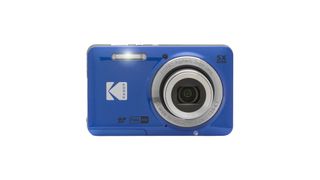
10. Kodak Pixpro FZ55
An easy to use point and shoot with a tiny price tag
Sensor: 1/2.3" | Megapixels: 16MP | Lens: 28-140mm (35mm equivariant) | Monitor: 2.7" LCD Screen | Max video resolution: 1080p
There was a time when Kodak was on the top of everyone's list, but the good old days are gone and Kodak is just a glimmer of what it once was. However, could Kodak be back with this compact? The Kodak Pixpro FZ55 is a small and easy-to-use compact digital camera. This point-and-shoot features a 28mm wide angle lens with zoom up to 140mm (in 35mm equivariant) and boasts a slightly long-in-the-tooth 16MP 1/2.3" CMOS sensor and a 2.7" fixed LCD screen.
However, what it might lack in top-of-the-range features it makes up for with a very cheap price tag and nostalgia vibes. The Pixpro FZ55 also has multiple flash and shooting modes, along with a variety of detection features, including face and smile detection – on a camera that only costs $99! This handy compact camera is a great choice for photographers who simply want a cheap point-and-shoot to take with them while leaving the expensive kit at home.
This list might be an eclectic mix, and we're not sure what it says about us all as photographers, but it is no surprise to see brand-new cameras and highly sought-after ones on this list from B&H.
However, what is surprising is seeing the cameras well past their 'sell-by date' in terms of technology making the list – and who would have thought a Kodak product would be on there!
If this article has been insetting why not take a look at our best professional cameras , best compact cameras , and best travel cameras .
Thank you for reading 5 articles this month* Join now for unlimited access
Enjoy your first month for just £1 / $1 / €1
*Read 5 free articles per month without a subscription
Join now for unlimited access
Try first month for just £1 / $1 / €1
For nearly two decades Sebastian's work has been published internationally. Originally specializing in Equestrianism, his visuals have been used by the leading names in the equestrian industry such as The Fédération Equestre Internationale (FEI), The Jockey Club, Horse & Hound, and many more for various advertising campaigns, books, and pre/post-event highlights.
He is a Fellow of The Royal Society of Arts, holds a Foundation Degree in Equitation Science, and is a Master of Arts in Publishing. He is a member of Nikon NPS and has been a Nikon user since the film days using a Nikon F5 and saw the digital transition with Nikon's D series cameras and is still to this day the youngest member to be elected into BEWA, The British Equestrian Writers' Association.
He is familiar with and shows great interest in street, medium, and large format photography with products by Leica, Phase One, Hasselblad, Alpa, and Sinar. Sebastian has also used many cinema cameras from the likes of Sony, RED, ARRI, and everything in between. He now spends his spare time using his trusted Leica M-E or Leica M2 shooting Street photography or general life as he sees it, usually in Black and White.
Related articles

- Mattress & Sleep
- Kids & Baby Gear
- Beauty & Grooming
- Tech & Electronics
The Best Travel Purses, From Chic Shoulder Bags To Packable Crossbodies
- Share to Facebook
- Share to Twitter
- Share to Linkedin
The best travel purses are stylish, lightweight and can hold and organize essential items without feeling cumbersome. We spent hours researching options from a variety of brands to find the very best travel purses; our winner is the MZ Wallace Small Sutton Deluxe , which is made from a durable and waterproof material and has eight useful pockets. We also evaluated purses from lululemon , Baggu , Cuyana , Lo & Sons and more to help you find the best option for your needs.
The best travel purses are durable, versatile, and can hold and organize essential items.
Before making a purchase, consider your travel purse’s primary use. Outdoor enthusiasts might want a water-repellent option , while travelers seeking a day-to-night bag might prefer a leather purse . It’s also helpful to evaluate the bag's size, weight, interior organization and security features, which can be especially important if traveling internationally. Below, the best travel purses of 2024.
- Best Travel Purse Overall: MZ Wallace Small Sutton Deluxe
- Best Affordable Travel Purse: Uniqlo Round Mini Shoulder Bag
- Best Crossbody Travel Purse: Lululemon Everywhere Crossbody Bag
- Best Anti-Theft Travel Purse: Travelon Anti-Theft Classic Mini Shoulder Bag
- Best Leather Travel Purse: Cuyana Double Moon Saddle Bag
- Best Sling Bag For Travel: Lo & Sons Bond Bag
- Best Small Travel Purse: Baggu Mini Nylon Shoulder Bag
- Best Large Travel Purse: Coach Lana Pebble Leather Shoulder Bag
Best Travel Purse Overall
Stylish, waterproof and great for organization, mz wallace small sutton deluxe.
I am a commerce editor for Forbes Vetted covering beauty, fashion, travel and home. Prior to joining Forbes, I held positions at BuzzFeed and Dotdash Meredith where I was responsible for curating lifestyle content and testing products for real-world insights. My work has appeared in Women’s Health, Men’s Health, BuzzFeed, Brit + Co, Everyday Health and more. I hold a Bachelor’s Degree in English/Creative Writing from Marist College and currently reside in Brooklyn, New York.
For product reviews, gift ideas, and latest deals, Subscribe to the Forbes Finds newsletter .
Dimensions: 9.8 x 5.5 x 10.2 inches | Weight: 1.1 pounds | Colors: 19 total | Materials: Rec Oxford, leather trim
- Durable and waterproof exterior
- Eight pockets
- Detachable, adjustable crossbody strap
- Exterior pockets are not zippered
The MZ Wallace Small Sutton Deluxe earned the top spot on our list thanks to its compact size, well-organized interior and stylish yet durable design. It’s crafted from Rec Oxford fabric and has a padded, almost quilted appearance. The material is waterproof, so you won’t have to worry about the exterior if caught in the rain. There are eight pockets total (six on the inside and two on the outside) to keep you organized on the go, and the main compartment is spacious enough to fit a water bottle, book, passport, wallet, phone, sunglasses and more. Other helpful features include a zip top closure to keep everything secure, a detachable crossbody strap, a phone pocket and a key ring strap.
Best Affordable Travel Purse
Compact, adjustable and under $20, uniqlo round mini shoulder bag.
Dimensions: 11 x 6.7 x 3.9 inches | Weight: Not listed | Colors: 12 total | Materials: Nylon shell and polyester lining
- Adjustable strap
- Two interior pockets
- Water-repellent finish may wear off over time
If you’re looking for an inexpensive option that you won’t have to be too precious with, we recommend the Uniqlo Round Mini Shoulder Bag. It’s shaped like a half-moon and has an adjustable strap to ensure a secure fit. The 100% nylon fabric has a slightly crinkled effect and is treated with a water-repellent finish (although the manufacturer does note that it may wear off over time). There are also two smaller pockets inside for stashing smaller items like a backup charger and wallet. Although the construction is not as thick or durable as our top pick, it’s a great choice if you’re on a budget or want several different colors for variety.
Best Crossbody Travel Purse
Practical, sporty and water-repellent, lululemon everywhere crossbody bag.
Dimensions: 7.7 x 3.1 x 5.3 inches | Weight: Not listed | Colors: 2 total | Materials: Nylon body and recycled polyester lining
- Water-repellent fabric
- Removable, adjustable crossbody strap
- Large exterior zippered pocket
- Limited color options (rose blush/silver and bone/silver)
Crossbody bags allow you to go hands-free when traveling and provide enough room for all your essentials without feeling bulky. This iteration from Lululemon has a removable, adjustable crossbody strap, silver hardware, and multiple pockets to stay organized. The exterior pocket zips close to keep your belongings secure, and the back slip pocket keeps your iPhone handy so you can whip it out when you need to make a call. Its casual look makes it best suited for everyday adventures rather than dressier occasions.
Best Anti-Theft Travel Purse
Rfid blocking pockets and slash-resistant straps, travelon anti-theft classic mini shoulder bag.
Dimensions: 8.5 x 8.5 x 2.3 inches | Weight: 0.90 pounds | Colors: 12 total | Materials: Slash-resistant nylon
- Slash-resistant body and strap
- RFID-blocking pockets and card slots
- Fun colors and patterns to choose from
- Design isn’t as stylish as other options
For international trips or getaways to busy locales, you might feel more secure choosing a purse with anti-theft features. The Travelon Anti-Theft Classic Mini Shoulder Bag stands out among the competition for its many security components, durable materials and uncluttered design. It’s made from slash-resistant nylon, and the strap has a stainless steel wire that runs through it, so thieves can’t cut it. The bag’s main compartment has an organizer with RFID-blocking pockets and the front zippered pocket locks to keep your valuables secure. Plus, it’s easy to wipe down with a damp cloth when it gets dirty. Reviewers say it’s the perfect size for travel, and it doesn’t feel too bulky or cumbersome, even when filled.
Best Leather Travel Purse
Elegant and well-made, cuyana double moon saddle bag.
Dimensions: 7 x 8.5 x 3.5 inches | Weight: 1.1 pound pounds | Colors: 3 total | Materials: Italian pebbled leather
- Made from genuine leather
- Two spacious main compartments
- Add-on accessories cost more
Cuyana is known for its sleek, modern pieces made from gorgeous Italian leather—and this saddle bag is no exception. The pebbled leather is buttery soft, and the elegant shape can be dressed up or down, depending on the occasion. There are two main compartments—each with its own flap—and a back slip pocket for anything you need quick access to. Both compartments have a magnetic closure, so you won’t have to fumble with zippers when you’re out and about. You can further customize your bag with add-on accessories like an AirPod Case or cardholder .
Best Sling Bag For Travel
Spacious and sleek.
Lo & Sons
Lo & Sons Bond Bag
Dimensions: 9.3 x 4.5 x 2.5 inches | Weight: 1.2 pounds | Colors: 3 total | Materials: Sheepskin leather
- Converts to a fanny pack
- Interior key leash and three mesh pockets
- TSA-approved lock can be used with the zippers
- Only three color options
Whether you’re planning to shop, hike or catch a live show during your upcoming travels, the Lo & Sons Bond Bag is a great companion. This sling bag will keep your hands free, and its main compartment typically swings to the front of your body, keeping your belongings safe and secure. The main body has three mesh pockets and one zippered pocket with three built-in card slots, so you don’t have to carry a wallet. There’s also a handy key leash and exterior pocket for your phone.
I’ve owned this bag for over a year and constantly reach for it, whether I’m headed to a sports game, outdoor concert or casual lunch with friends. It looks sleek no matter what I wear it with and is surprisingly spacious for a sling bag.
Best Small Travel Purse
Compact and easily washable, baggu mini nylon shoulder bag.
Dimensions: 6 x 9 x 2.8 inches | Weight: Not listed | Colors: 13 total | Materials: Recycled heavyweight nylon, recycled ripstop nylon lining
- Adjustable, quilted strap
- Made from recycled, washable nylon
- One interior zip pocket
- May not hold up to years of frequent wear
- Lighter colors, like Dove, are a bit see-through
If you’re looking for a compact shoulder bag that’s functional but still stylish, the Baggu Mini Nylon Shoulder Bag is an excellent pick. It has a structured body that can stand on its own, and it’s made from recycled heavyweight nylon that can be machine-washed. (It’s the only bag on our list that’s washable.) The capacity isn’t huge, but it feels spacious for a smaller bag and works well for everyday use. Customers also appreciate the fun color options and say it’s incredibly lightweight.
Best Large Travel Purse
Three sizable compartments for all your belongings.
Neiman Marcus
Coach Lana Pebble Leather Shoulder Bag
Dimensions: 20.1 x 13.1 x 7.3 inches | Weight: Not listed | Colors: 3 total | Materials: Polished pebble leather, fabric lining
- Made from polished leather
- Three distinct interior compartments
- Protective feet on bottom of bag
- Strap is not adjustable
Easily the largest bag on our list, the Lana Shoulder Bag is a beautifully crafted travel purse that can hold sizable items like an iPad, MacBook Air or an extra pair of shoes. It’s made from pebble leather with a layer of gloss that gives it a stylish sheen, and its flat shoulder strap has a ten-inch drop. Inside the bag, two distinct compartments are divided by a zippered pouch in the middle (within the zippered compartment, there’s also a smaller slip pocket). The two main compartments are ideal for storing a book, electronics, a water bottle, a sweater and other bulky essentials. Although it’s the most expensive bag we highlighted, it’s a well-made investment piece that will last a lifetime.
The Best Things To Buy At Abercrombie & Fitch, According To Our Review
Best labor day clothing sales: shop 70 fashion deals on madewell, athleta and more, why trust forbes vetted.
- The Forbes Vetted team consists of avid travelers who are passionate about sharing their luggage shopping tips with readers. We’ve published dozens of in-depth roundups on travel products , including the best travel totes , best weekender bags and more.
- This article was overseen by senior travel editor Astrid Taran , who has used travel purses on countless trips to more than 35 countries. Two of her favorite travel purse brands are MZ Wallace and Cuyana .
- Katherine Louie , the author of this piece, is a lifestyle editor with extensive experience covering travel and lifestyle topics. She owns the Lo & Sons Bond Bag and uses it constantly, whether traveling internationally or heading on an outdoor excursion.
- This story is regularly checked to ensure that all prices and information are as current as possible.
How We Chose The Best Travel Purses
To find the best travel purses, we researched dozens of best-selling options, compared features and asked our team of experienced staffers for insights.
- We relied on expert advice, independent reviews, research and personal experience to make our recommendations. Louie has over a decade of firsthand experience testing bags, shoes, and other accessories and personally used one of the bags on this list. She also spent more than seven hours researching the best options on the market before making her final selections.
- We analyzed several important features, including dimensions, weight, materials, available color options and interior organization, to help readers pinpoint the best option for their needs.
- The final products on this list reflect in-depth research conducted by our writer and meticulous vetting by the editorial team.
Frequently Asked Questions (FAQs)
What is the safest type of purse to travel with.
Generally, crossbody bags are safer when traveling as they can’t be grabbed off your arm or shoulder. Look for bags made from thick, sturdy materials—such as leather—which make it harder for thieves to slash. The safest travel purse on our list is the Travelon Anti-Theft Classic Mini Shoulder Bag because it’s constructed from slash-resistant nylon, and the strap has a stainless steel wire that runs through it. There are also RFID-blocking pockets inside to keep your credit cards secure.
What Kind Of Travel Bag Is Suitable For Short Trips?
All the bags we highlighted on this list are suitable for short trips. They can hold the essentials without feeling heavy or bulky. If you need to pack a few more items (or want to leave room for souvenirs on a day trip), the Coach Lana Shoulder Bag is the largest bag we recommend. It has three spacious compartments and a comfortable, wide shoulder strap.
What Color Bag Is Best For Travel?
While the type of travel purse you buy largely depends on personal preference, dark colors are better at hiding stains and spills. Neutral colorways—like black, tan, grey and white—are also good choices because they’re easy to pair with any outfit.
More Travel Stories To Shop
- Best Travel Totes
- Best Weekender Bags
- Best Travel Backpacks For Women
- Best Crossbody Bags For Travel
- Best Travel Outfits For Women

- Editorial Standards
- Forbes Accolades

IMAGES
VIDEO
COMMENTS
The Fujifilm X-S20 is a camera made for hybrid shooters, with great quality stills, but is set apart by its deceptively powerful video skills. This makes the X-S20 the perfect travel camera for any creator who is a versatile and lightweight camera that won't break the bank. 6. Olympus OM-D E-M10 Mark IV.
OM SYSTEM Tough TG-7 Black Underwater Camera. It's tough and effective. Divers should be aware that the waterproofing level only goes to 50 feet. The upgraded Olympus Tough TG-7 is exactly what it ...
1. Sony a7C II. The original a7C was an excellent travel photography camera in its own right, thanks to the full-frame sensor and compact body - but the Sony a7C II, which debuted in the fall of 2023, is even better than its predecessor. Sony's latest full-frame offering is an all-around great camera, but travel photographers in particular ...
5.9. Body Type SLR-Style. Mirrorless Yes. Sensor Size 4/3 (MFT) See all our test results. The OM SYSTEM OM-5 is the best digital camera for travel that you can get. As part of the Micro Four Thirds (MFT) system, it offers a balanced mix of portability, ruggedness, and image quality. Though it isn't as heavy-duty as higher-end models like the OM ...
6.9. Body Type SLR-Style. Mirrorless Yes. Sensor Size APS-C. See all our test results. Among mirrorless options, the Fujifilm X-T5 stands out as one of the best cameras for travel photography. It's aimed at enthusiast photographers, with old-school exposure dials that make it easy to adjust settings on the go.
Combining a small form factor with a high-res 61MP sensor and fantastic autofocus, the Sony A7C R is the best full-frame camera for travel photography. 8. Fujifilm X-S20. A capable sensor and ...
Best pocketable travel camera: Ricoh GR III. 24MP APS-C sensor | 28mm equiv. F2.8 lens | Wi-Fi + Bluetooth. The Ricoh is a pocketable compact with a large APS-C sensor. Photo: Barney Britton. Buy now: $997 at B&H Photo $997 at Adorama $1016 at Amazon.
Best DSLR Camera for Travel: Canon Rebel, a reliable DSLR camera that offers great image quality and user-friendly controls. Best Smartphone for Travel Photography: iPhone 13 Pro Max, a powerhouse smartphone with advanced camera capabilities, ideal for capturing stunning travel photos. Best Underwater Camera for Travel Photography: GoPro ...
These are the best travel cameras available, no matter what you are looking for. Best overall: Sony Cyber-shot DSC-RX100 VII. Best action camera: GoPro HERO11 Black. Best 360 camera: Insta360 X3. Best mirrorless: Fujifilm X -T5. Best mirrorless on a budget: Canon EOS R100. Best for video: Sony ZV-E1.
As of 2024, Sony's top cameras are the A1, A7iv, A7Siii, A7Rv and the A9ii. Now while the A9ii, A7Rv and A1 are absolute beasts of cameras, the truth is you most likely don't need all the features they have. We currently own the A7iv and A7Rv, and for professional travel photography, they are the best on the market.
11 fps. Video. Video. Screen Size. Screen Size. 3". The Fujifilm X100V is a compact mirrorless camera and one of the best choices for travel photography. The 26 MP APS-C sensor gives you high-resolution images. And the autofocus performance is outstanding, working well even in low-light situations.
The Sony A6600 is an excellent choice for beginner photographers looking to take their travel photography to the next level. The camera features a 24.2 megapixel APS-C image sensor and a BIONZ X image processor, which combine to deliver high-quality images with minimal noise. Overall.
Recent Updates. Jul 30, 2024: We replaced the RICOH GR III with the Fujifilm X100VI as the 'Best Large Sensor Compact Camera For Travel' since it offers more features, but we've kept mention of the RICOH as a more portable alternative. Jun 04, 2024: We replaced the Canon PowerShot G5 X Mark II with the Canon PowerShot G7 X Mark III as the mid ...
The best mirrorless camera for travel should be portable but still produce eye-catching media. This is why the Nikon Z50, Canon EOS R8, and Fujifilm X100V are our top three recommendations. Traveling is always a huge source of inspiration. And to capture the wondrous sights in all their glory, you need a reliable camera.
Best camera for wildlife photography: OM System OM-1 OM System's OM-1 camera can shoot up to 50 frames per second—faster than most video cameras, making it a top pick for capturing wildlife.
Key Highlights. Mirrorless cameras are the best choice for travel photography, offering portability and advanced features. Sony Alpha 7C is a versatile option with intuitive controls, high-resolution sensor, and impressive autofocus for both beginners and experienced photographers.; Sony a7R IV is a powerful full-frame mirrorless camera with outstanding image quality, advanced autofocus, and ...
But to use this camera is to get a glimpse into the future of photography. A camera with no mirror, no mechanical shutter, no rolling shutter, and effectively no limit on sync speed. The Sony A9 III is the best camera of 2023. And its trickle-down technology is going to make the cameras in 2024 and beyond even better than they would have been.
Best Overall: Sony Cyber-shot DSC-RX100 VII Digital Camera at Sony.com. Jump to Review. Best Image Quality: RICOH GR IIIx Digital Camera at Amazon $1,100. Jump to Review. Best Full-frame Compact ...
Sony RX100VII. Best for: Speed and accuracy in a tiny package. Thanks to new sensor technology, this Sony model can shoot 20 frames per second with virtually no image distortion. Despite being ...
Best Camera for Landscape Photography: Sony a7R V. Best Camera for Wildlife Photography: Sony Alpha 1. Best Camera for Travel Photography: Canon EOS R6 Mark II. Best Camera for Portrait ...
Camera retailer B&H Photo shared with us its 10 top-selling cameras of 2023, and it's quite the eye-opener. Some on the list seem like obvious candidates, thanks to their leaps in technological milestones, advances in autofocus, filmmaking, ISO, you name it. ... and best travel cameras. Thank you for reading 5 articles this month* Join now for ...
The best travel outfits for women blend comfort with style, prioritizing moisture-wicking fabrics that feel light and breathable but still look polished. After ranking our favorites—including ...
The best travel purses are stylish, lightweight and can hold and organize essential items. Our top picks for 2024 include bags from MZ Wallace, Cuyana, Baggu and more.